The Story of Indian Springs Holiness Camp

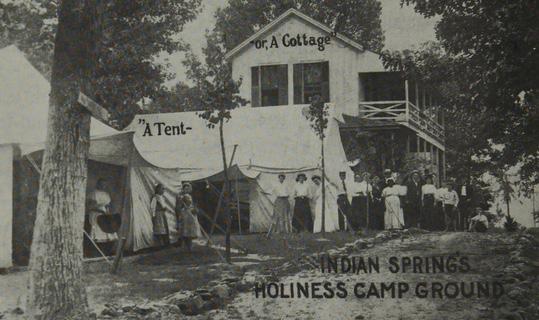 Dr. Z.T. Johnson
Dr. Z.T. Johnson
ISBN: 9781648171703
The story of Indian Springs Holiness Camp, 1890-1965
By Z. T. Johnson First Fruits Press, ©2023
Digital version at https://place.asburyseminary.edu/firstfruitsheritagematerial/214/
First Fruits Press is a digital imprint of the Asbury Theological Seminary, B.L. Fisher Library. Asbury Theological Seminary is the legal owner of the material previously published by the Pentecostal Publishing Co. and reserves the right to release new editions of this material as well as new material produced by Asbury Theological Seminary. Its publications are available for noncommercial and educational uses, such as research, teaching and private study. First Fruits Press has licensed the digital version of this work under the Creative Commons Attribution Noncommercial 3.0 United States License. To view a copy of this license, visit http://creativecommons.org/licenses/by-nc/3.0/us/.
For all other uses, contact:
First Fruits Press
B.L. Fisher Library
Asbury Theological Seminary
204 N. Lexington Ave.

Wilmore, KY 40390
http://place.asburyseminary.edu/firstfruits
Johnson, Z. T. (Zachary Taylor), 1897-1981.
The story of Indian Springs Holiness Camp, 1890-1965 [electronic resource]/ Z.T. Johnson. – Wilmore, Kentucky : First Fruits Press, ©2023.
1 online resource (111 p. : port.) : digital.
Reprint. Previously published: Wilmore, KY : Asbury College, [1965?]
ISBN: 9781648171598 (paperback)
ISBN: 9781648171703 (uPDF)
ISBN: 9781648171710 (Mobi)
OCLC: 1366295424
1. Indian Springs Holiness Camp--History 2. Camp meetings Georgia. I. Title. II. Indian Springs Holiness Camp.
BV3799.I5 J6 2023eb
Cover design by April Hardman
First Fruits Press e Academic Open Press of Asbury eological Seminary 204 N. Lexington Ave., Wilmore, KY 40390 859-858-2236
asbury.to/ rstfruits
rst.fruits@asburyseminary.edu
The Story of INDIAN SPRINGS HOLIN: ~r;~AMP
 By Z. T. JOHNSON, Ph.D., L.L.D., D.D.
By Z. T. JOHNSON, Ph.D., L.L.D., D.D.
Asbury College
Wilmore, Kentucky
1890
1965

FOREWORD
When the writing of this book was begun, the author had every reason to believe that he would have access to many of the old records of the Indian Springs Camp Meeting Board of Trustees. The thought was to write a human interest story of the camp meeting but have it well authenticated by the documents kept by the officials.

You could imagine the dismay that came when it was discovered that most of the records had been burned in a fire in the home of Dr. J. M. Glenn, and that records for more than half of the life of the Camp were not available. A search began for old documents.
It was possible to read about twenty-two years of Minutes and to find a brief sketch annually in the Jackson newspaper. But it was impossible to get accurate documentary evidence except that found in this volume.
Historically, the year 1890 was one of great significance to the holiness movement of America. It was in that year that three great institutions came into existence. The first was Indian Springs Camp Ground which started in August of that year. The other two were Asbury College and The Pentecostal Herald.
Asbury College was founded in Wilmore, Kentucky, by John Wesley Hughes, a member of the Kentucky Conference, who sought to build an institution primarily for the education of Christian workers who would be thoroughly trained in the sound doctrines as taught by John Wesley and his immediate followers.
In that same year, Dr. H. C. Morrison started The Pentecostal Herald in Frankfort, Kentucky. He also was a member of the Kentucky Conference of the Methodist Church, but decided to leave the pastorate and enter the field of evangelism, primarily for the promotion of holiness from the Wesleyan viewpoint.
3
The Pentecostal Herald was to be his main source of promotion throughout the years, not only for evangelism but later for Asbury College; Indian Springs Camp Meeting; and in his latter years, Asbury Theological Seminary.
These three institutions have been bound together by common interest in the propagation of scriptural holiness and in the training of Christian workers for world-wide service. Each has made its contribution in its own particular way.
The story of Indian Springs Camp, therefore, has to be one mainly of "human interest" rather than one of historic accuracy. The author has done the best he could with the materials he could find, with the sincere hope that "the spirit of Indian Springs Holiness Camp Meeting" will ever remain on the high plane which it has occupied for seventy-five years.
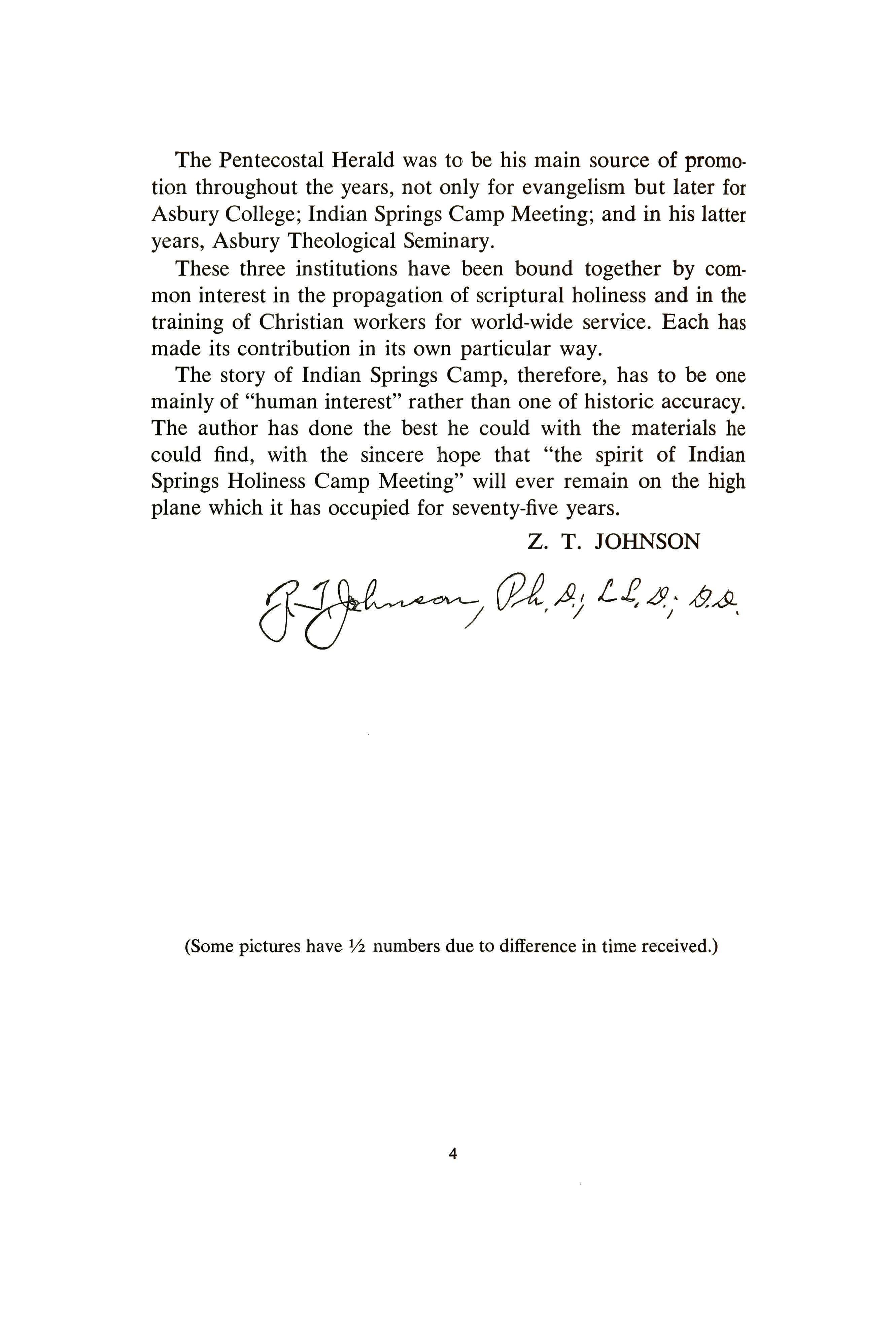 Z. T. JOHNSON
Z. T. JOHNSON
4
(Some pictures have½ numbers due to difference in time received.)
CHAPTER I
THE SEARCH
It is Christmas week, 1889. Five men are walking slowly through a beautiful, wooded section, intent in their search for a place to establish a camp meeting.

The woods are resplendent with the changing hues of the giant oak tree leaves. The brown cones still hang on the green pines, many of them standing majestically tall among the towering oaks. The ground is carpeted with fallen leaves and a few pine cones here and there. These men stopped at various points and at every site they thought feasible, prayed God to overrule and change their choice if He saw best.
Four of these men were representatives of two holiness associations which held special holiness meetings by invitation of pastors (mostly Methodist) in north and south Georgia. They were W. A. Dodge, H. A. Hodges, J. H. Curry, and George W. Mathews.
The fifth man was a Baptist layman who helped found the Baptist Church in Flovilla and was recognized as one of the outstanding citizens of Butts County for many years. Captain Smith was showing this group of men various possible sites with the idea of helping promote the meeting they were suggesting.
The site finally selected was one about halfway between Flovilla, Georgia, and Indian Springs, even then a famous health resort just two miles away. (See Picture #1.)
The town and Springs were connected by a "dummy" railroad which for many years carried most of the camp meeting folk from the railroad station at Flovilla to the camp ground a mile away.
THE PRAYER
When the men came to the spot where the huge oak still stands near the tabernacle, they knelt to pray the usual prayer that God would overrule them if this were not the choice. After the prayer, they all felt that this was indeed the place and so testified to each other. (See Picture of Dedication.)
5

6
The picture showing visitors to Indian Springs after it was housed when it became an official state park. Note that it is only one spring. (Picture # 1.)
This picture shows a group around the memorial plaque near the big oak tree where the prayer meeting was held when Indian Springs Camp was finally decided upon. In the picture are several people the writer does not recognize, but prominent ones indicated, are: E. Clay Milby; Mr. H. W. Pittman, standing in the center with arms folded, for whom the Pittman Annex is named; Mrs. George W. Mathews, standing by the chair; Dr. J. C. McPheeters, standing by the tree.
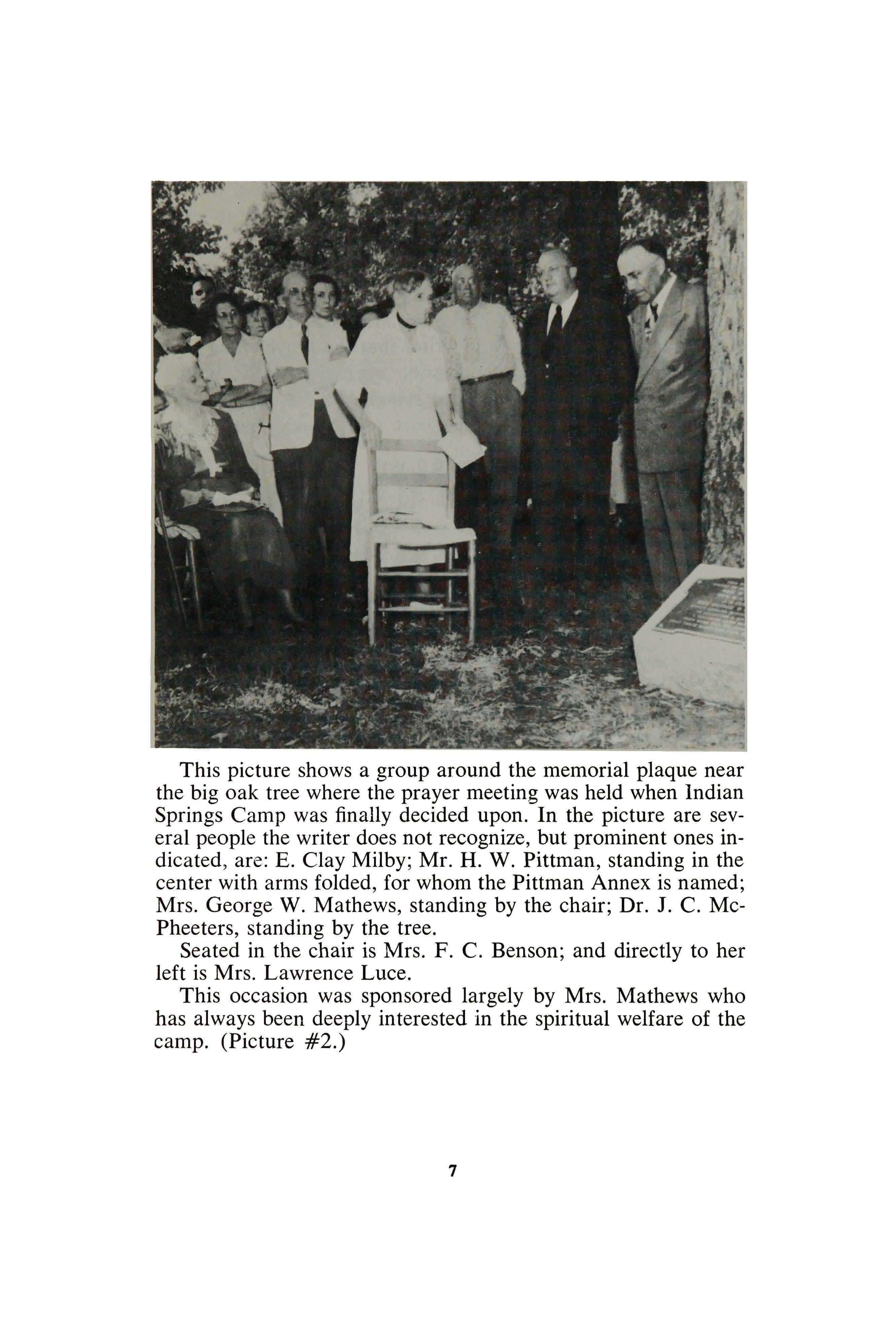
Seated in the chair is Mrs. F. C. Benson; and directly to her left is Mrs. Lawrence Luce.
This occasion was sponsored largely by Mrs. Mathews who has always been deeply interested in the spiritual welfare of the camp. (Picture #2.)
7
Captain Smith was so impressed by the earnestness, the sincerity, and devout attitude of these men that he decided to see to it that the ten acres of ground would be bought from the Douglas estate and made available. He and other friends decided to purchase it and give it to the camp ground association.
Mrs. Alice Thompson, with her sister, still lives on the edge of Flovilla. They informed the writer that the prayer these men prayed made such a great impression upon their father that it squarely behind the movement to establish the camp meeting. prompted the generosity on his part and caused him to get
THE PURPOSE
The two holiness associations united into "The Georgia Holiness Association," which was comprised of people in the experience of perfect love or those who were seeking the same, all of whom believed in the Wesleyan doctrine of entire sanctification. It was this group which sent a special committee to select the site for the camp meeting.
The avowed purpose of these men and the holiness association backing them was to hold camp meetings expressly for the purpose of "the exclusion of all teaching not vital to the doctrine of entire sanctification, and by the employment of the best teachers of this truth to be found in the land."
One of the primary reasons for the location of the Indian Springs Camp Ground was the fact that it was about halfway between Macon and Atlanta, and between Athens and Columbus, thus making it easily accessible to all parts of Georgia. As a matter of fact, it is not far from the center of the State.
"THE DUMMY"
Another reason for this location was that it was within a mile of the Southern Railroad which went through Jackson and Flovilla, Georgia, and within a mile of Indian Springs which was a famous health resort at that time. (See Picture #3.)
Captain Smith and George Elder promoted the building of the "dummy railroad" and built it to serve people who would come to Flovilla and go to Indian Springs. The selection of the

8
This is a good picture of the Dummy engine and one of the cars which ran from Flovilla to Indian Springs. ; The Dummy ceased running in 1916, but was not finally sold for scrap until 1918. During the course of its lifetime, it hauled thousands of people who attended Indian Springs camp meeting and thousands more who went to the Indian Spring health resort a mile away. (Picture #3.)
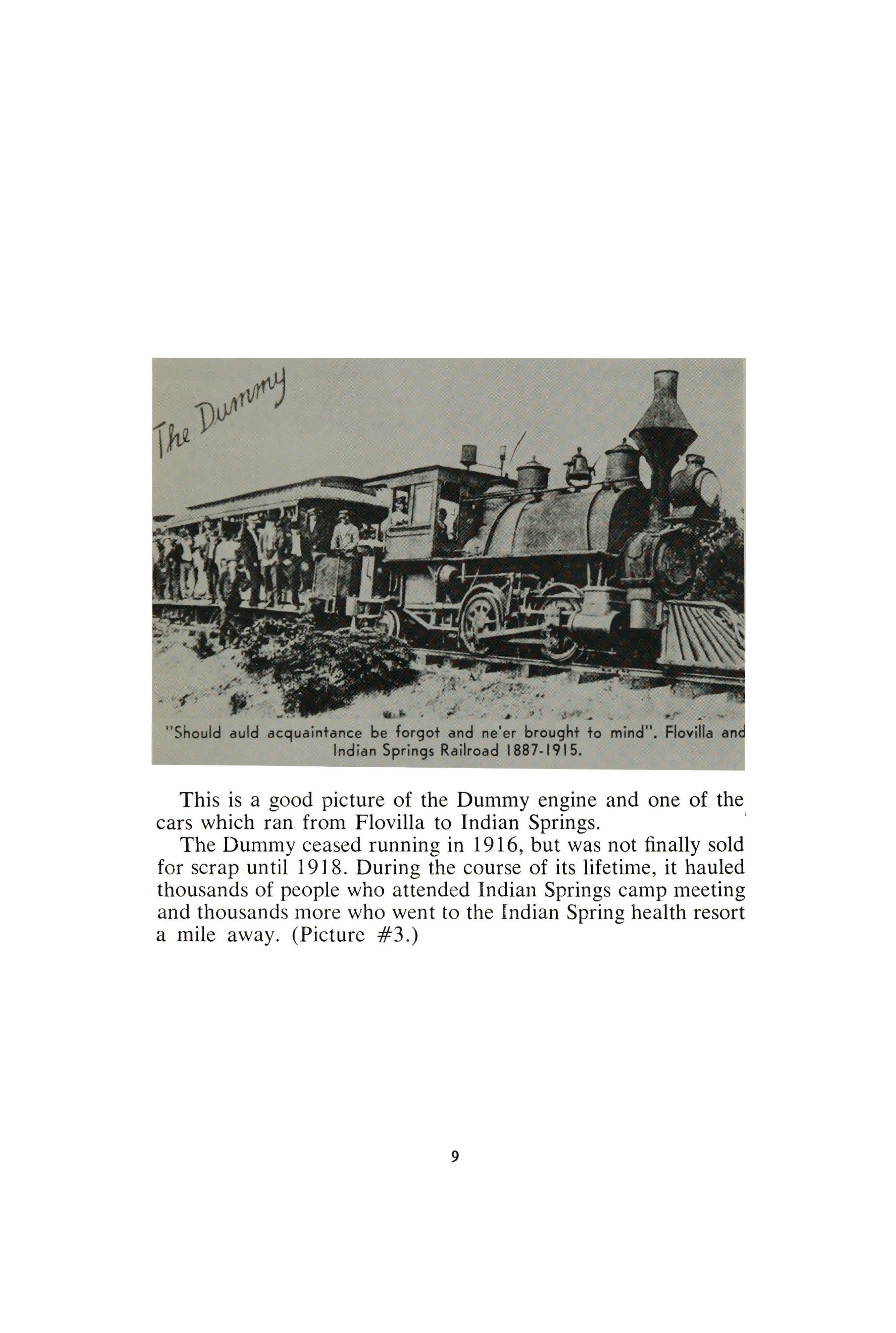
.. .. .
"Shouldauld acquaintancebe forgot and ne'er brought to mind". Flovillaan Indian SpringsRailroad 1887-1915.
9
Indian Springs camp meeting site, therefore, caused its front gate to be about in the center of this railway which until 1916 carried thousands of passengers to the camp ground.
The dummy consisted of two engines and six passenger cars. It operated from about 1890 until about 1916 when it was sold for scrap during World War I. The writer was told that it brought more for scrap than the original cost of the railroad when it was built.
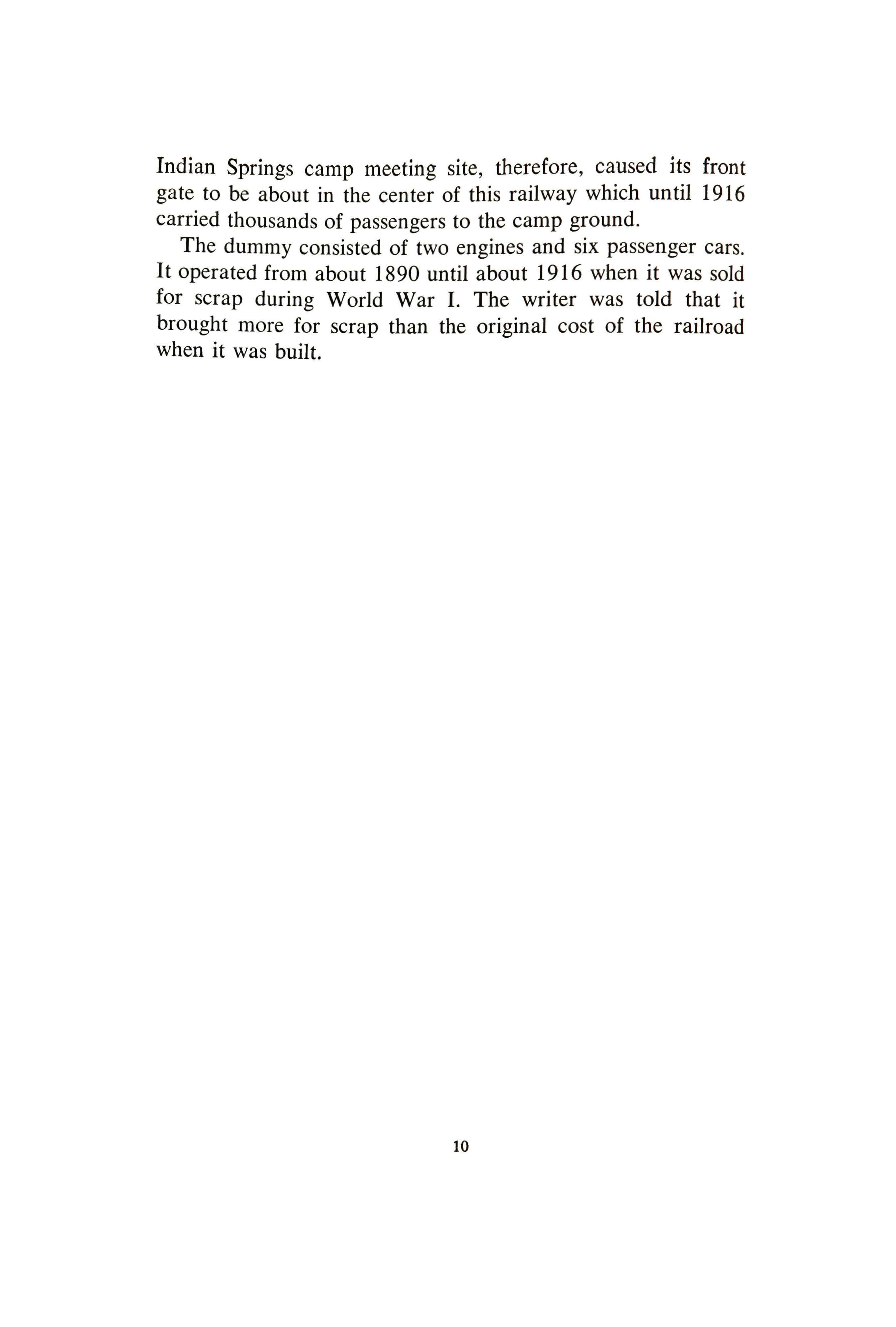
10
CHAPTER II
THE BEGINNING
The first camp meeting really was made possible as the result of a holiness association meeting held in the Spring of 1890, at Ashburn, Georgia, the county seat of Turner County. This was a small sawmill town with abundance of lumber, and much of the lumber and building materials came from friends in that town who attended this first meeting.
Mr. Wright Garbutt gave a generous supply of lumber from his mill.
Mr. Sam Betts of Ashburn personally supervised the laying of pipes and the erection of the water tank later, which has been supplying water from "Betts Spring" since the earliest days.
W. A. Dodge and H. A. Hodges went to the site a week before the camp was to open, in 1890, and worked from sunup to sundown, clearing the undergrowth leading to the camp site. George W. Mathews joined them on Tuesday morning before the camp opened on Thursday night.
THE TENT
It was held under a large tent loaned for the occasion on the site where the tabernacle now stands. Around this tent were a number of smaller tents used by the campers. Some sources indicate that these small tents were given to Indian Springs Camp by the Illinois Holiness Association.
Up until 1915 the camp ground was still advertising tents which could be furnished, size 10 x 12, to be rented for $5.00 for ten days. Larger tents could be rented for an extra price. (See Picture of Tents, #4.)
An interesting statement at that time was: "Straw will be furnished at a small additional price, to be used either for the floor or for the beds or the cots, which could be rented from the camp ground at 25 cents for the 10-day period."
The camp meeting has not always been held on the exact date that is now followed. The Jackson-Argus of August 16, 11
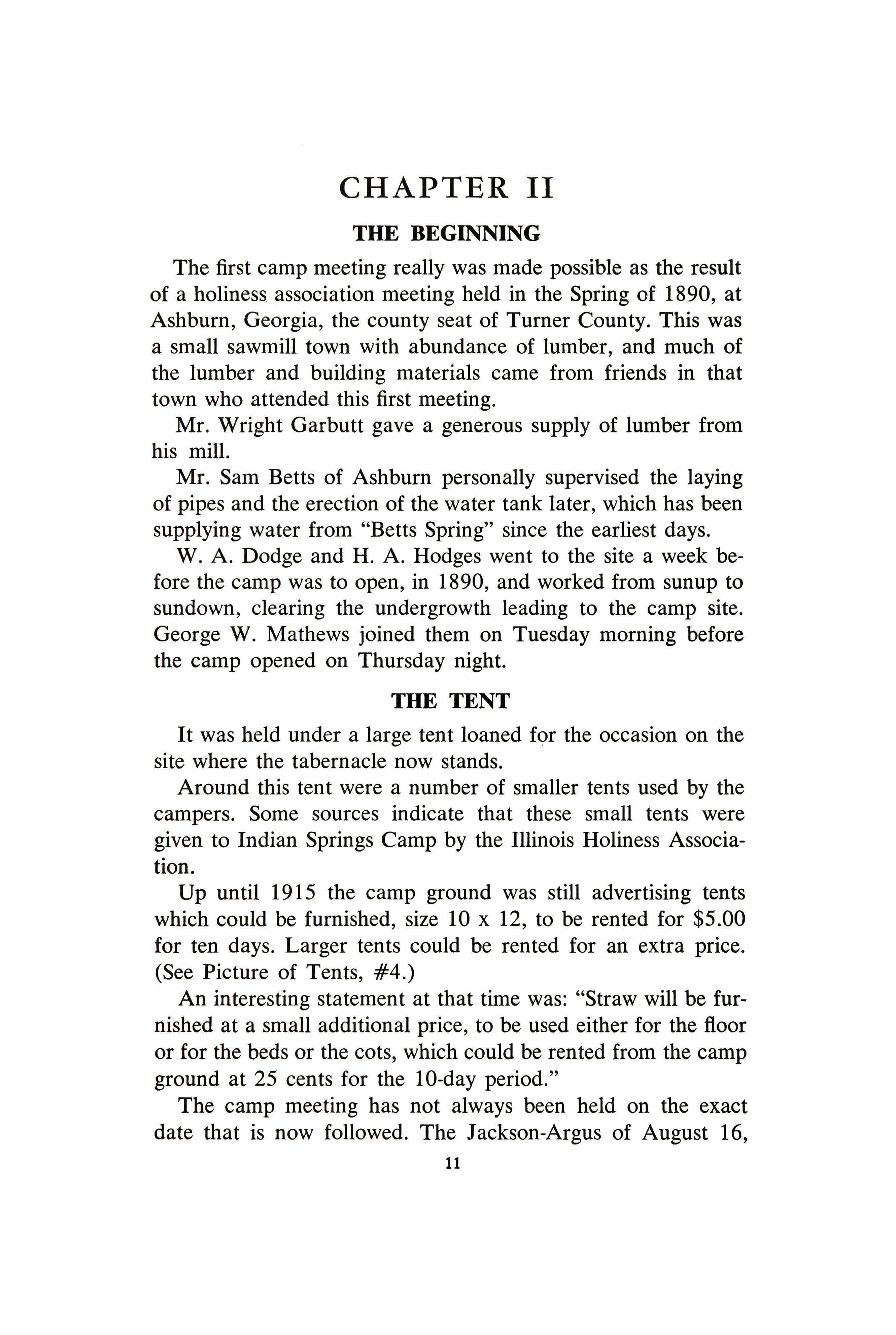
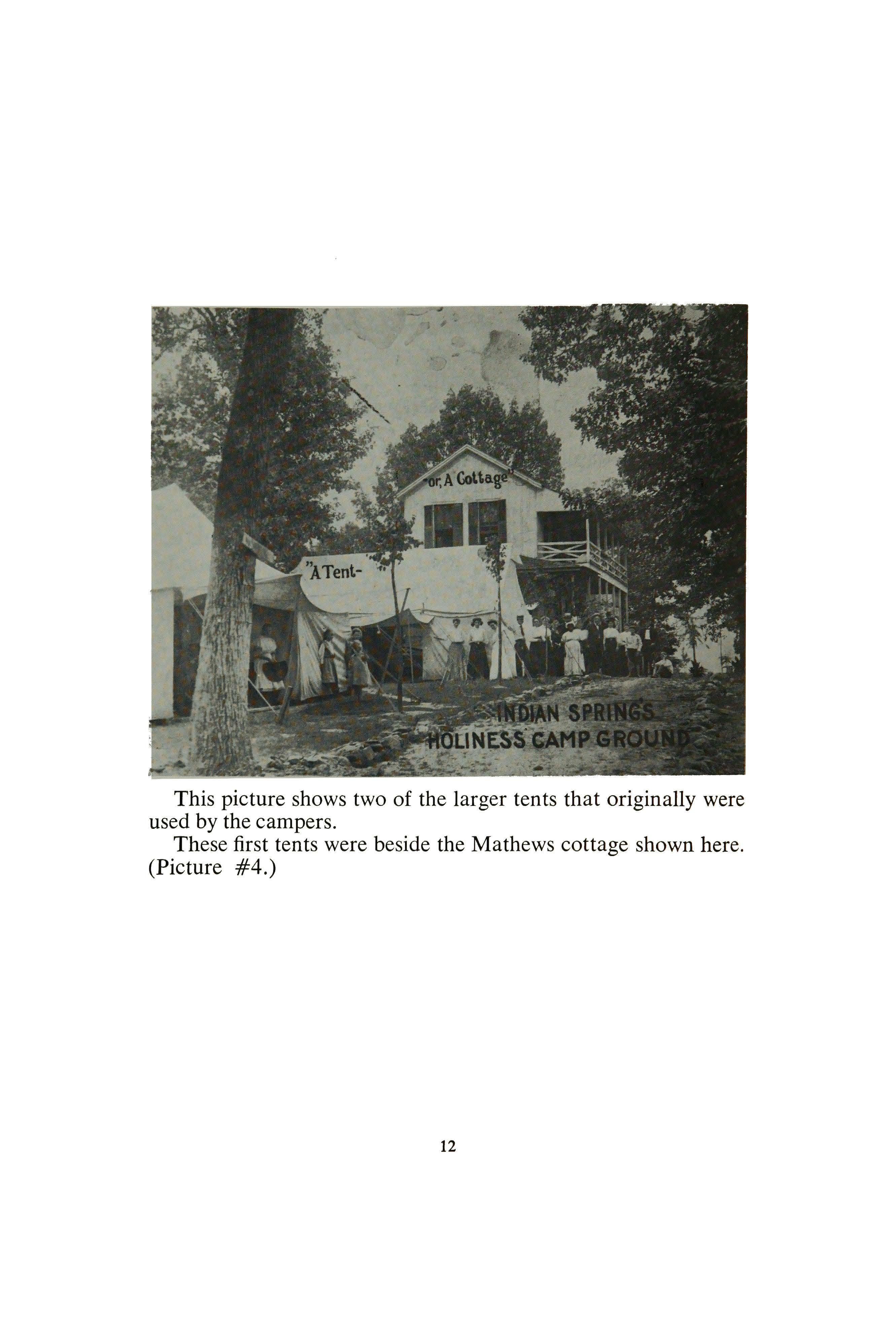 This picture shows two of the larger tents that originally were used by the campers.
This picture shows two of the larger tents that originally were used by the campers.
12
These first tents were beside the Mathews cottage shown here. (Picture #4.)
1895, reported that the Camp would be held from August 27 to September 6. The same relative dates were given in 1892 on Page One of The Argus.
A special pamphlet printed by the Daughters of the American Revolution, in 1906, reported that the 15th annual camp meeting would start on Thursday evening, August 19, with Joseph H. Smith, Bud Robinson, and Will Huff as the speakers. (See Picture #5.)
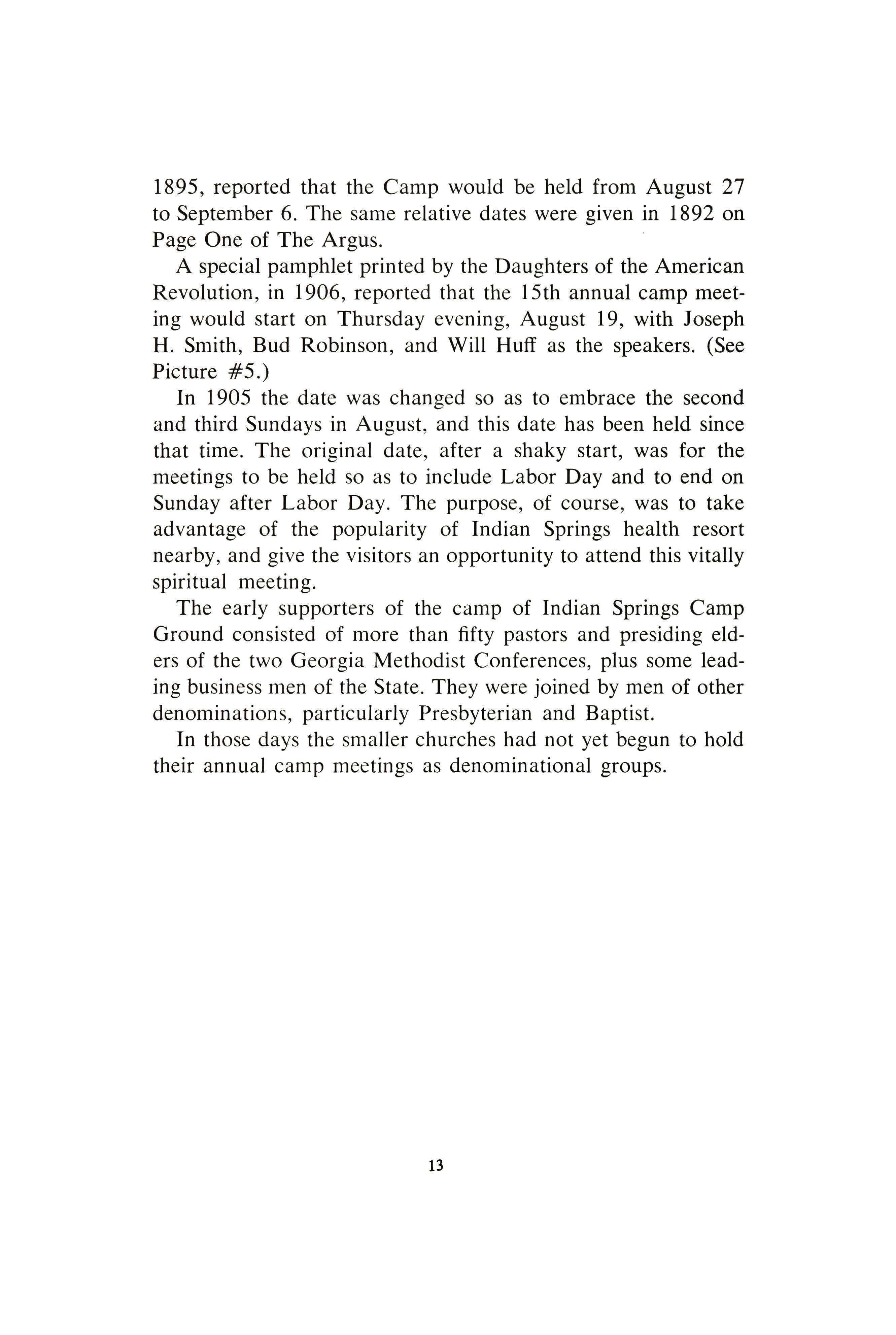
In 1905 the date was changed so as to embrace the second and third Sundays in August, and this date has been held since that time. The original date, after a shaky start, was for the meetings to be held so as to include Labor Day and to end on Sunday after Labor Day. The purpose, of course, was to take advantage of the popularity of Indian Springs health resort nearby, and give the visitors an opportunity to attend this vitally spiritual meeting.
The early supporters of the camp of Indian Springs Camp Ground consisted of more than fifty pastors and presiding elders of the two Georgia Methodist Conferences, plus some leading business men of the State. They were joined by men of other denominations, particularly Presbyterian and Baptist.
In those days the smaller churches had not yet begun to hold their annual camp meetings as denominational groups.
13
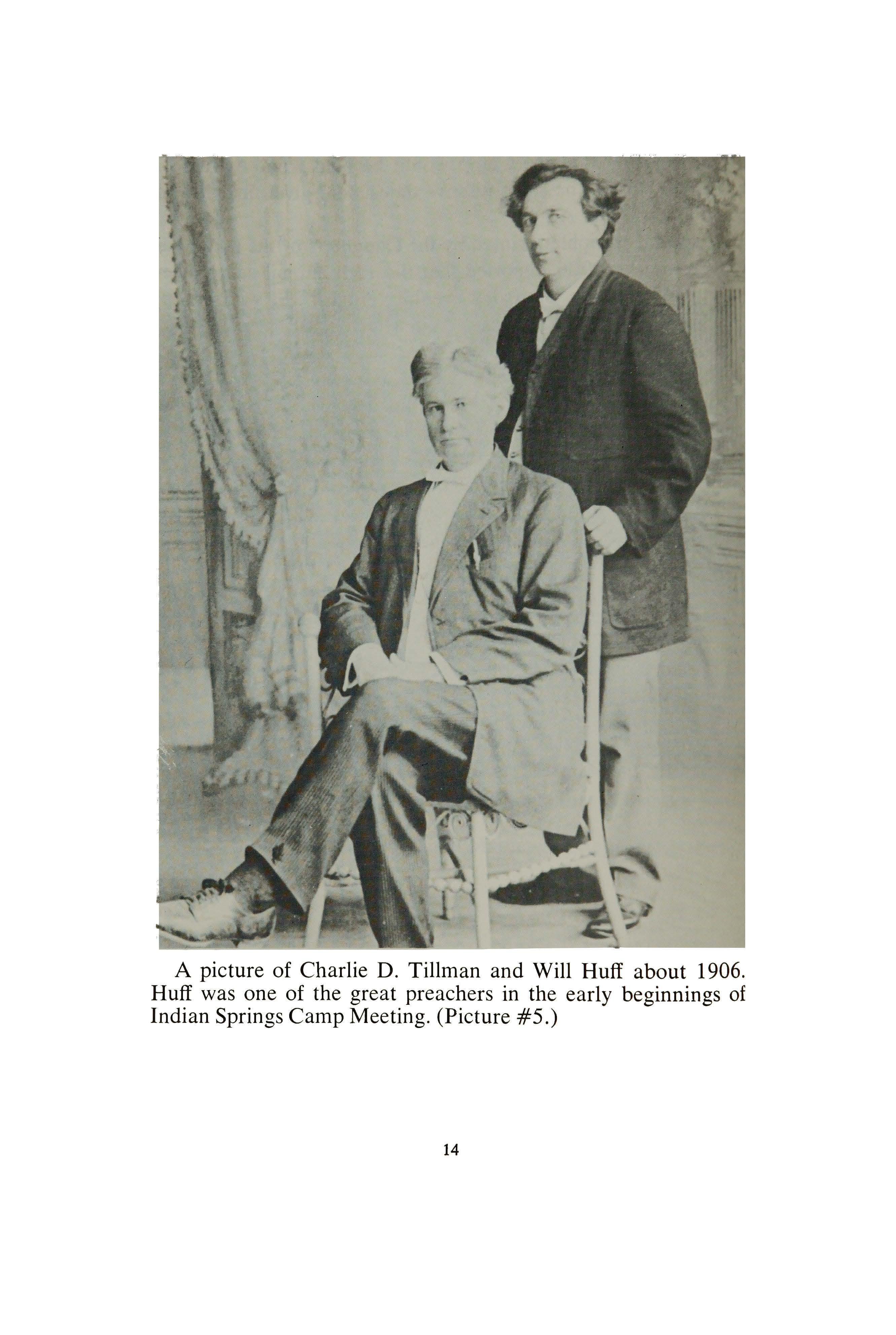
14
A picture of Charlie D. Tillman and Will Huff about 1906. Huff was one of the great preachers in the early beginnings of Indian Springs Camp Meeting. (Picture #5.)
CHAPTER III ORGANIZATION
After the first camp meeting had been held, the Indian Springs Holiness Camp Ground Association was organized on December 18, 1890. Three years later, October 13, 1893, a Charter was obtained and recorded in the Court House, Butts County, Georgia. The charter members were W. C. Dunlap, G. W. Duval, W. A. Dodge, George W. Mathews, Harmony Hodges, S. H. Hunter, J. W. Evans, W. T. Lott, and J. H. Curry. This is printed in the Jackson Argus, August 10, 1893, on Page Two.
THE CHARTER GEORGIA, BUTTS COUNTY TO THE SUPERIOR COURT OF SAID COUNTY
The petition of W. C. Dunlap, G. W. Duval, W. A. Dodge, G. W. Mathews, H. A. Hodges, S. M. Hunter, J. W. Evans, W. T. Lott and J. H. Curry of said State show: That a Camp Ground has been established in said County, known as Indian Springs Holiness Camp Ground, your petitioners further show that they and their successors in office desire to be invested with corporate authority to enforce good order and have Police regulations and authority over the grounds to line of Flovilla and Indian Springs incorporations and one half mile from the Tabernacle in every other direction, receive donations, make purchases and effect alienations of realty and personalty not for the purpose of trade and profit, but for promoting the general design and looking to the general interest of said Holiness Camp Ground.
Your petitioners pray that they and their successors in office be invested with the corporate authority aforesaid and such other authority as may be suitable for said enterprise not inconsistent with the laws of said State nor violation of private rights. Your petitioners pray the granting of an order investing and clothing them and their successors in office with the power and corporate authority aforesaid to remain of force Twenty years with the privilege of renewal, and your petitioners will ever pray, etc.
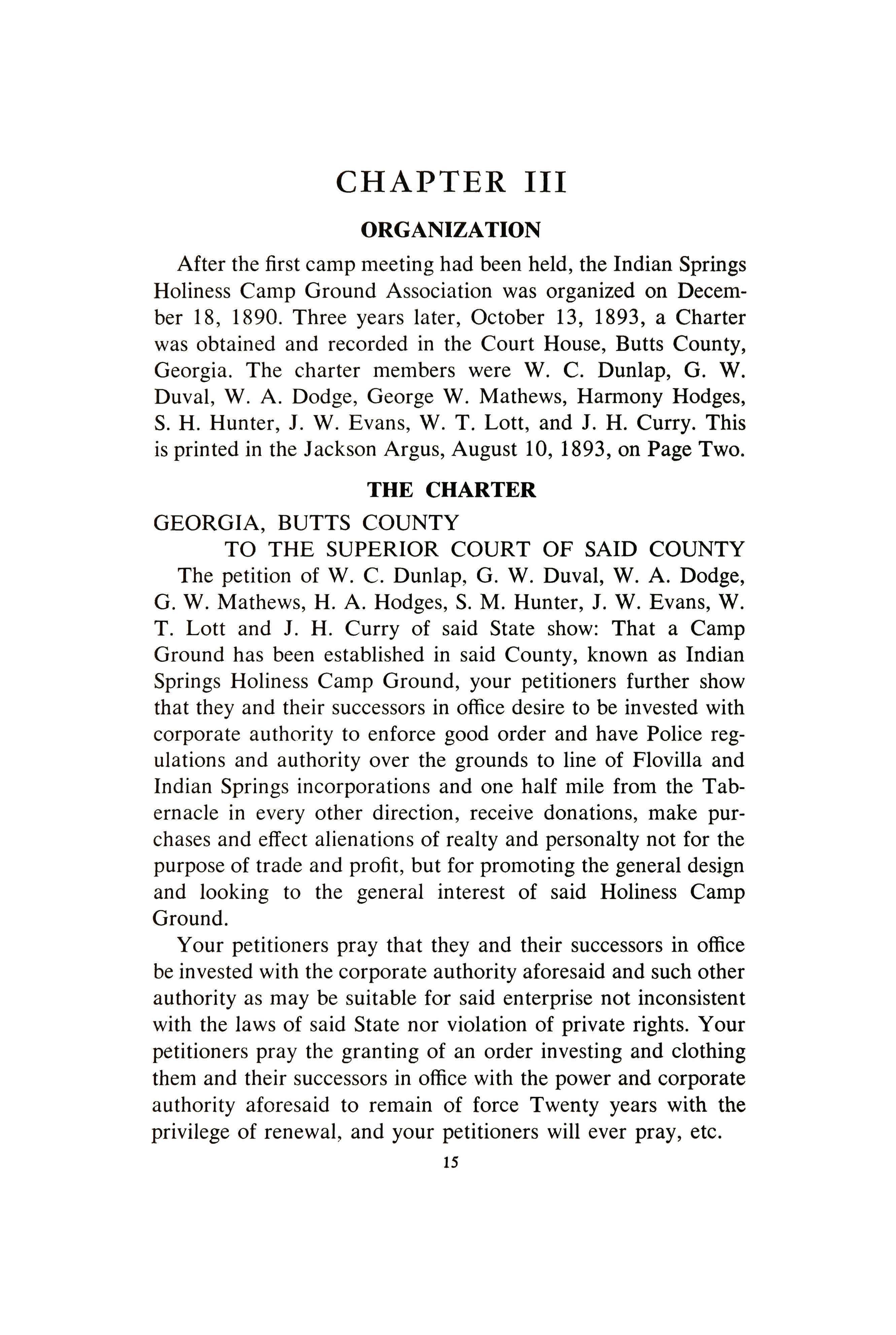
15
IN RE.
W. C. Dunlap, G. W. Duval, ) Petition to Incorporate the Indian Spring Holiness Camp
W. A. Dodge, G. W. Ma th ews,) Ground in Butts Superior
H. A. Hodges, et al. ) Court October Term, 1893.

W. C. Dunlap
G. W.Duval
W.A.Dodge
G. W. Mathews
H. A. Hodges
S. M. Hunter
J. W. Evans
W. T. Lott
J. H. Curry
It appearing to the Court that the above stated petition has been published and filed in office as required by law, and that the same is in the perview of the law, in such cases made and provided, it is therefore considered and adjudged by the Court and Petitioners hereby ordered that said petitioners and their legal successors in office be constituted a body corporate and politic with all the rights, powers and privileges and authority therein prayed for, for and during the term of Twenty (20) years, with the privilege of renewal and the end and expiration of said term according to law. This 13th day of October 1893.
Jno. R. L. Smith Attorney for Petitioners.
(COPY)
Jno.
J. Hunt Judge S.C.F.C.
This Charter was Amended October 30th, 1906. Georgia, Butts County
I hereby certify that the above is a true and correct copy from the records of the Superior Court of Butts County. This 1st day of November, 1951.
Paul Maddox Clerk S.C. Butts County, Georgia
16
CHAPTER IV COTTAGES
Lots for building cottages have been furnished by the camp ground trustees without charge, to parties who abide by the regulations. Certain rules were laid down for the erection of these cottages and regulations were made for their maintenance and disposal.
"By terms of the contract, no cottage holder can dispose of his cottage without the consent of the trustees to the transfer." The contract also specifies that title to the ground remains with the camp ground corporation, and that the cottages thereon can be used by the authorities in case the owners are not present for the camp meeting. (See Pictures# 6-7.)
By 1915, there were fifty-three cottages on the camp ground. These, however, included the camp ground hotel, the keeper's cottage, and Dodge Memorial, as well as the parsonage. (See List.)
In checking the list of cottage holders of 1915, the author found that not a single cottage holder of that date was alive during the camp meeting of 1964.

LARGE HOUSES
The first idea in building large cottages was promoted by some of the leading trustees with a view to furnishing living quarters for their friends whom they would invite to attend the camp meeting from year to year. Some of these "cottages" would hold as many as fifty people.
As far as records show, the first such house built was a large two-story one built by F. C. Benson of Macon, Georgia. It was near the front entrance of the camp ground, just inside the gate where the dummy discharged its passengers. (See Pictures #8 and #9.)
The house had five rooms downstairs and two large ones upstairs, which were lined with cots. One side was filled with women, the other with men. A large porch ran around three sides of the house, both downstairs and up.
17
This is a picture of the first one room cabin built on the camp ground. There is no date to indicate when it was built, but from its appearance we would judge that it was no later than possibly the summer of 1890 or 1891. It has long since disappeared from the scene. (Picture #6.)
The cluster of cottages pictured above shows how they looked about 1900. Most of the earlier cottages were built family size and were generally known as "summer cottages." (Picture #7.)

18
This picture shows the Benson Cottage with Mrs. Benson and some of her friends sitting on the porch. It was built in 1902.
There were two large rooms upstairs with a hallway between. On one side the room was filled with cots for men. On the other side it was filled with cots for women. The first floor consisted of three bedrooms, a dining room, and kitchen.
The lovely porch surrounding the building was a place of quietness and rest for meditation and Bible study. On the front porch near the right-hand corner, the six o'clock prayer meetings usually were held, and were largely attended by guests of the Bensons, who filled the house every year. (Picture #8.)
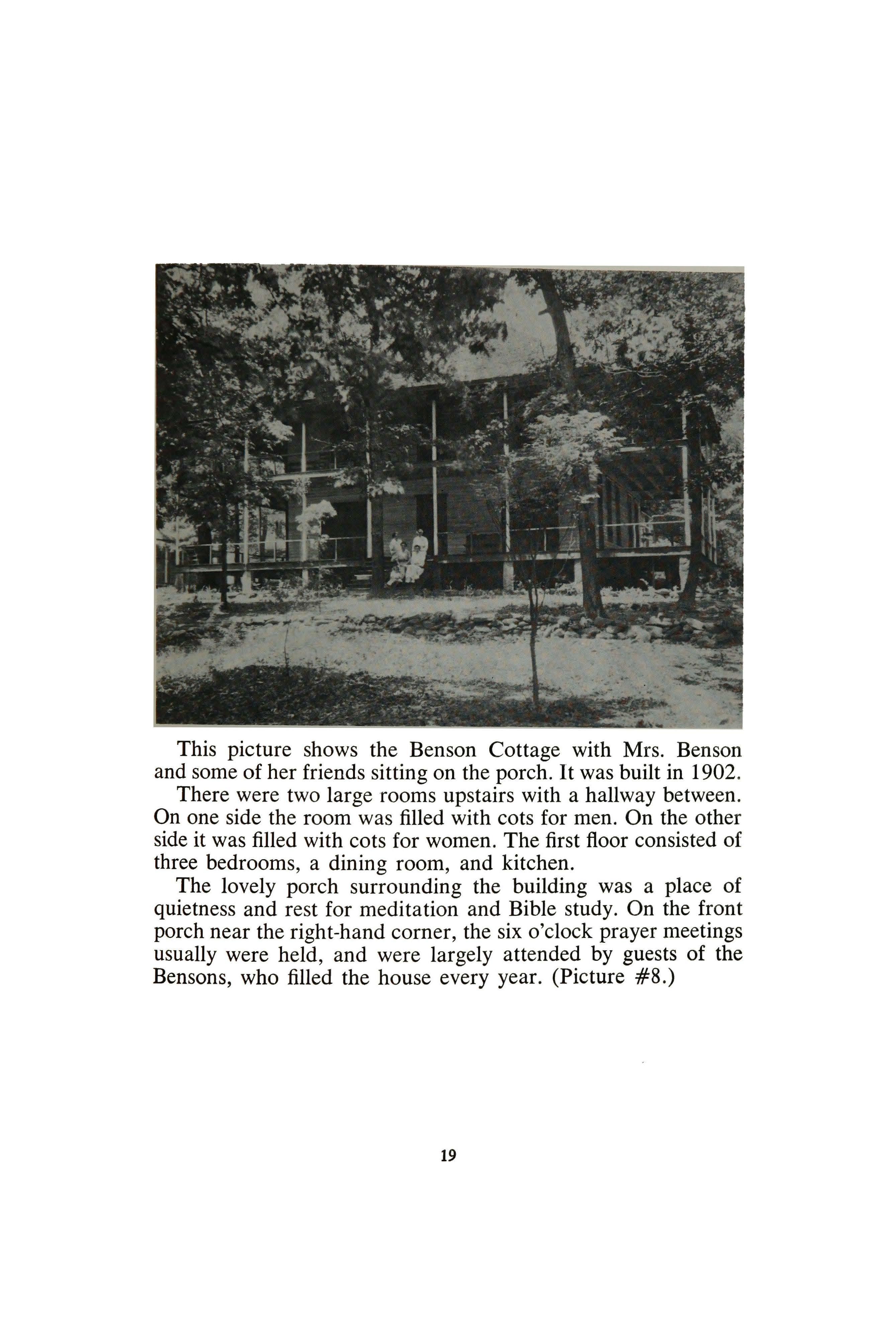
19
This picture shows three of the larger houses that were built to accommodate guests. The one on the left was the Mathews home in which hundreds of people have been entertained over the seventy five year period.
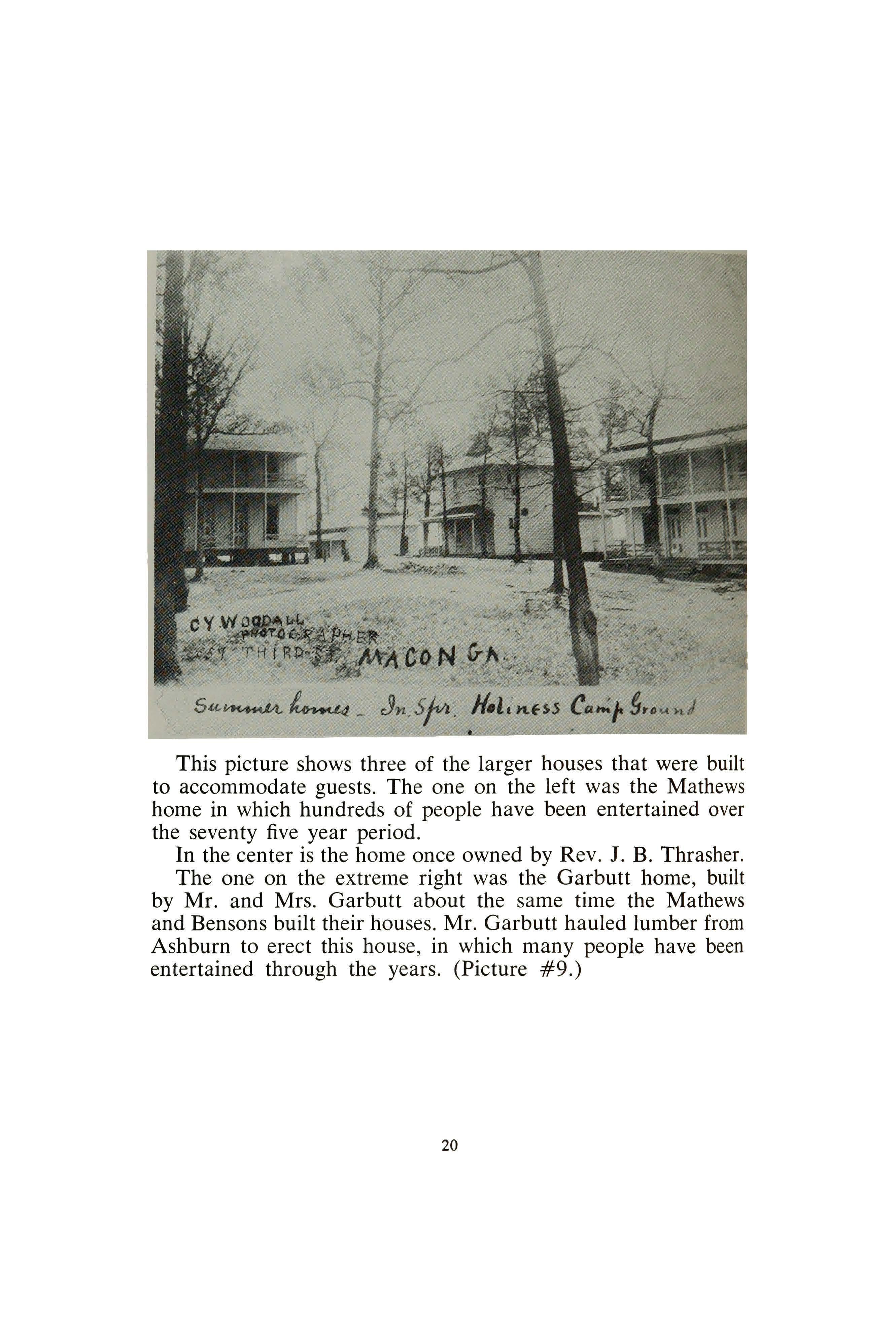
In the center is the home once owned by Rev. J. B. Thrasher.
The one on the extreme right was the Garbutt home, built by Mr. and Mrs. Garbutt about the same time the Mathews and Bensons built their houses. Mr. Garbutt hauled lumber from Ashburn to erect this house, in which many people have been entertained through the years. (Picture #9.)
14,, ~~,c:,··. ' ~~·coN ..., Su~~_ Jn. Sjvi. JI.Li'KOS C«..;/a§rou ~J
20
The Bensons would hire cooks and feed as well as provide rooms for these friends. The rates were very nominal and many, many friends were invited to attend the camp meeting at no cost to themselves. In this way many people were brought into the camp who had never heard of holiness, and many of them found the experience at the altars of the tabernacle.
Those who quickly followed suit in building large "cottages" were Dr. George W. Mathews and wife, Mr. and Mrs. William S. Garbutt, Mr. and Mrs T. J. Shingler, and Mr. and Mrs. Betts. (See Picture of the Garbutts, #10.)
Soon after the tabernacle was erected, rather rude cottages began to spring up and dot the woods around it. With the building of the larger houses, however, the camp ground took on a more permanent atmosphere and began to fill a place of importance in the spiritual life of Georgia and the South. (See Picture #11.)
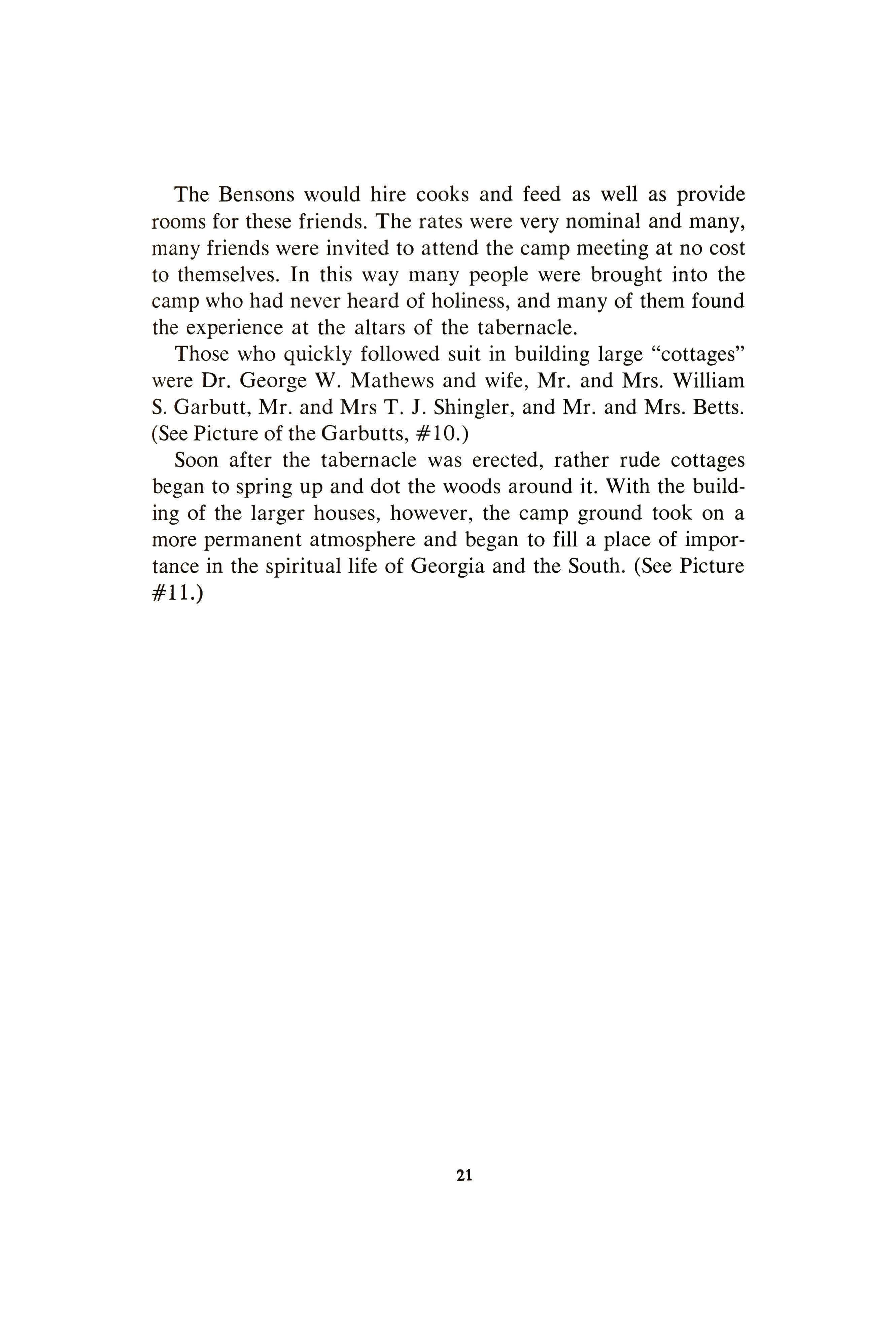
21
This shows Mr. and Mrs. Garbutt of Ashburn, Georgia, who were prime leaders and supporters of the South Georgia Holiness Association and the Indian Springs Camp Meeting organization. Mr. Garbutt was among the first ones, along with Mr. Benson of Ashburn, to donate lumber for the houses on the camp ground, and was greatly interested in the growth of the camp.
(Picture #10.)
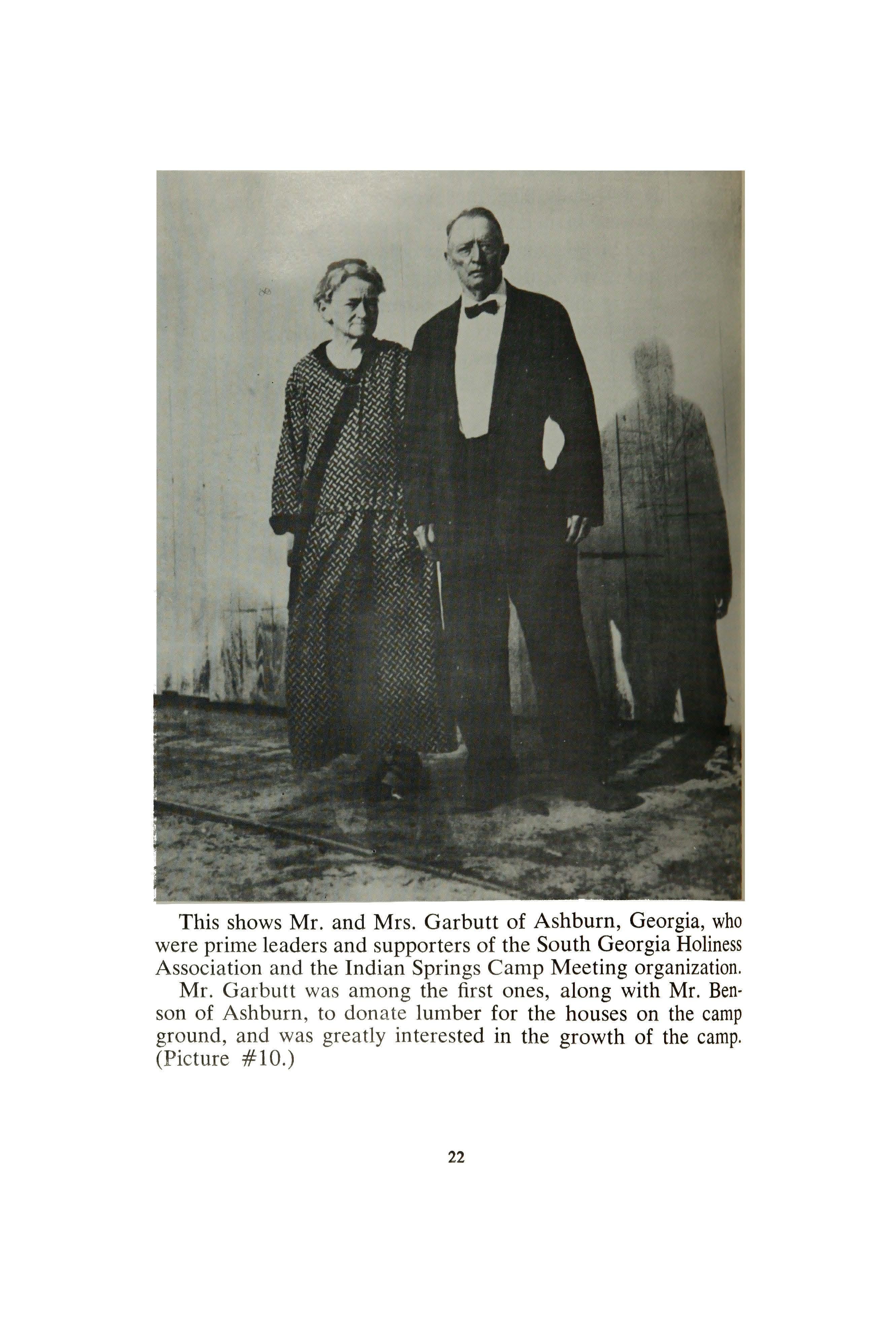
22
This picture shows some of the cottages that were built after 1900. It will be noted that they are generally larger than the first ones and of much better quality. Many of these homes are still standing and old-timers will recognize some of them from this picture. (Picture # 11.)

23
CHAPTER V
GROWING PAINS-THE FIRST TABERNACLE
This D.A.R. article also stated, "The services will be held at the Tabernacle which was erected in 1903, being a perfect auditorium, having a seating capacity of about 2,000." This is the first and only reference that the writer could find as to the date of the building of the permanent tabernacle. (See Picture #12.)
In 1909, the paper had become the Butts County Progress. July 23, 1909, on Page One, an article states that new seats had been put in the tabernacle, the water pump had been put in good condition, and that the workers would be Joseph H. Smith, Bud Robinson, and Charlie Tillman. (See Picture #13.)
A HOLINESS COLLEGE?
This same issue reported that a move had been started to build a holiness college on the camp ground. Further reading of the Jackson Progress stated that quite an argument arose in the County over building a holiness college on the camp ground.
Captain Smith vigorously supported the idea but many of the citizens opposed it on the grounds that it would not be a good thing for the county to have this type of organization operating within its boundaries.
The facts seem to be that more opposition arose from the citizens because of the anticipated request for funds to help build and operate it, than for any other primary reason.
The Jackson Progress, in an editorial, vigorously condemned Captain Smith and other citizens for supporting a holiness college.
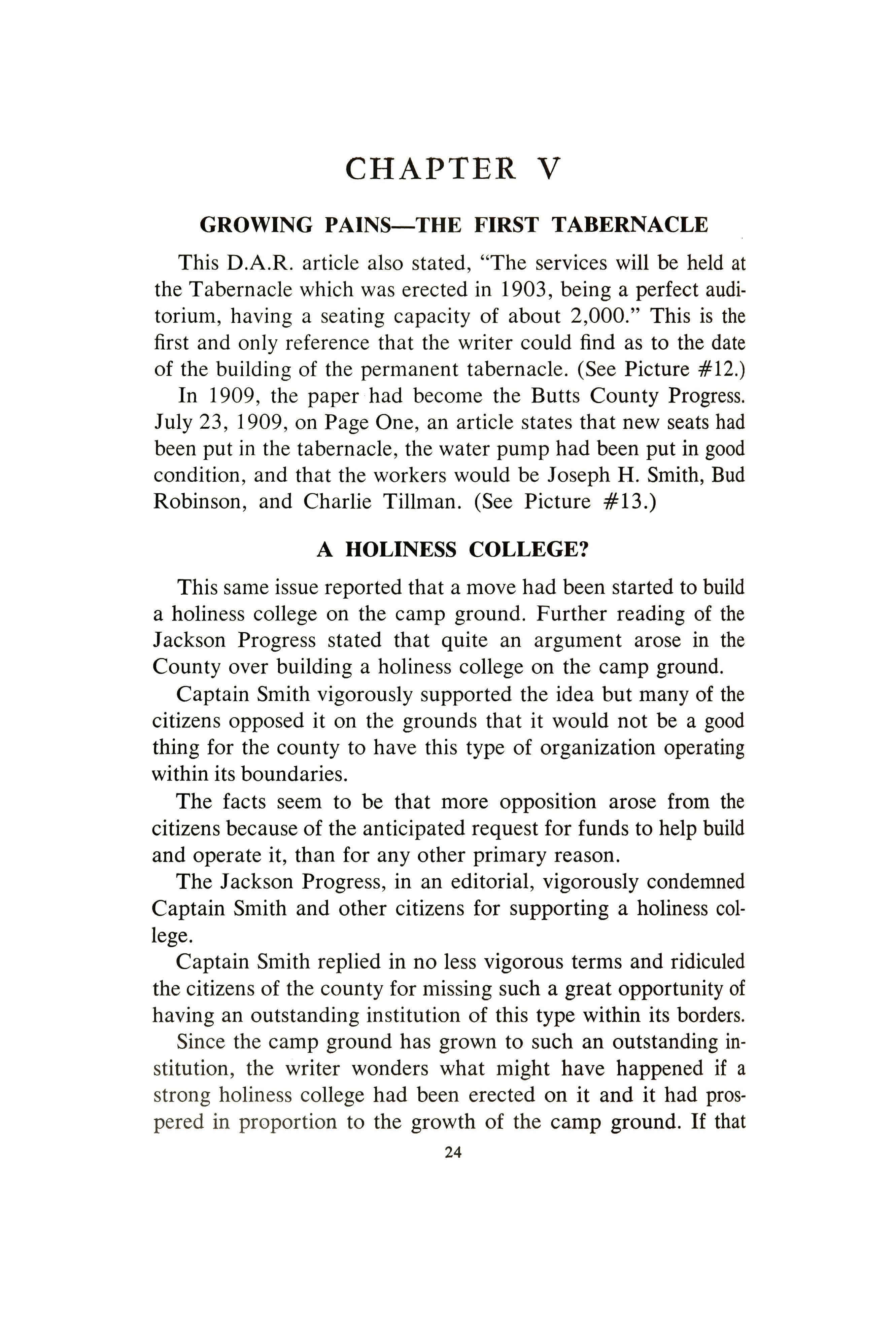
Captain Smith replied in no less vigorous terms and ridiculed the citizens of the county for missing such a great opportunity of having an outstanding institution of this type within its borders.
Since the camp ground has grown to such an outstanding institution, the writer wonders what might have happened if a strong holiness college had been erected on it and it had prospered in proportion to the growth of the camp ground. If that 24
This is a picture of the first tabernacle as it was erected in 1903. Notice that it follows the natural contour of the ground; that even the seats are slanting with the ground on the left-hand corner of the tabernacle.
Beyond the tabernacle, on the left, may be seen the parsonage which was originally constructed to house preachers free of charge. It was used as a parsonage for many years until Dodge Memorial was built. Then the preachers were placed there, and this was used for the entertainment of local preachers and visiting evangelists and the singers who might drop in for a day or two. (Picture #12.)
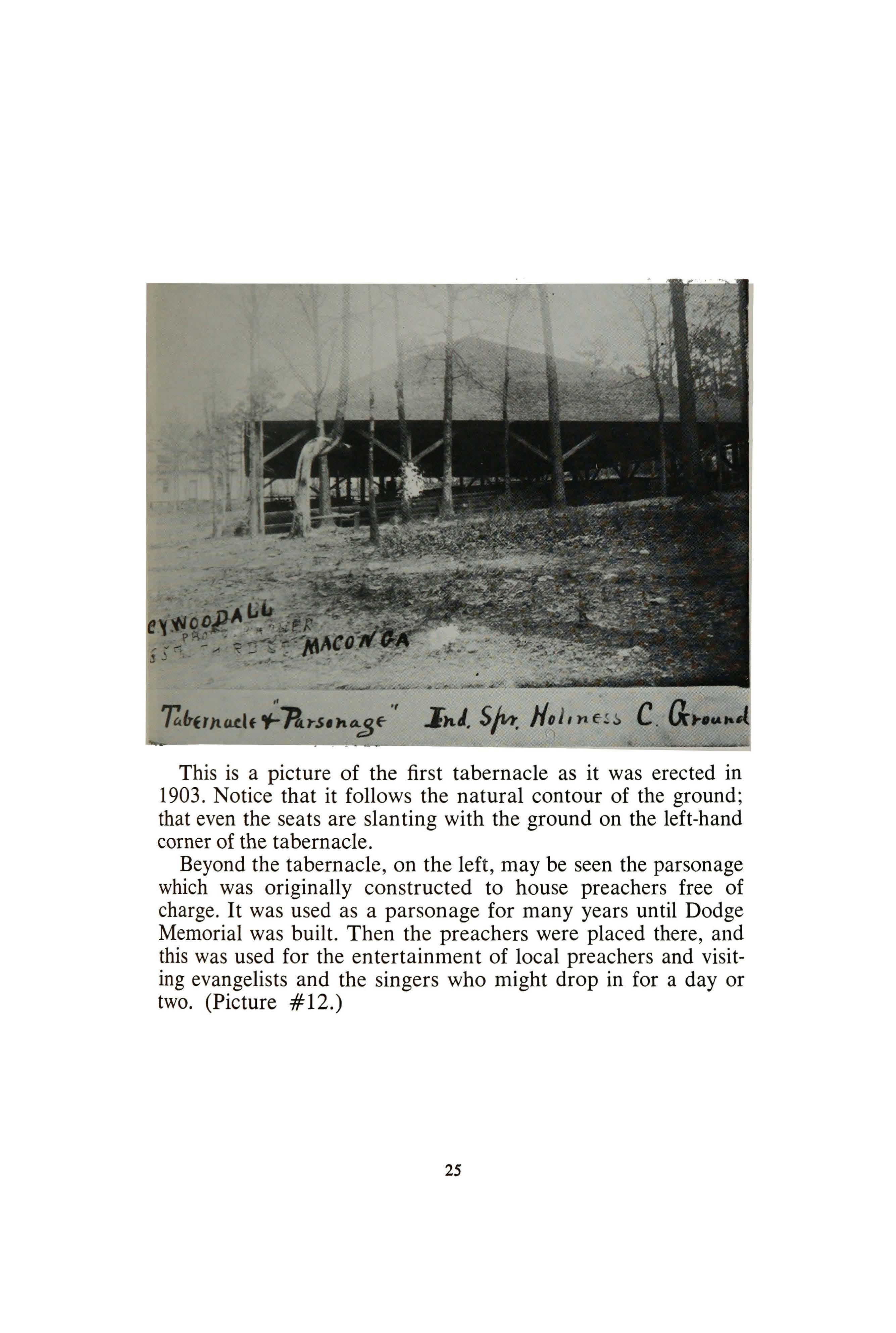
25
This view of the tabernacle shows improvements that were made between 1910 and 1916. Note, for example, that the floor has been leveled on the left-hand corner, giving the tabernacle a more refined appearance.
Note that a choir loft has been added. This was originally designed to seat 100 people. Since this was erected, it has been modified and improved until it is a comfortable asset now to the music department.
Notice that the vent system in the center of the roof of the tabernacle had not been installed at that time. This was added some years later, which made the tabernacle more comfortable during extremely hot weather. (Picture #13.)
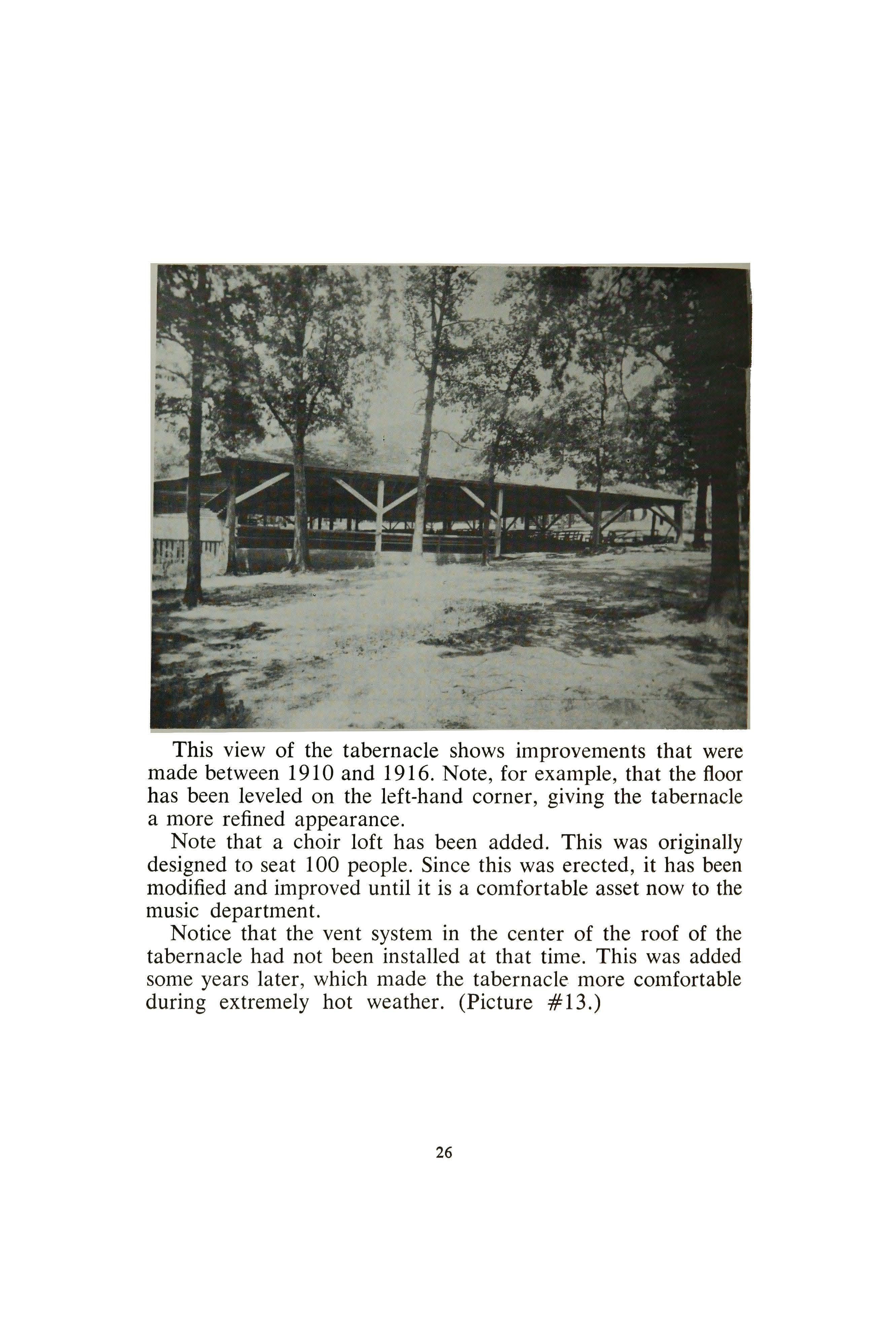
26
had happened, Butts County would today have one of its largest business ventures within its borders.
The Jackson Progress of August 11, 1916, issued a report to the effect that the railroads had offered a round-trip of three cents, plus fifty cents, from points in Georgia. This meant, of course, three cents per mile.
The Southern Railroad and the Flovilla and Indian Springs railway offered a round-trip from Jackson to Indian Springs, or to the camp meeting and back, for forty cents.
It was in this same issue that the improvements on the camp ground were reported, including the installation of an electric light plant.
According to the Charter, the Indian Springs Camp Ground Association was organized as a corporation with a self-perpetuating board of trustees. Its fundamental doctrines were set forthin its bylaws and a set of simple rules was adopted for the conduct of the camp and the control of the attendants. The first trustees under the Charter were: W. A. Dodge. H. A. Hodges, J. H. Curry, George W. Mathews, and M. D. Smith. Mr. Smith was a prominent layman and tent maker of north Georgia.
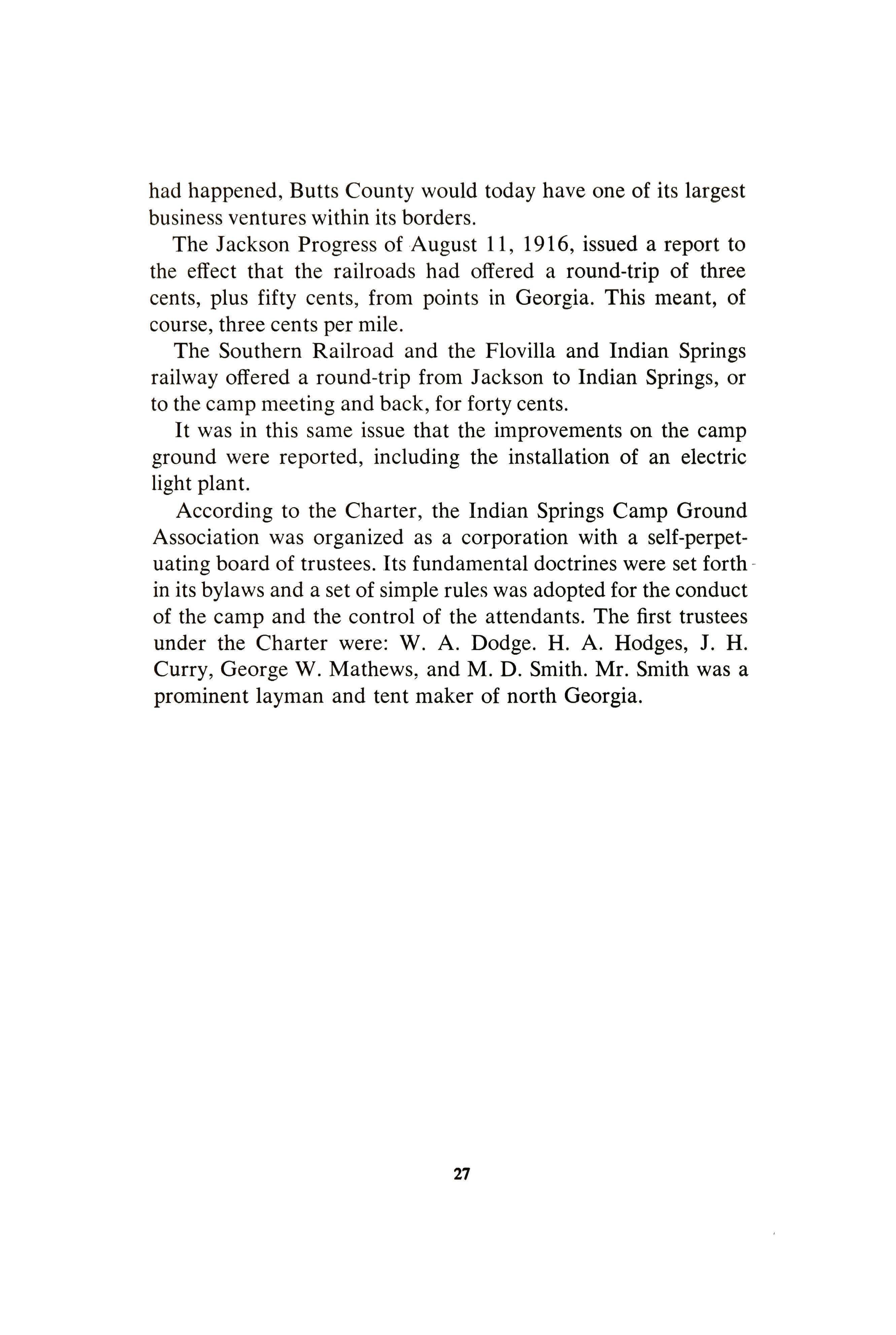
27
CHAPTER VI THE LEADERSHIP
W. A. Dodge
The officials of the board have always been selected after much prayer, and with great care and wisdom. The first president was Rev. W. A. Dodge of Atlanta, who served until 1904. (See Picture of Dodge, # 14.)
Brother Dodge was pastor, evangelist, and editor of "The Way of Life."
The secret of his success as a leader of this great camp is revealed in a paper which he signed August 15, 1876. It read, in part, as follows: "I this day make a full consecration of all I have to God now, henceforth forever, myself, my body, tongue, eyes, hands, feet, mind and heart."
After placing his entire family with all his possessions on the altar, he said further, "If there is anything else that appertains. to me that I have not mentioned, I lay it on the altar to stay there forever."
His work in the holiness movement throughout Georgia attested to the reality of the depth of his consecration.
George W. Mathews
George W. Mathews served as president from 1904 to 1925. His main work was as pastor of various churches in the South Georgia Conference, but his chief interest in life was the promotion of holiness, and his chief means of expression was through the Indian Springs Camp Meeting held each year.
After his death, Bishop W. N. Ainsworth of Macon, Georgia, said: "George Mathews believed in the Methodist doctrine of holiness, and exemplified in his own life all of its beauty and charm. The descent of the heavenly Dove made his heart an altar, and ever after the love of God burned as a quenchless flame. The fruit of the Spirit was ripe on every limb of his life."
Dr. Joseph Owen who preached at Indian Springs on several occasions, said: "George W. Mathews was so much beloved, 28
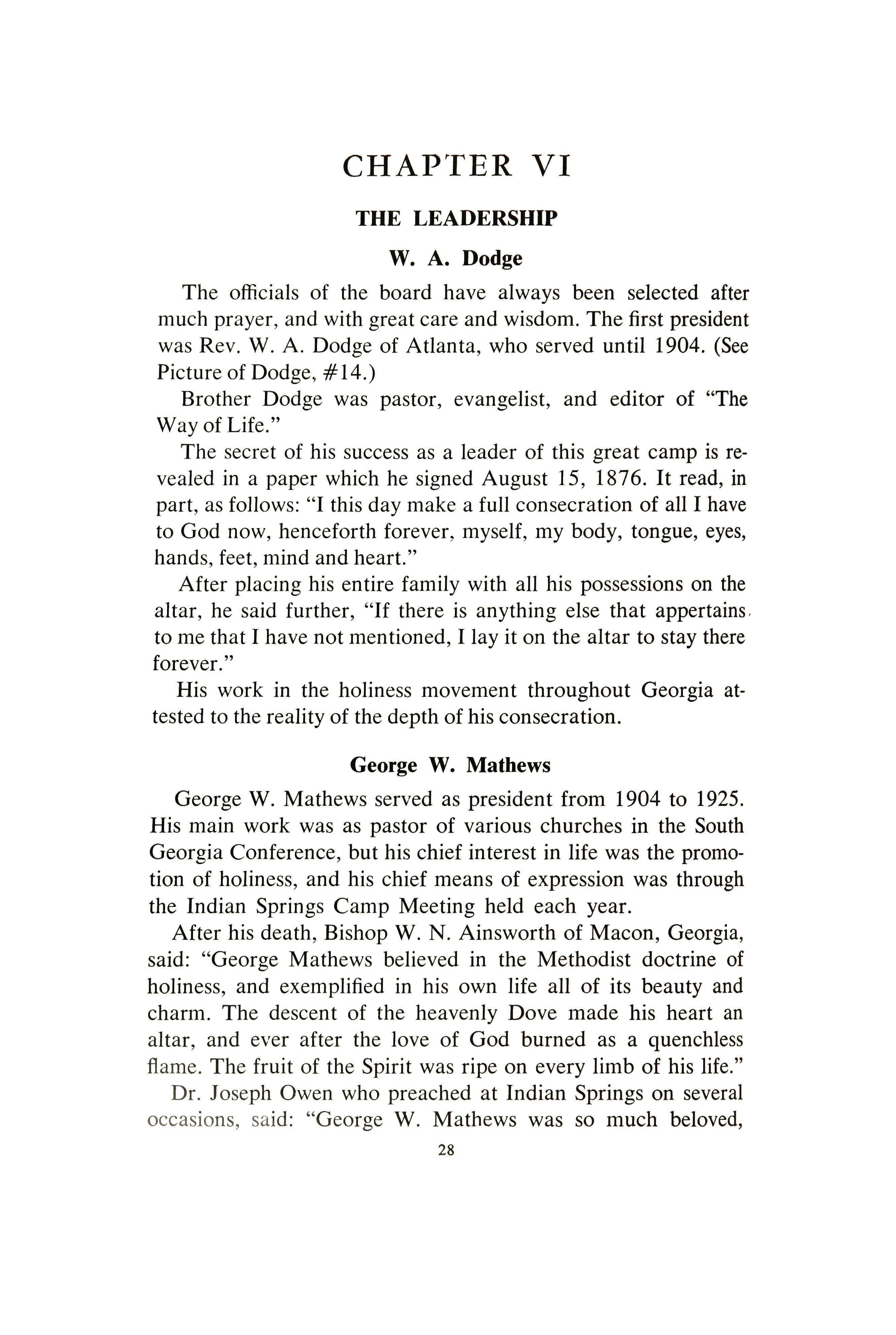
Rev. W. A. Dodge of Atlanta was one of the founders and the first president of the camp. This is the best picture that could be obtained of him. It was taken from an old photograph made about 1900. (Picture #14.)
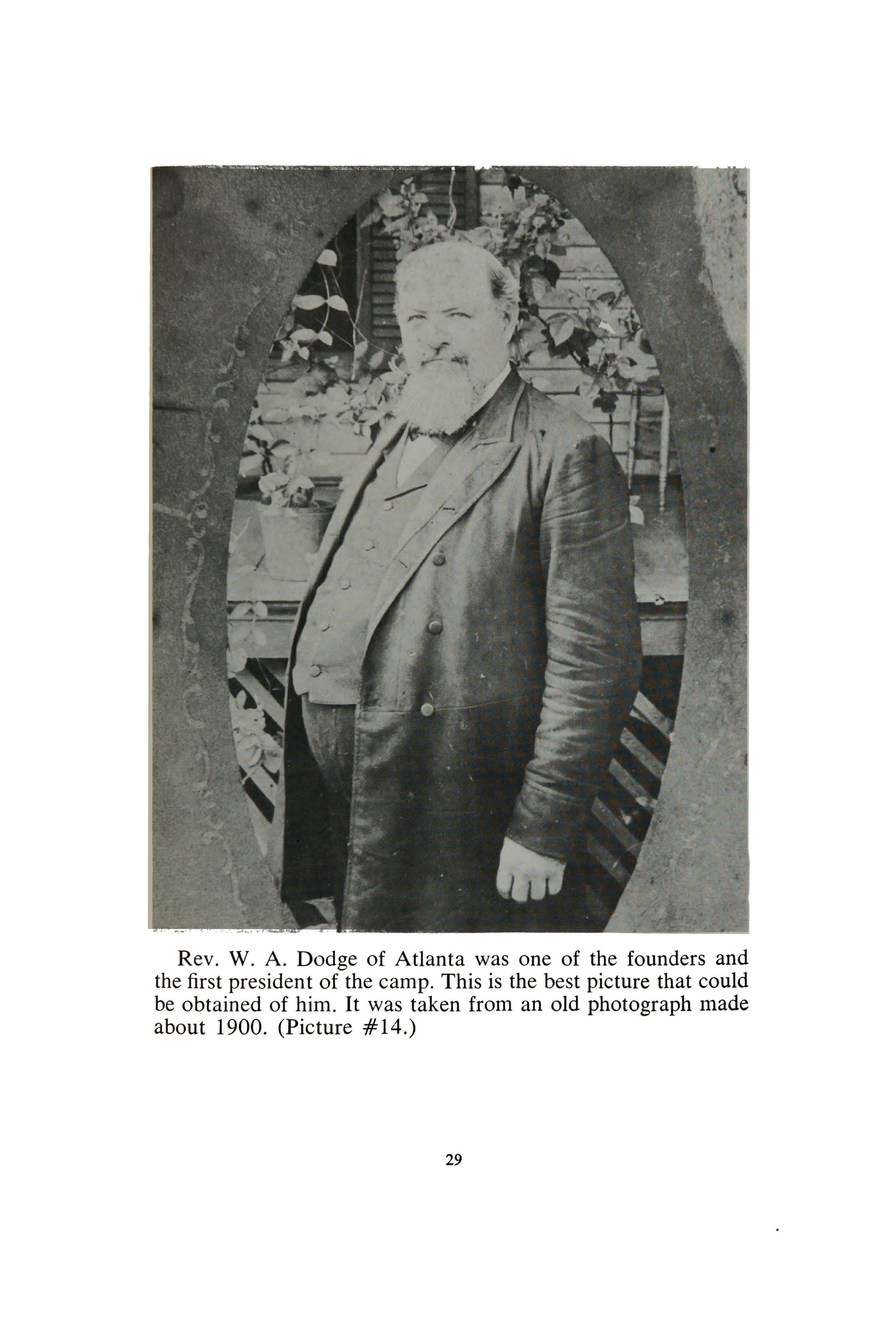
29
and so remarkably useful, that it is difficult to frame an estimate or speak in appreciation of the man. He was armed with such strength and dignity and gentleness and love that his character had a manifold appeal."
Dr. H. C. Morrison said: "George Mathews was an old time southern gentleman of the very finest type. He was tall, broadshouldered, erect, handsome, courteous with a beautiful sincerity, without the slightest affectation. He walked a~ong the people as a great General, calmly and confidently leading the hosts of the Lord." (See Picture of Mathews, #15.)
R. F. Burden
Following the death of Dr. Mathews, the camp meeting experimented for the first time by electing a layman as president. He was R. F. Burden of Macon, Georgia, a consecrated lay leader and well-to-do merchant in that city. He served as president of the camp from 1925 to 193 7.
It was during his presidency that the tabernacle was improved with concrete floors and comfortable seats, which were the gift of Brother Burden, personally. When this work was finished, it made the tabernacle one of the most attractive of all holiness camps of America.
Brother Burden knew how to preside. He knew how to organize. He knew how to get the best out of the memb~rs of the board of trustees, and especially how to utilize the work of the laymen in the camp. (See Burden and Trustees, #16.)
One of Brother Burden's outstanding appointments was that of Frank C. Benson of Macon, Georgia, a clothing merchant who succeeded George W. Mathews as leader of the sunrise prayer service which Brother Mathews had led for twenty-one years.
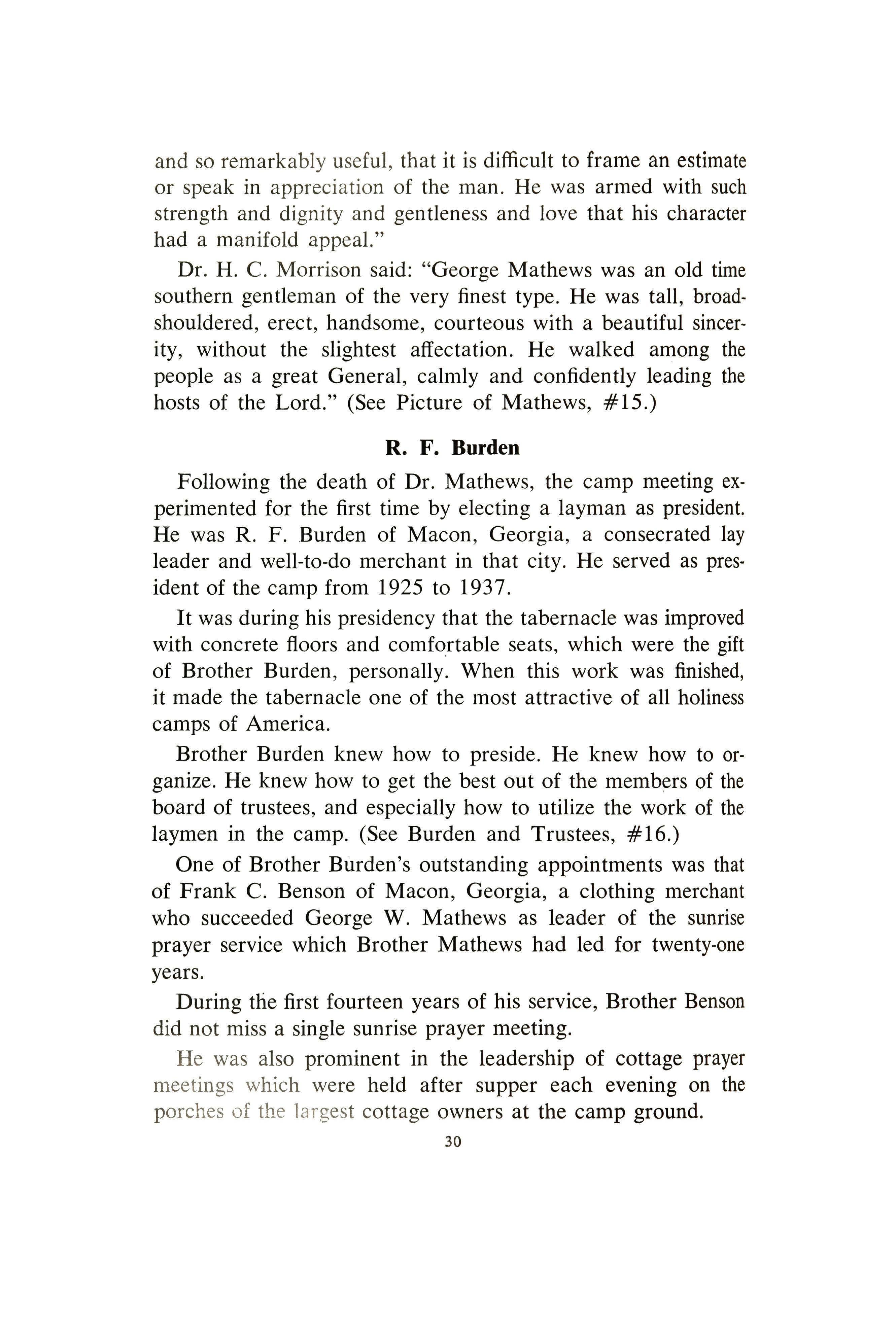
During the first fourteen years of his service, Brother Benson did not miss a single sunrise prayer meeting.
He was also prominent in the leadership of cottage prayer meetings which were held after supper each evening on the porches of the largest cottage owners at the camp ground.
30
This picture was made from one in the home of the Mathews family and shows George Mathews as many of us knew him.
Note the kind expression on his face, particularly around his eyes. He was a man of sincerity~ deep religious convictions, and of a gentle disposition few men possess. (Picture #15.)

31

32
A picture of the trustees attending the December session. R. F. Burden was then the President and was succeeded by J. M. Glenn who is shown over his right shoulder in this picture. (Picture #16.)
These two prayer services have been a source of power to the camp for many years and have been running continuously. Usually they have reports at the evening services of the prayer meetings held all over the camp grounds after the supper hour and before preaching.
J. M. Glenn
Dr. J.M. Glenn, a South Georgia pastor and sometime presiding elder, succeeded Brother Burden as president in 1937. He had been vice president of the camp for a good while and was one of the outstanding leaders, with his wife, in special services for young people.
He gave the camp meeting official leadership during his entire term. It was during his administration that the young people's tabernacle, now the children's tabernacle, was built.
When promotion of this project was begun, there was much opposition to it, on the grounds that it would divide the services and take the young people out of the tabernacle for the preaching hour. Such objections were overruled.
Dr. Leonard Cochran
Dr. Cochran was president for a number of years following Mr. Burden. He was pastor of the Mulberry Street Methodist church at that time, and being only forty miles from the camp, he was available for consultation with the workers at the camp during the year.
Under his leadership the interest of the young people was stressed, and he did a lot to effect the organization and work among them that has paid off in later years.
When he resigned to become president of another camp, he felt that the burden of two camps, plus heavy pastoral duties was too much for one man to carry.
Mr. McKibben
Mr. W. S. McKibben started coming to the Indian_ Springs camp meeting in 1941 and was soon placed on the Board of Trustees. In 1952, he became President and has been President
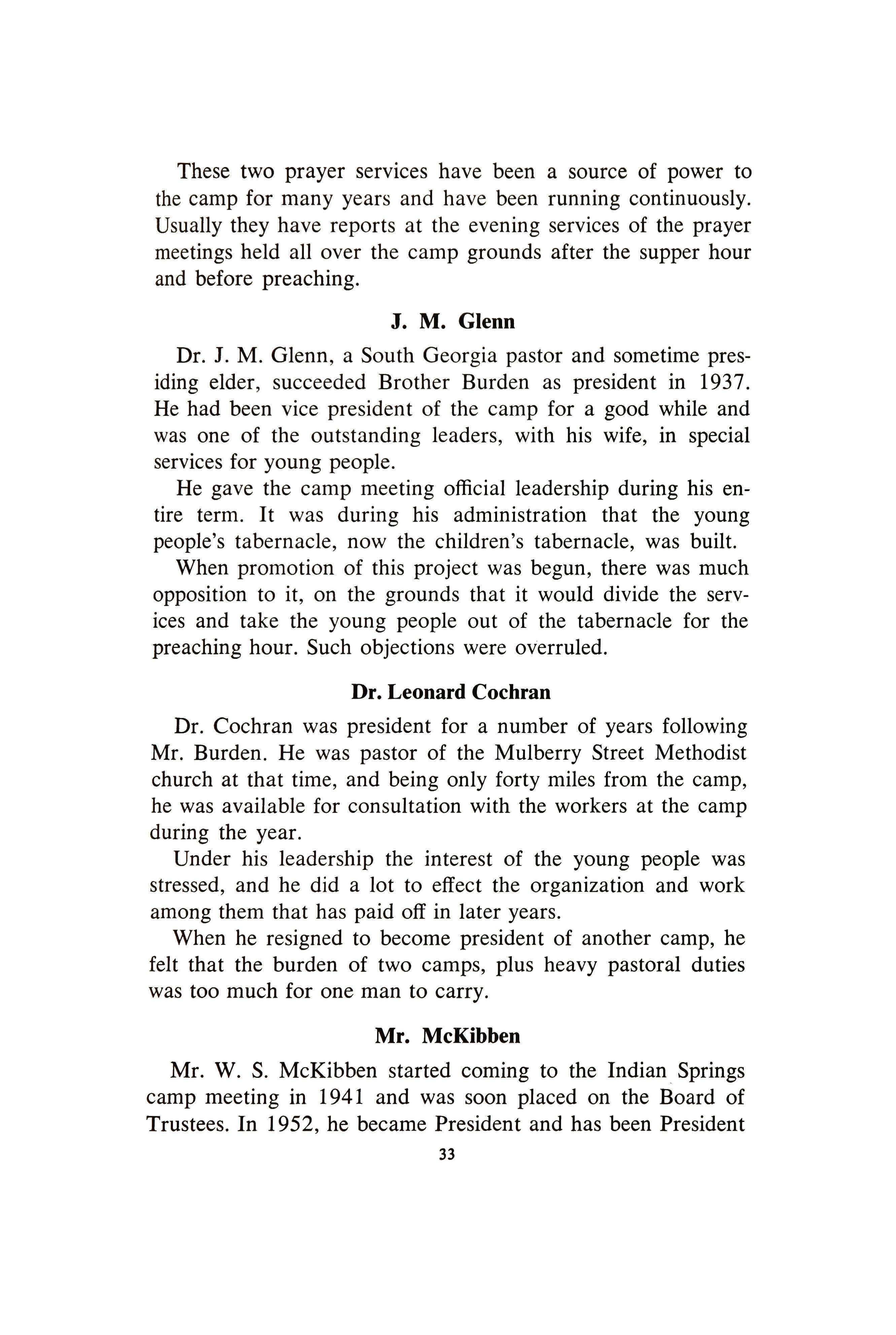
33
since that time. He had previously served as Treasurer of the Board.
As a layman, Mr. McKibben has been greatly interested in the material development of the camp ground, as well as the spiritual.

His first contribution to the camp was as a leader of the seven o'clock prayer service in the tabernacle each morning. This has been the main powerhouse of the camp meeting throughout the years and the success of this prayer meeting has largely determined the success of the camp meeting as a whole, each year.
(See Picture of Mr. McKibben, #17.)
34

35
Mr. W. S. McKibben as he appeared at the December Board Meeting held at Jackson in 1964. (Picture #17.)
( rlAPTER VII PROBLEMS
The Board has been faced with many problems arising out of the prosperity and growth of the camp and its subsequent needs. Good examples may be found in the need for additional facilities and services, not only for the meeting itself but for the convenience and permanency of the camp ground.
For many years the camp ground had control of the electrical system on the grounds and permitted people to attach to it for a very small rental charge. This, of course, was a great improvement over the old fashioned hanging lamps in the tabernacle, followed by the gas burning lamps which seemed a miracle within themselves. But it was soon outmoded by the rapid growth of buildings on the grounds.
It was discovered that the wiring system was not planned for such load and it was found necessary to get the Georgia Power Company to come in and wire the entire camp ground adequately.
On June 2, l 952~ a special meeting of the board of trustees was held relative to the electrical problem, with the Georgia Power Company. Its main problems were discussed at that time.
For example, in August, 1961, the grounds committee was given authority to improve the electric system, and the trustees approved a resolution authorizing the Georgia Power Company to take over the system for the camp ground.
Under this agreement, all camp meeting buildings will be on vacation reading except pumps and the the hotel.
After the camp of 1962, each cottage owner had to make personal arrangements for electricity; and after that date no lamps, lanterns, or oil heaters were to be allowed in the cottage.
LET THERE BE LIGHT!
August, 1963, the President reported that the entire electrical system had been taken over by the Georgia Power Company; that both annexes had been rewired; and that the well pump had been replaced. This special report also stated that the new 36
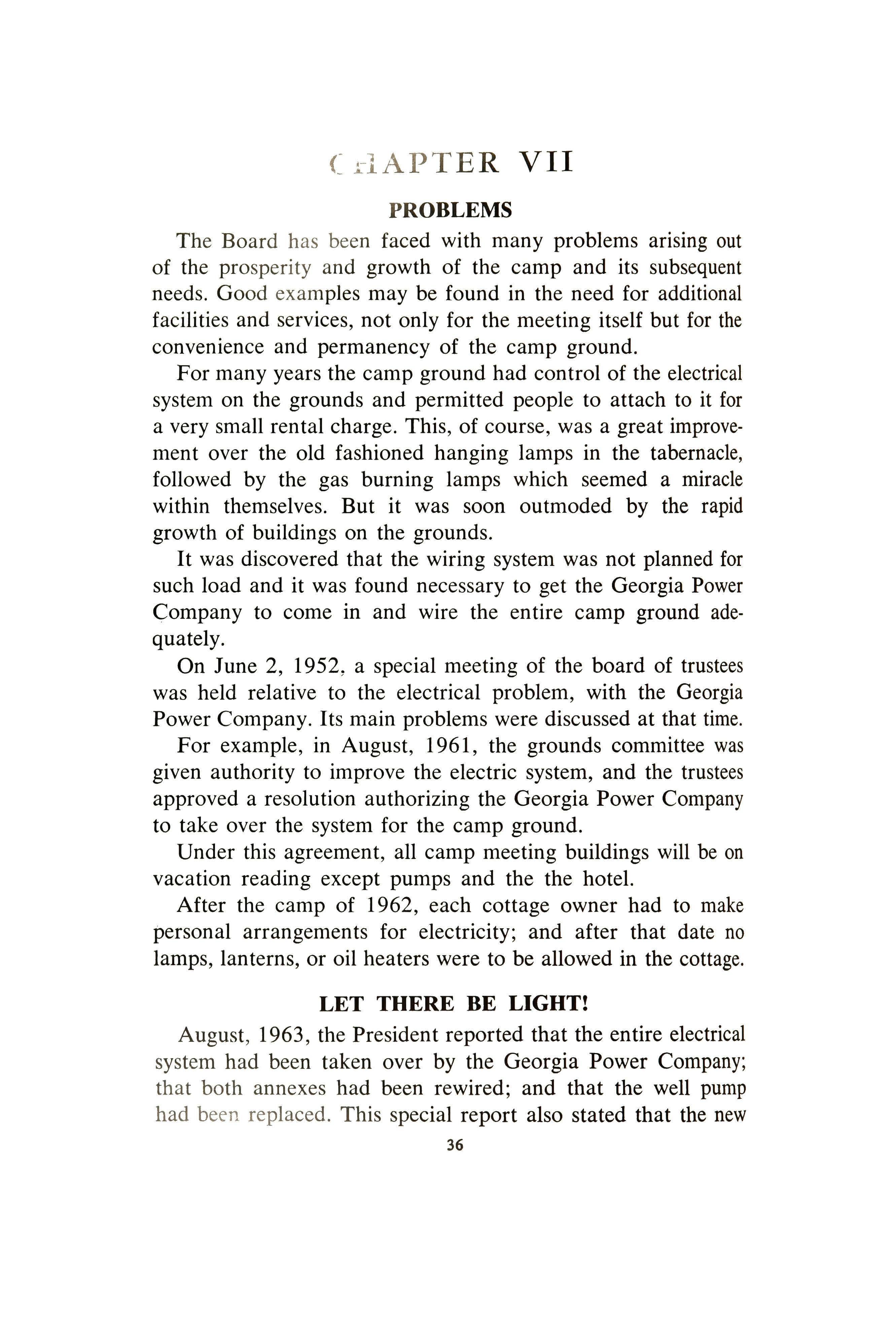
cafeteria had been completed and that forty hotel rooms had been built in the old dining room. He further reported that new roads had been built in several sections of the camp ground.
During the past few years this has been done and cottages have been able to connect directly with the Georgia Power Company and have sufficient electrical power for all purposes in their homes. This has been one of the outstanding achievements for the comfort of those who obtain it.
In 1963 the Board of Trustees agreed to put adequate street lighting facilities on the camp ground, with the lights to burn the year 'round. It was thought that this would add to the safety of the camp as well as for the convenience of those who come and go.
Throughout the year many people stop by the camp and drive through just to see "dear old Indian Springs Camp Ground."
At the December 13 meeting, 1962, the Board authorized Dr. Gamble to build a group of apartments on the grounds, to be sold to interested parties who might be approved by the board. Mr. Fuller was given permission to place ready-made cottages on the ground and rent them to people coming to the camp.
In one of his earlier reports to the board of trustees, Mr. McKibben stated that the camp ground had grown from 34 acres to a total of 145 acres; and that at that time had 135 buildings. This included, of course, all the cottages in addition to the main buildings owned by the camp ground.
In a special report to the Board in August, 1963, President McKibben reported that the valuation of the property owned by the camp ground at that time amounted to $326,700.

37
CHAPTER VIII PLAN OF OPERATION
Present Board of Trustees
Group Number One consisted of the following ministers: Paul Barrett, Ralph Day, R. 0. Edenfield, and Ralph Foster.
Group Number Two consisted of the following laymen: Joseph P. Luce, W. S. McKibben, Watson Mobley, and C. S. Newton.
Group Number Three consisted of J. 0. Fuller, B. C. Gamble, Frank Harris, and R. F. Lee. The latter two are laymen.
Group Number Four consisted of Mr. Walter Peabody, Ralph Smith, Dr. M. T. Thome, and Rev. Roland Walker. (See Picture, #18).
The Trustees of Indian Springs Camp Ground have had a heavy responsibility which they have accepted without question. When the constitution was amended in 1963, it was provided that no limit on the number of terms would be set for members to serve. The idea of staggering their election was to guarantee perpetuity without sudden radical changes.
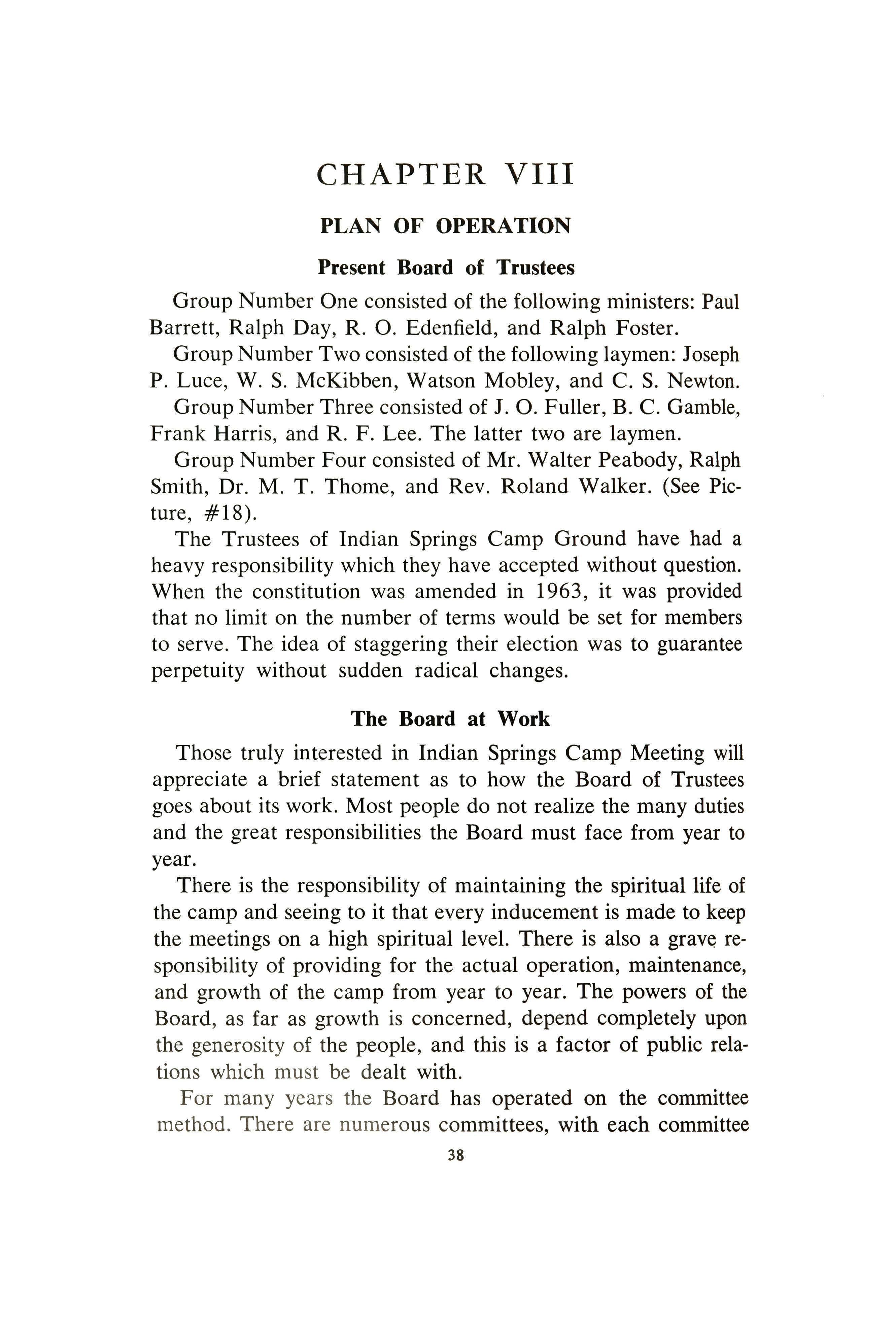
The Board at Work
Those truly interested in Indian Springs Camp Meeting will appreciate a brief statement as to how the Board of Trustees goes about its work. Most people do not realize the many duties and the great responsibilities the Board must face from year to year.
There is the responsibility of maintaining the spiritual life of the camp and seeing to it that every inducement is made to keep the meetings on a high spiritual level. There is also a grav~ responsibility of providing for the actual operation, maintenance, and growth of the camp from year to year. The powers of the Board, as far as growth is concerned, depend completely upon the generosity of the people, and this is a factor of public relations which must be dealt with.
For many years the Board has operated on the committee method. There are numerous committees, with each committee 38
 The Board of Trustees at the December meeting held in Jackson in 1964. Notice that all but two of the members were present.
The Board of Trustees at the December meeting held in Jackson in 1964. Notice that all but two of the members were present.
39
(Picture # 18.)
having a very definite responsibility. Let us look into the work of these committees, briefly.
The most important committee from the viewpoint of the spiritual life of the camp lies in the Pulpit Committee. This committee usually consists of three members with a chairman. It is a policy of the men involved to try to make the choice of speakers and singers unanimous.
The problem of finding the best preaching talent available for Indian Springs Camp grows greater each year. Many of the old-time camp meeting preachers have retired or died. The number entering the field each year does not multiply very rapidly. Among those who enter the evangelistic field, many of them are really not qualified for the special type of preaching needed at a camp meeting like Indian Springs.
The Pulpit Committee has to call preachers from two to six years ahead in order to get the right combination of men who can work together. It is their aim to maintain the high standards of holiness but at the same time to have preachers working together each camp meeting season who will complement and supplement each other, so that a full rounded gospel message will be heard by all the people.
The Committee on Prayer and Spiritual Life, working under the direction of the president, has the responsibility for maintaining the high quality of intercessory prayer in the early morning prayer meetings, and for the past few years, the all night prayer meetings that are held once or twice during each camp by order of the Board.
This committee or the president also lays special emphasis on the evening cottage prayer meetings which have been a traditional practice at Indian Springs practically all of its existence. Reports from these cottage prayer meetings from time to time are highly encouraging to the audience in the night sessions.
The Buildings and Grounds Committee has great responsibility because it is under the oversight of this committee that the problems of maintenance and construction are faced. Maintenance really is a big problem. As the camp grows from year to

40
year, the problem gets bigger and the expenses become heavier. There is a Committee responsible for the operation of the hotel and other rental facilities of the camp. This is a detail job which calls for work for many months prior to the actual meeting of the camp.
The operation of the Hotel and of Burden Memorial Hotel, the Lang Annex, the Pittman Annex, and other rooming facilities has been the responsibility of this committee to recommend to the Board from time to time. Plans for the future must be made months in advance and sometimes years in advance for living quarter facilities for people who desire to come.
With •the new Cafeteria there is now a Committee responsible for its operation. This committee has a big responsibility in securing dietitians, cooks, and other helpers. It also has the duty of seeing that proper supplies are purchased and on hand for the camp.
The cafeteria operation can become a matter of great concern, because it is the plan of the trustees not to try to make money from the cafeteria, but at the same time it should be operated so that no loss occurs.
The present cafeteria is modern and convenient, and with the fine service it has been rendering will probably grow rapidly in its service in the years to come.
As other problems arise, the president appoints new committees or additional committees in an efforts to keep the operation of the camp moving along successfully.
With this brief description, the reader can understand that the members of the Board of Trustees need the prayers and liberal fin•ancial support of each one interested in the camp, in the face of ever increasing need and responsibility which these men must face.

41
CHAPTER IX EXPANSION The Youth

When the youth tabernacle was built under the leadership of Dr. J. M. Glenn it was thought that all facilities necessary for the care of the young people were met. This building would house about 150 persons and had a conference room on each side of the pulpit. Later on emphasis began to be placed upon providing for the young people and special leaders were called to minister to them. This called for expansion in their behalf. (See first youth group under direction of Mrs. J. M. Glenn, Picture #19.)
Under the leadership of Mr. Lawrence Luce of Fort Valley, Georgia, there was first built a social center where young people could gather for recreation and refreshments between services. The growth of the interest in children and young people's work will certainly demand the building of further dormitories for them in the near future.
By 1952 it had become necessary to do something for the large groups of young people attending the camp. At its meeting, June, 1953, Mr. Lawrence Luce and Mr. Lawrence Houston were appointed as a committee to consider building a refreshment and recreation center for the youth. The usual opposition was raised against it on the grounds that it would ruin the atmosphere of the camp and turn it into a playground. This was disregarded, however, and a nice refreshment center was built on the grounds which originally were the stable grounds where the horses were housed and the buggies and wagons parked during the camp meeting session. (See Picture of Mr. Luce, #20.)
This particular area has recently been built up largely by the Luce family and their friends, and by Mr. Fuller, with his new type cottages bought ready-built to the ground.
From that time on, much emphasis has been laid on training the children and the young people, and interest has grown to 42

43
This is the only picture the writer could find of the first young people's group organized and led by Mrs. J.M. Glenn when Dr. Glenn was President of the Camp Ground and at the time when the first youth tabernacle was built. (Picture # 19.)
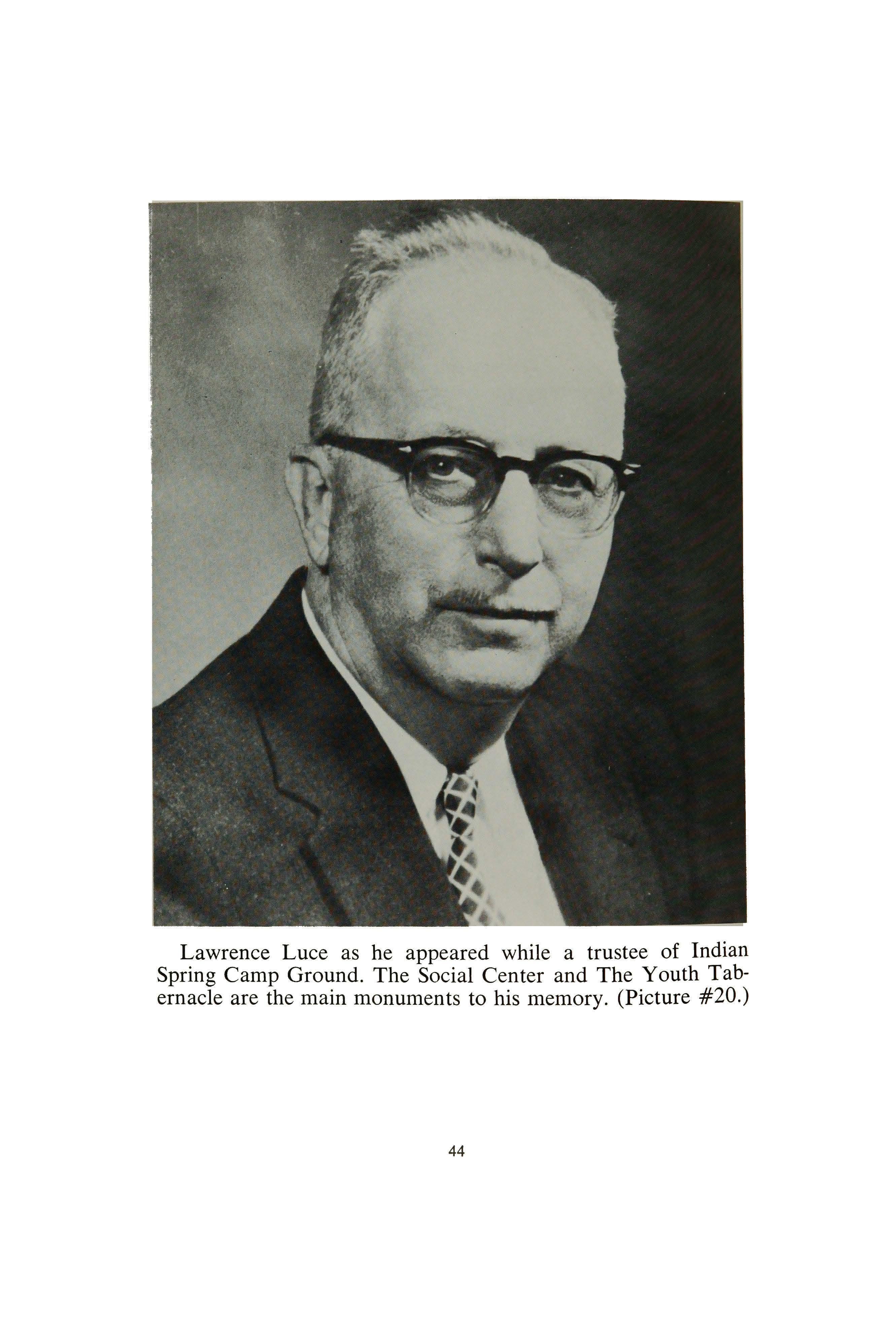
44
Lawrence Luce as he appeared while a trustee of Indian Spring Camp Ground. The Social Center and The Youth Tabernacle are the main monuments to his memory. (Picture #20.)
the point to where a special young people's tabernacle has been erected. This will be considered later.
When the youth tabernacle was built in 1958, at the December 3 board meeting of that year, the trustees decided that a youth dormitory near the tabernacle should be erected and plans were begun immediately to erect a boys' dormitory soon to be followed by a girls' dormitory.
Both of these buildings have been erected on the hillside near the youth tabernacle, thus making the program much more effective by the proximity of the living quarters to the worship area.
As early as August 15, 1955, Mr. Clarence Newton, Jr., reported to the Board that the young people had raised a thousand dollars for the new youth tabernacle. On the basis of this report, the Board decided to go ahead.

Ten acres on the west side of the camp ground was bought for $900.00 and the following year the youth tabernacle was constructed by Mr. A. L. Luce at a cost of more than $6,500.00. The Board approved a note to Mr. Luce for $5,000.00 to pay the balance due on the tabernacle and later reimbursed Mr. Luce for this amount.
As of this date, the youth area now has a lovely tabernacle constrcted of steel; a concrete block girls' dormitory and a concrete block boys' dormitory. It is very evident that these buildings will have to be expanded or additional ones erected in the near future, since the youth work has become so prominent in the camp. (See Picture #21.)
The Cafeteria
In 1963, a modern cafeteria building was erected, large enough to serve crowds of from 400 to 800 people within a very short period. The best equipment was installed.
°The building was so constructed that it is well ventilated and has the feel of an air conditioned room throughout the hot days.
The leading spirit of this construction was Mr. Frank Harris of Cartersville, Georgia. He was ably assisted by A. L. Luce of Fort Valley, Georgia. Both of these men are members of the 45

....... ri.- ··~ .'!.~ ~\
A picture of the Youth Tabernacle and the Girls' Dormitory taken in August, 1964. (Picture #21.)
46
The new cafeteria showing people standing in line at the noon hour. This picture was taken in August, 1964. (Picture #22).
Board of Trustees. The cost of the cafeteria was about $40,000.00. (See Cafeteria Pictures, #22-23.)
The A. L. Luce Cafeteria
On August 16, 1963, the trustees voted to dedicate the new cafeteria to Mr. A. L. Luce, Sr., who had been so prominent in the development of the youth work, and in the expansion of the camp ground including the cafeteria, the young people's facilities, and the disposal system.

The Dodge Memorial
Indian Springs Camp has had some unique housing developments, different from most camp meetings in America. One of these is the Dodge Memorial building. This is a two-story building which is a "parsonage" for ministers of all denominations who wish to attend the camp. (See Picture #24.)
For many years no charge was made for this accommodation. Also, for many years preachers were given their meals at half price.
They once had a custom of counting the number of preachers in attendance during the ten-day period, and the writer has been present when there have been more than three hundred present.
Soon after the camp started, a wooden hotel and dining room with fifty rooms was built. This replaced the "tent dining room" and tenting camps which originally centered around the area where this hotel now stands.
In 1940, a brick hotel was erected across the drive from the old hotel. This was built in honor of R. F. Burden and is known as the Burden Memorial. (See Pictures #25½-26½ .)
For many years there were two annexes consisting of 22 rooms each, which were placed back to back with a large porch on each side of the building. People would rent these for the season and bring their own equipment and "camp" in them.
Some of these rooms have been rented year after year to the, same parties and they have become a "camp meeting home" to these people.
A third annex was built of concrete blocks behind these two
47
This picture shows the youth workers and the main workers at their tables eating lunch in August, 1964. Seated with Mr. McKibben are: to his right-Roy Nicholson, Dr. and Mrs. Couchenour; to his left-John Church and wife and Clay Milby. The author took the picture. (Picture #23 ).

48
Dodge Memorial which has been a great asset throughout the years in encouraging pastors and other preachers to visit the camp meeting. It has been responsible for hundreds of these men attending the camp ground for at least part of the session each year. (Picture #24.)
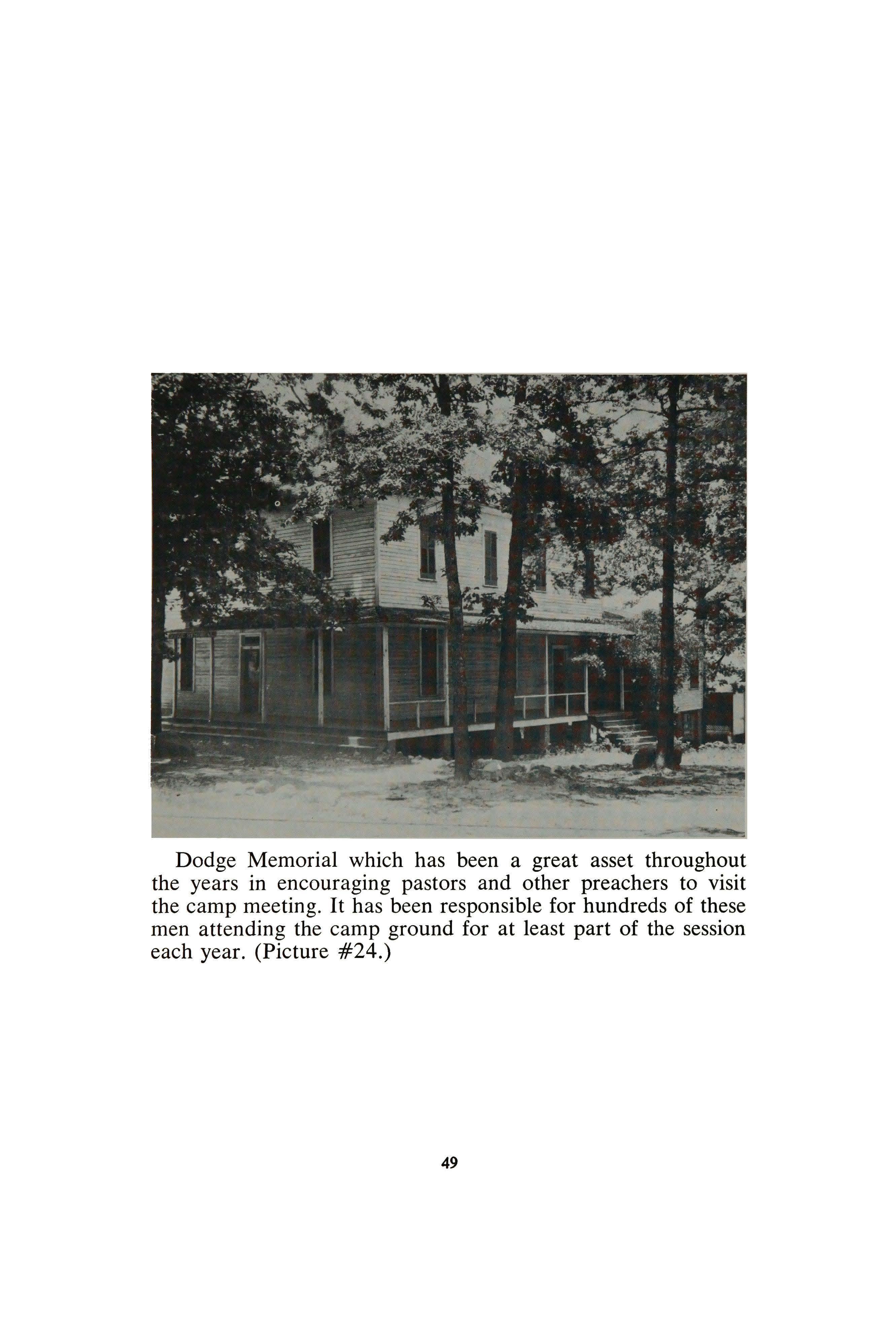
49
BOARD OF TRUSTEES
 R. F. BURDEN
J. S. BETTS
REV ,J 1\1. GLENN
T l. THROWER
Rev. M. D. SMITH
Rev. G. W. MATHEWS
Rev. JNO. L. LOFTIS
\Lo
Rev. W. II. BUDD and Rev. It P. !\tYERS, E111er1t11"
C. D. flLPIAN
T. W. HICK.8
W S. DAVIS
R. F. BURDEN
J. S. BETTS
REV ,J 1\1. GLENN
T l. THROWER
Rev. M. D. SMITH
Rev. G. W. MATHEWS
Rev. JNO. L. LOFTIS
\Lo
Rev. W. II. BUDD and Rev. It P. !\tYERS, E111er1t11"
C. D. flLPIAN
T. W. HICK.8
W S. DAVIS
50
The Board of Trustees 1915. (Picture #25.)
This is a picture of the dedication of the Burden Memorial, with Dr. H. C. Morrison in prayer. A large group of people assembled around the building for this occasion.

To Dr. Morrison's left is a picture of Dr. J. M. Glenn, president of the camp ground for a number of years.
Standing on the steps is Harry Blackburn who was a song leader for the camp meeting on this occasion. Since that time he has been a main preacher a number of times. (Picture #25½ .)
51
The Men who are responsible for the Campmeeting Music
Picture is self-explanatory except that it should be known that Mack Carnes has been orchestra leader at the camp ground for more than 50 years. This picture was taken on the twenty-fifth anniversary, 1915. (Picture #26.)
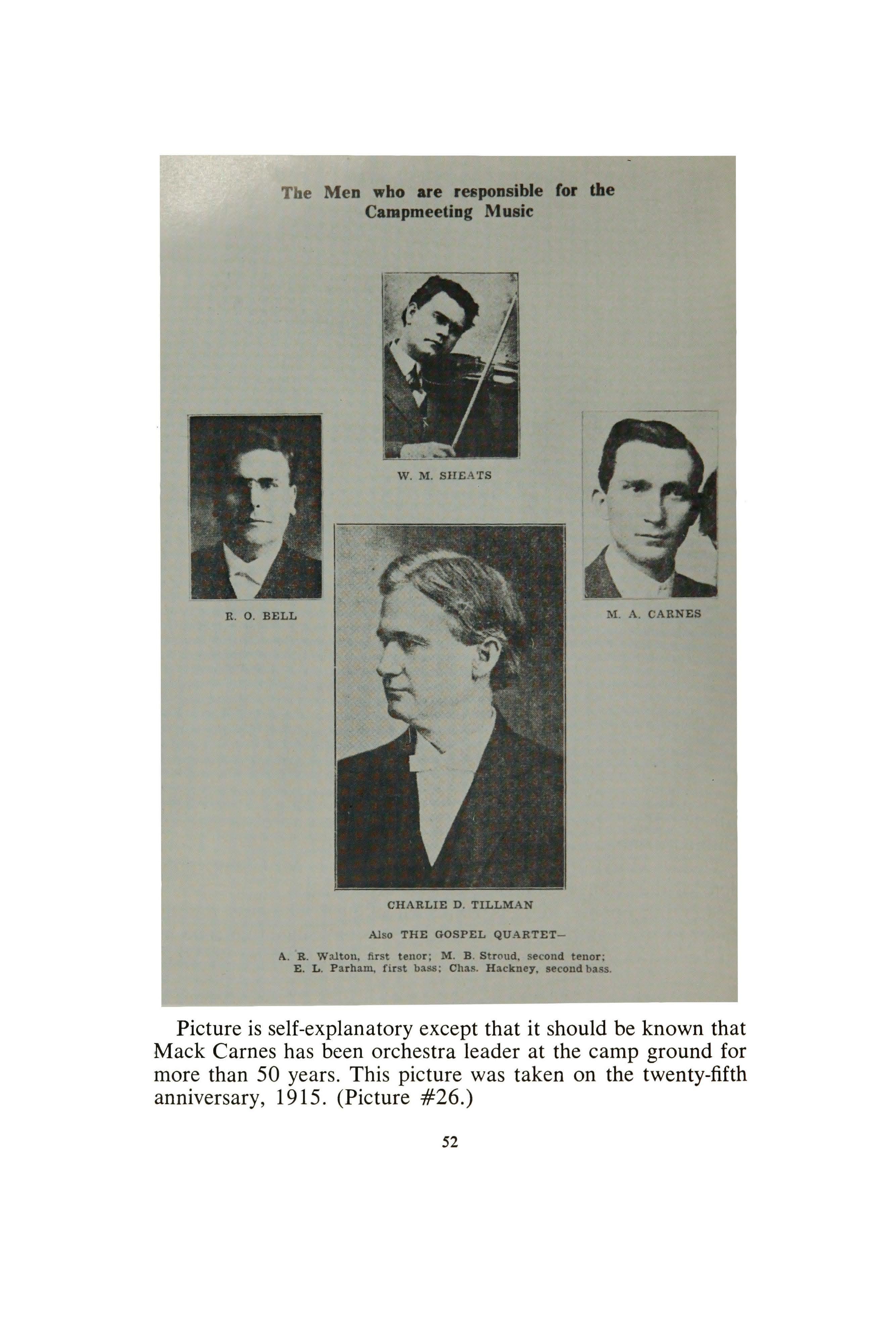 W. M. SHEATS
M.A. CARNES
CHARLIE D. TILLMAN
Also THE GOSPEL QUARTET-
A. R. Walton, first tenor; M. B. Stroud, second tenor; E. L. Parham, first bass; Chas. Hackney, second bass.
W. M. SHEATS
M.A. CARNES
CHARLIE D. TILLMAN
Also THE GOSPEL QUARTET-
A. R. Walton, first tenor; M. B. Stroud, second tenor; E. L. Parham, first bass; Chas. Hackney, second bass.
52
This picture shows some of the great crowds who thronged around the Burden Memorial and made a trip through it on the occasion of its dedication.
Prominent in the picture; the tall man on the left, seen between the two windows, was Sam Haynes who for many years was one of the leading supporters of the camp ground. He served on the committee on evangelism to call preachers for many years.
Sam was a great character who could not repress his emotions when "the fire fell" and he was not ashamed to give vent to them in praising and glorifying God. (Picture #26½ )

53
but facing the open spot, looking toward the tabernacle. This was built and named in honor of Mr. Pittman who was a longtime member of the board of trustees.
Reference has been made to the fact that the original size of the camp was ten acres, with fourteen acres being added shortly thereafter. The expansion of the acreage has been due to several problems.
One was to provide a parking area and camping facilities for ministers' families who desired to come for the ten-day period. In order to meet this need, the trustees bought the F. C. Benson farm across the road from the entrance to the camp ground, which consisted of three homes, a well, and several acres of ground. For several years these homes were used in addition to tents, parking trailers, and house trailers. (See Picture Mathews Memorial, #27.)

54
To
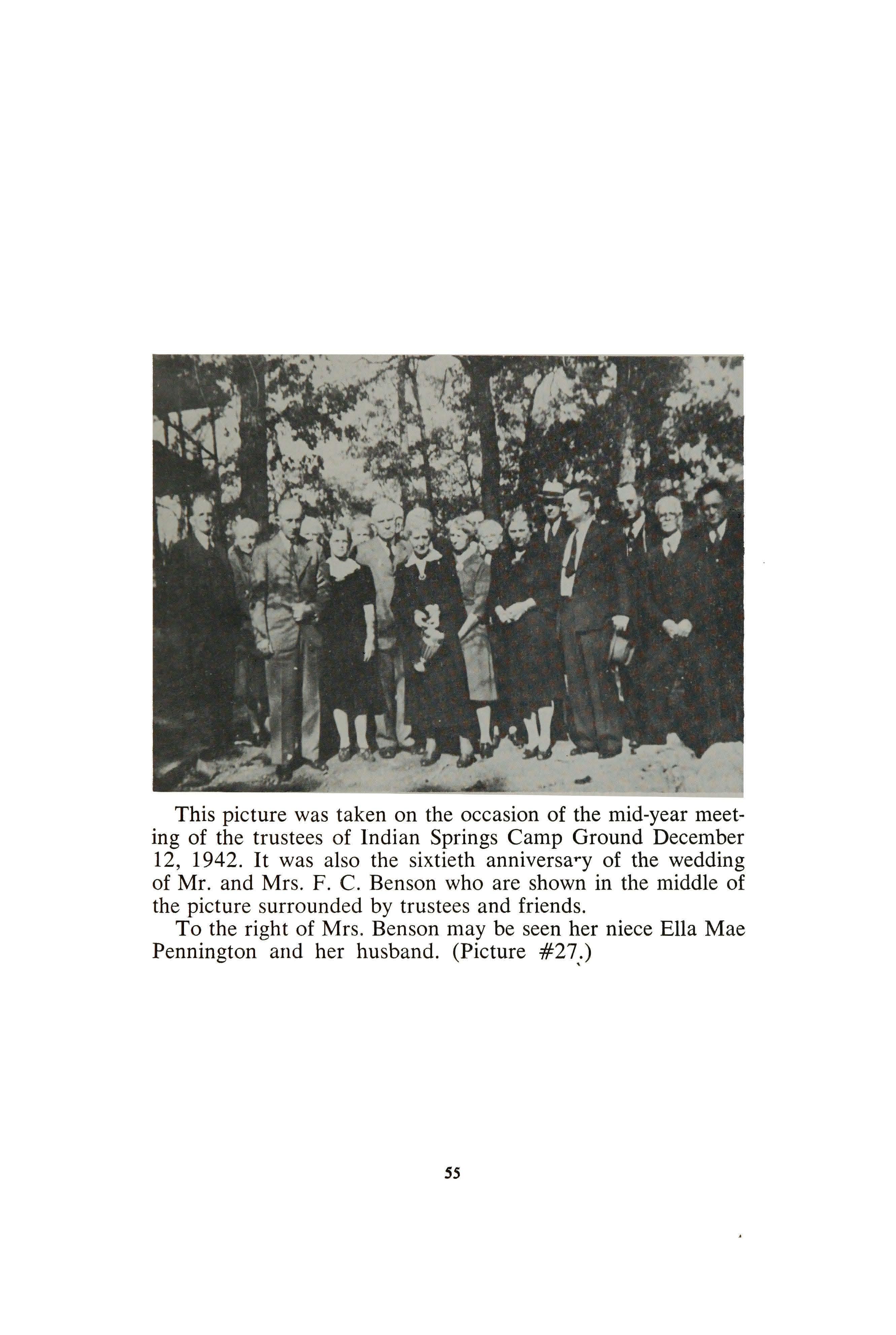 This picture was taken on the occasion of the mid-year meeting of the trustees of Indian Springs Camp Ground December 12, 1942. It was also the sixtieth anniversa~y of the wedding of Mr. and Mrs. F. C. Benson who are shown in the middle of the picture surrounded by trustees and friends.
This picture was taken on the occasion of the mid-year meeting of the trustees of Indian Springs Camp Ground December 12, 1942. It was also the sixtieth anniversa~y of the wedding of Mr. and Mrs. F. C. Benson who are shown in the middle of the picture surrounded by trustees and friends.
55
the right of Mrs. Benson may be seen her niece Ella Mae Pennington and her husband. (Picture #27)
CHAPTER X WATER
The water system has been a matter of great concern to the camp throughout the years. It was first furnished exclusively by "Betts Spring."
Later on as cottages were erected, they dug wells at various parts of the camp ground which supplied enough water for large families. This was not enough, however, when more houses were built and it was found necessary to hook up deep wells and pump water from them to a tank for general camp ground use.
It was found necessary to dig a deep well near the spring. This was done and an ample supply of water was found for the present.
Plans are now under foot, however, to build a large reservoir to catch a good supply of water to be held for use at the camp or to arrange in some other way to take advantage of the use of the spring which runs the year 'round and would easily fill a good size reservoir during the winter months.

In connection with the water and sewer system was the problem of the laying of pipes and sewer lines. The pipes had been laid above ground throughout the years since the camp was only used during the summer. This resulted in constant breakage from vehicles driving· over them and therefore many leaks came to be a great problem.
The matter of covering the water lines up throughout the years has been a constant interest of Mr. Raymond Edwards, the caretaker of the grounds for the past seventeen years. He has done a superb job in this respect and has placed the water system in the best position it has ever been since the first pipeline was made.
One of his pet dreams has been a large reservoir and possibly a new well with a pump large enough to give an adequate supply of water throughout the camp meeting without worrying over the possibility of a shortage while thousands of people are on the grounds.
One thing brings demand for another. A good water system
56
This is the original farm home of Mr. and Mrs. F. C. Benson. It was sold to the camp ground for headquarters for preachers' wives and their families who could not be accommodated on the main grounds.

The grounds surrounding it were used for tents, trailers, and campers for a number of years. When first purchased it was called Mathews Memorial honoring Dr. George W. Mathews.
(Picture #27½ .)
51
This picture indicates the nature of some of the work done by the early leaders of Indian Springs Camp Ground. In the forefront is Rev. W. A. Dodge, the first president of the camp.

Following him are Mr. Benson, one of the earliest and most energetic leaders in the camp, and Mr. Fargo, the first camp ground keeper.
They are walking through the woods where only a few houses had been built, making plans for the future growth of the camp.
(Picture #28.)
• --+No._l.Mr.For90 A"ee,1>erefl/lct.n. 1-1nds_;,,/Vo.2.Rrl/. l1.ADod9eAtlon/nt• ·.No.3.N,.,t~nnA-Bcn~on Maco~, 6n. -.,;r,./BOC~
58
 Mr. and Mrs. Edwards standing in front of the beautiful front yard of keeper's cottage. This picture was taken in August, 1964.
Mr. and Mrs. Edwards standing in front of the beautiful front yard of keeper's cottage. This picture was taken in August, 1964.
59
(Picture #28½ .)
This picture dates back to about 1916. It shows Mr. and Mrs. Benson with their dear friends, Dr. and Mrs. Charlie Babcock. Dr. Babcock spoke at Indian Springs Camp on more than one occasion. He also held revival meetings at First Street Methodist Church and at other points in Macon, Georgia, largely through the influence of the Bensons.
It was during a tent meeting held near First Street Methodist Church by Dr. Babcock, in 1913, when the author was inclined to think of the ministry or mission field as his call to serve. It was not until later~ however, that this call actually came. (Picture #29.)
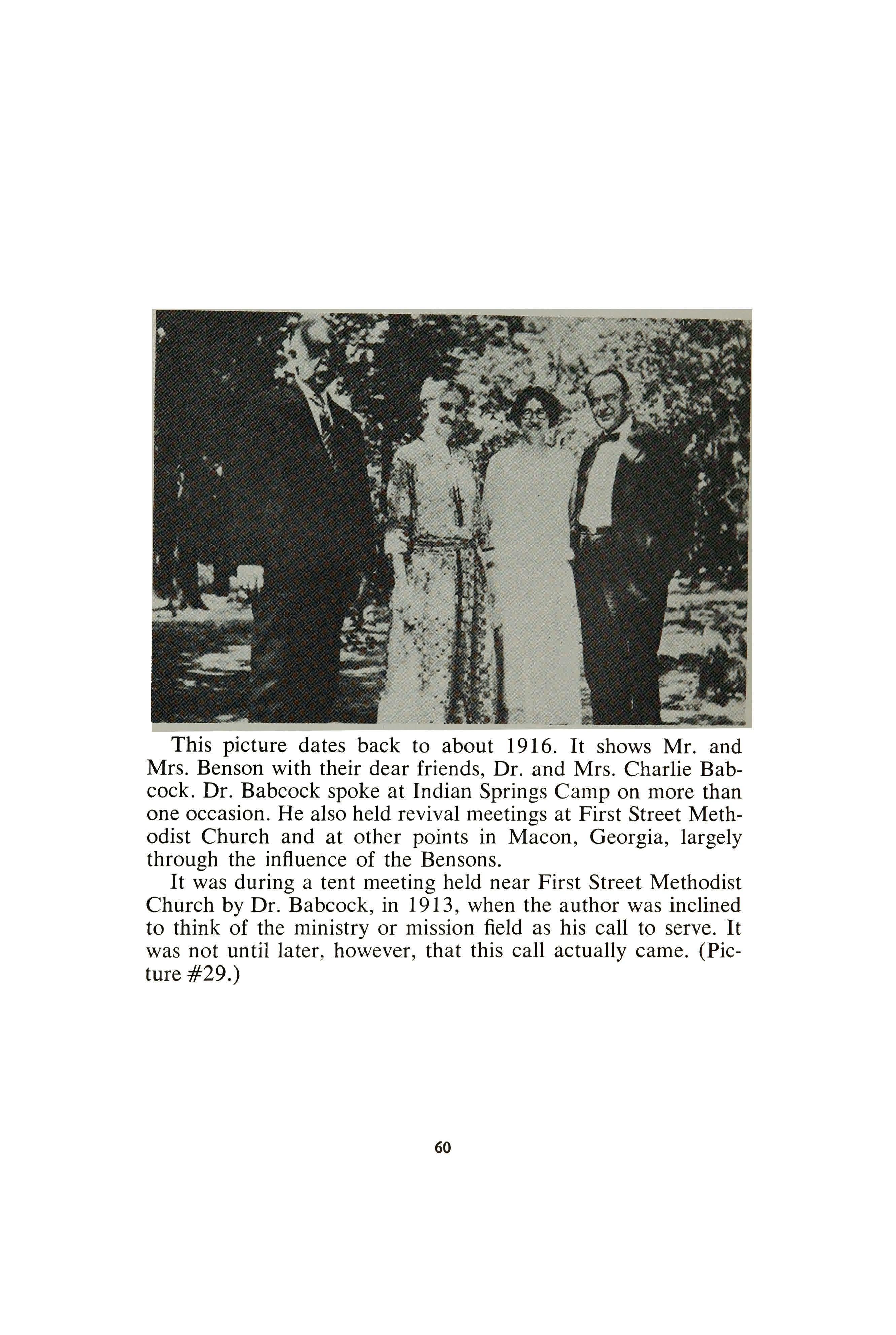
60

61
A view of the keeper's cottage which has been home of the caretakers of the camp ground for many years. (Picture #29½ .)
and increasing nur.1h:-c:;occupying the houses on the ground call for sewage facilities. This turned out to be an unusually thorny problem. It called for a huge and expensive project, but under the leadership of the board of trustees a sewage plant was built large enough to take care of thousands of people who attend the camp each year. The cost of this project was about $20,000.00.
Mr. Edwards also assisted in the supervision of the laying of sewer lines and has been of invaluable assistance in the handling of water and sanitary problems.

62
CHAPTER XI
The camp ground is sacred to multiplied thousands of people but it has not become sacred because of the grounds and buildings alone. It has become sacred because of people who have sponsored it, developed it, supported it, and prayer for it, and throughout the years sought and found the blessing of God upon it.
It would be impossible to mention adequately even a small number of those who have made outstanding contributions to the material and spiritual welfare of the camp, but the writer thinks that a few tributes should be paid on this 75th anniversary.
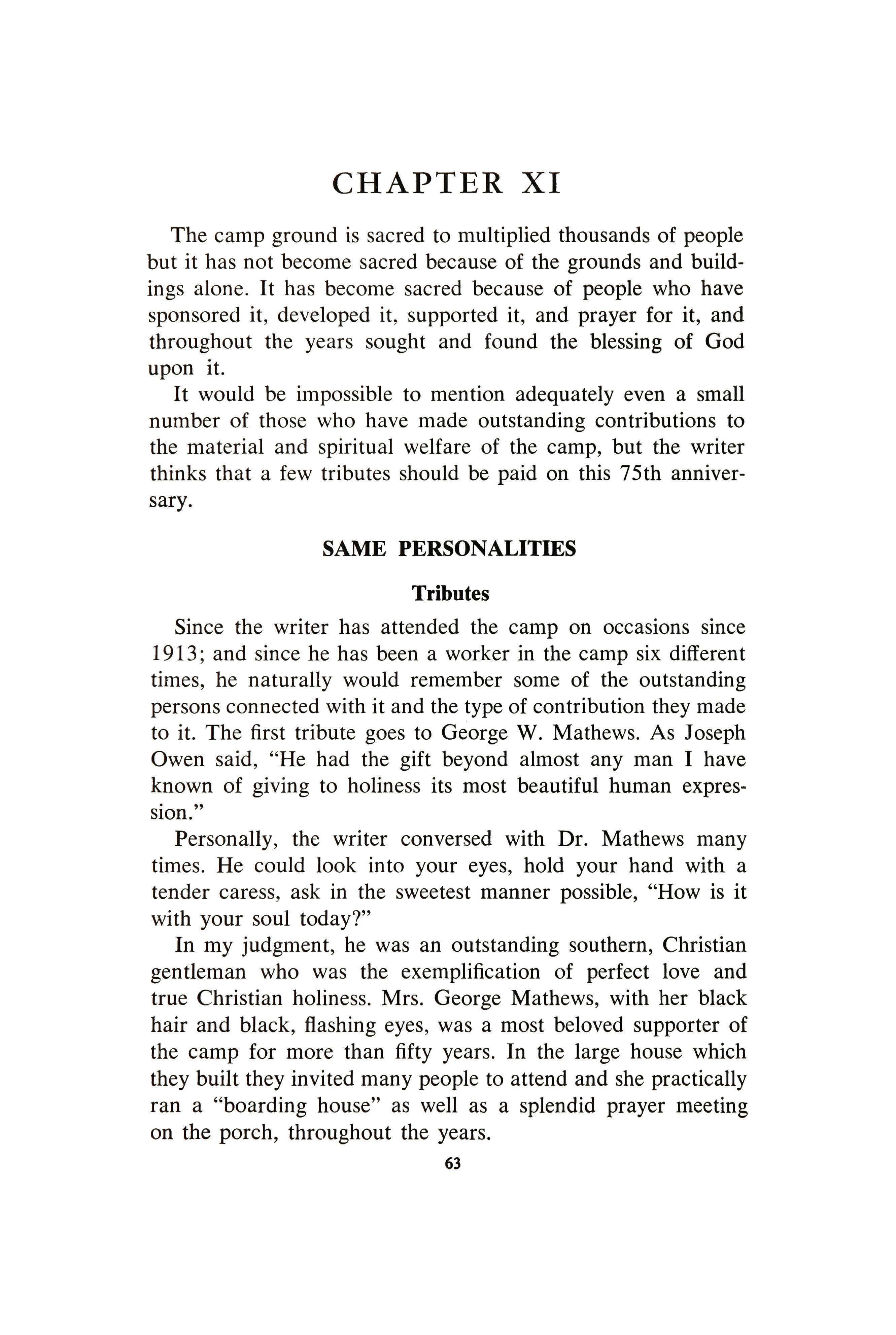
SAME PERSONALITIES Tributes
Since the writer has attended the camp on occasions since 1913; and since he has been a worker in the camp six different times, he naturally would remember some of the outstanding persons connected with it and the type of contribution they made to it. The first tribute goes to George W. Mathews. As Joseph Owen said, "He had the gift beyond almost any man I have known of giving to holiness its most beautiful human expression."
Personally, the writer conversed with Dr. Mathews many times. He could look into your eyes, hold your hand with a tender caress, ask in the sweetest manner possible, "How is it with your soul today?"
In my judgment, he was an outstanding southern, Christian gentleman who was the exemplification of perfect love and true Christian holiness. Mrs. George Mathews, with her black hair and black, flashing eyes, was a most beloved supporter of the camp for more than fifty years. In the large house which they built they invited many people to attend and she practically ran a "boarding house" as well as a splendid prayer meeting on the porch, throughout the years.
63
Her testimony during the lifetime of her husband at the Thursday morning cottage owners' hour, when pledges were made for the support of the camp for years to come, was always an outstanding one of praise and devotion. No one ever questioned the sincerity of her experience or the extent of her consecration to God.
Charlie Tillman 1 a man with a lovely voice and a sweet smile, was "the Charles Wesley" of Indian Springs Camp. People loved him for what he was. They revelled in his leadership as song evangelist and looked upon him as the proclaimer of glad tidings in the form of music.
One who saw him in later years will never forget his flowing white hair, his dignified manner, and his lovely smile as he directed the singing at the camp. (See Tillman Picture, #30.)
Frank C. Benson was a devoted layman. He was willing "to be nothing" for the Lord. For many years he had charge of the assignment of the annex rooms to those who applied. He always greeted the people with a hearty "God bless you" and smile of welcome.
He had a special seat on the left of the choir loft where he sat with a face beaming with the glory of God throughout the services. (See Picture of Mr. and Mrs. Benson, #31.)
He and Mrs. Benson built a large house which would accommodate quite a good many people, upstairs a dormitory style, and downstairs in private rooms. They ran a boarding house "for those who would come" for many, many years. It thus became a second home to a lot of people, particularly young people from the First Methodist Church area in Macon, Georgia. Their work was a labor of love for the cause of holiness.
Their niece, Mrs. Ella May Pennington, who stood by the Bensons faithfully throughout the years and took care of Mrs. Benson during the declining years, still carries on the Benson tradition in entertaining people in the "Benson Cottage."
Two outstanding Colored women became beloved fixtures in the camp. The first was Aunt Creasie, of Waynesboro, Georgia. She was, as one evangelist described her, "a saint bound in 64
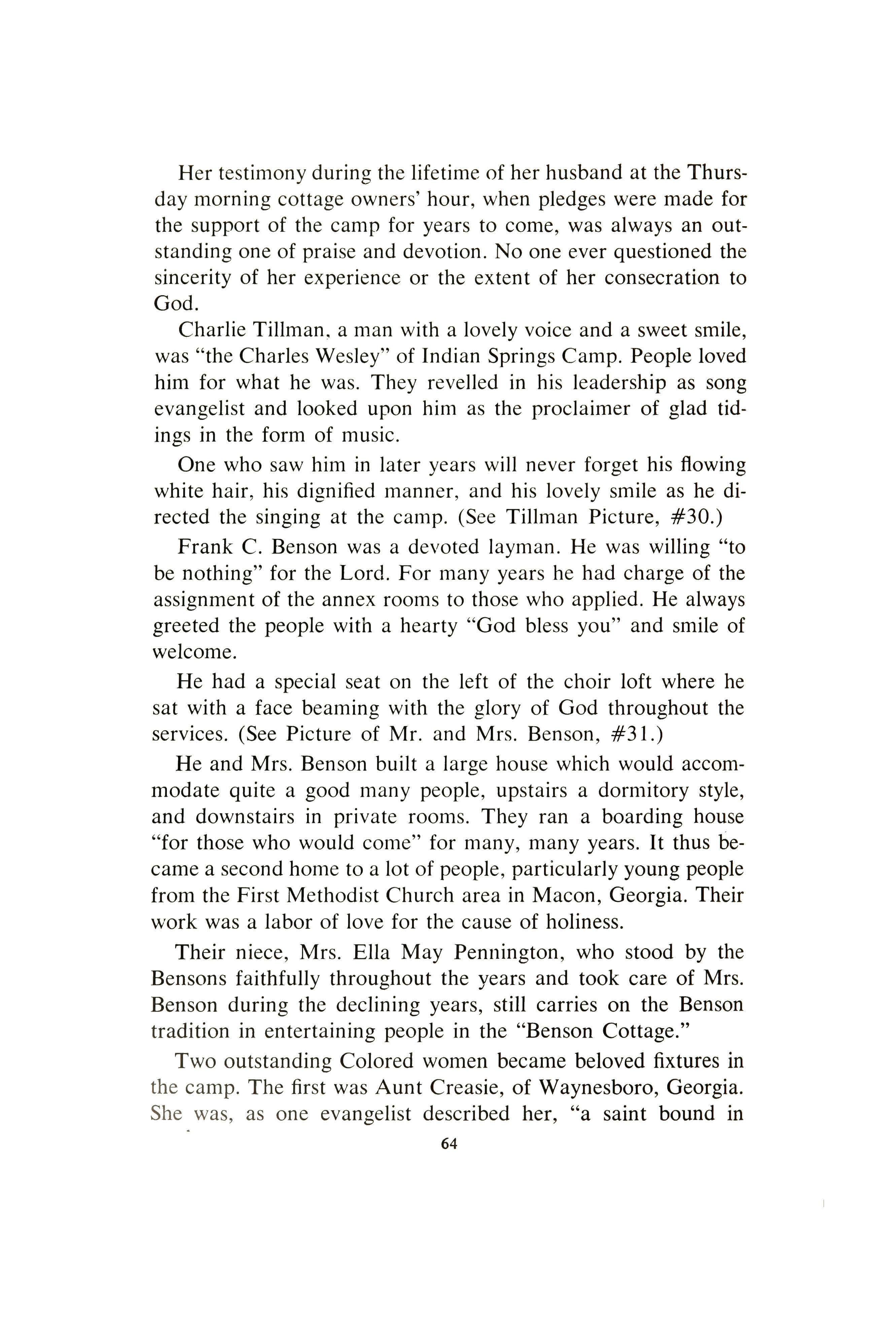
Shown above is a picture of the group surrounding the memorial stone that was erected honoring Dr. H. C. Morrison. Those who attend the camp frequently pause to read the inscription there in his honor.
This stone was erected during the presidency of Dr. Leonard Cochran of the South Georgia Conference. He is shown on the extreme right of the picture. Behind him are the faces of Sam Haynes and a group of friends who were standing nearby. Shown behind the stone are Dr. McPheeters, Mrs. Bettie Morrison.
In the picture also may be seen Harry Blackburn who has been song leader and evangelist at the camp meeting several times, and Paul Pappas who was a great admirer of Dr. Morrison. (Picture #30.)

65
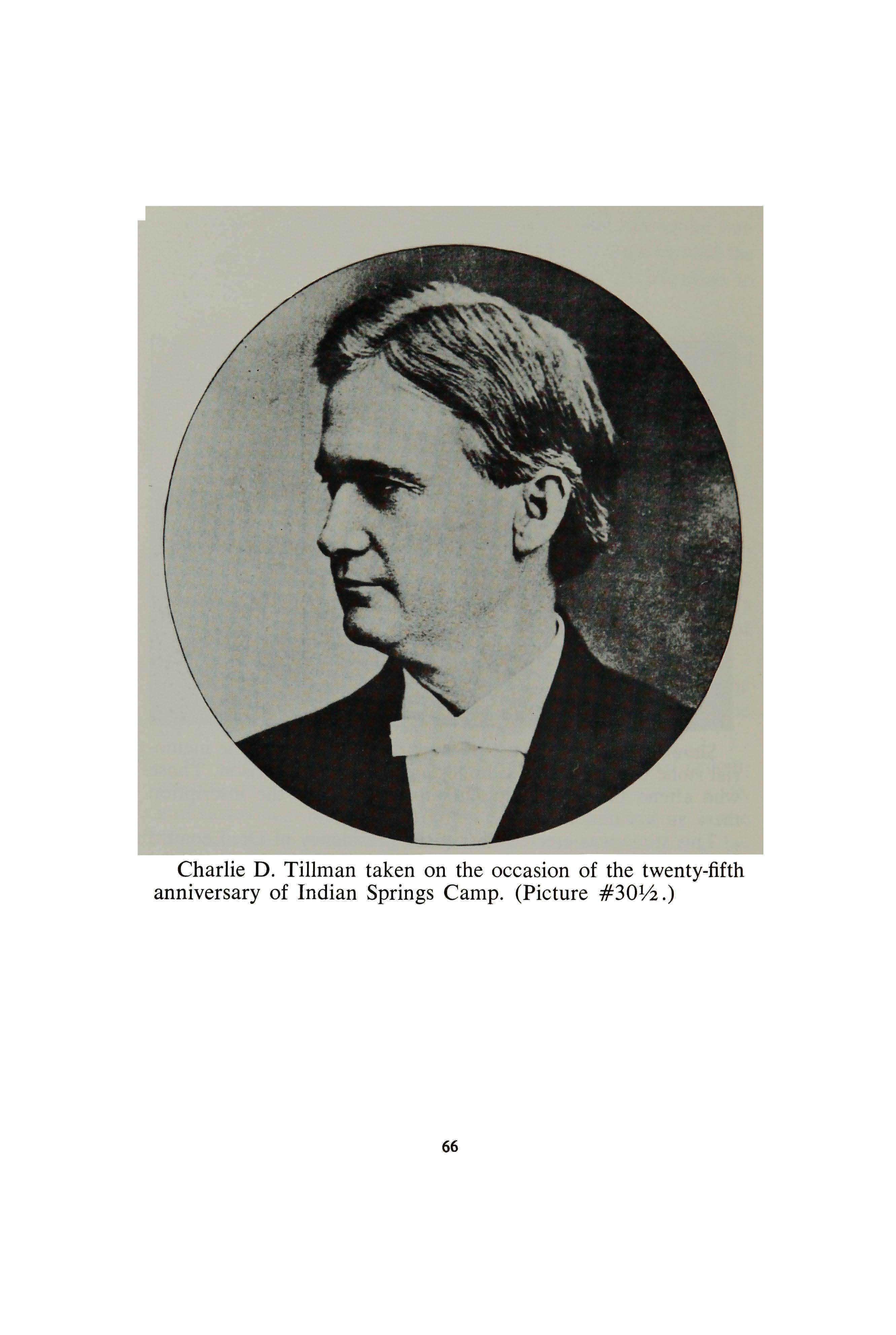
66
Charlie D. Tillman taken on the occasion of the twenty-fifth anniversary of Indian Springs Camp. (Picture #30½.)
This is the way the Hotel looked in August, 1964. From its beginnings of one building, it has been enlarged by three wing additions. Not shown in the picture but at the extreme right of this picture is the Lang Memorial addition honoring Mr. Lang, long-time friend and supporter of the camp ground. (Picture #31.)
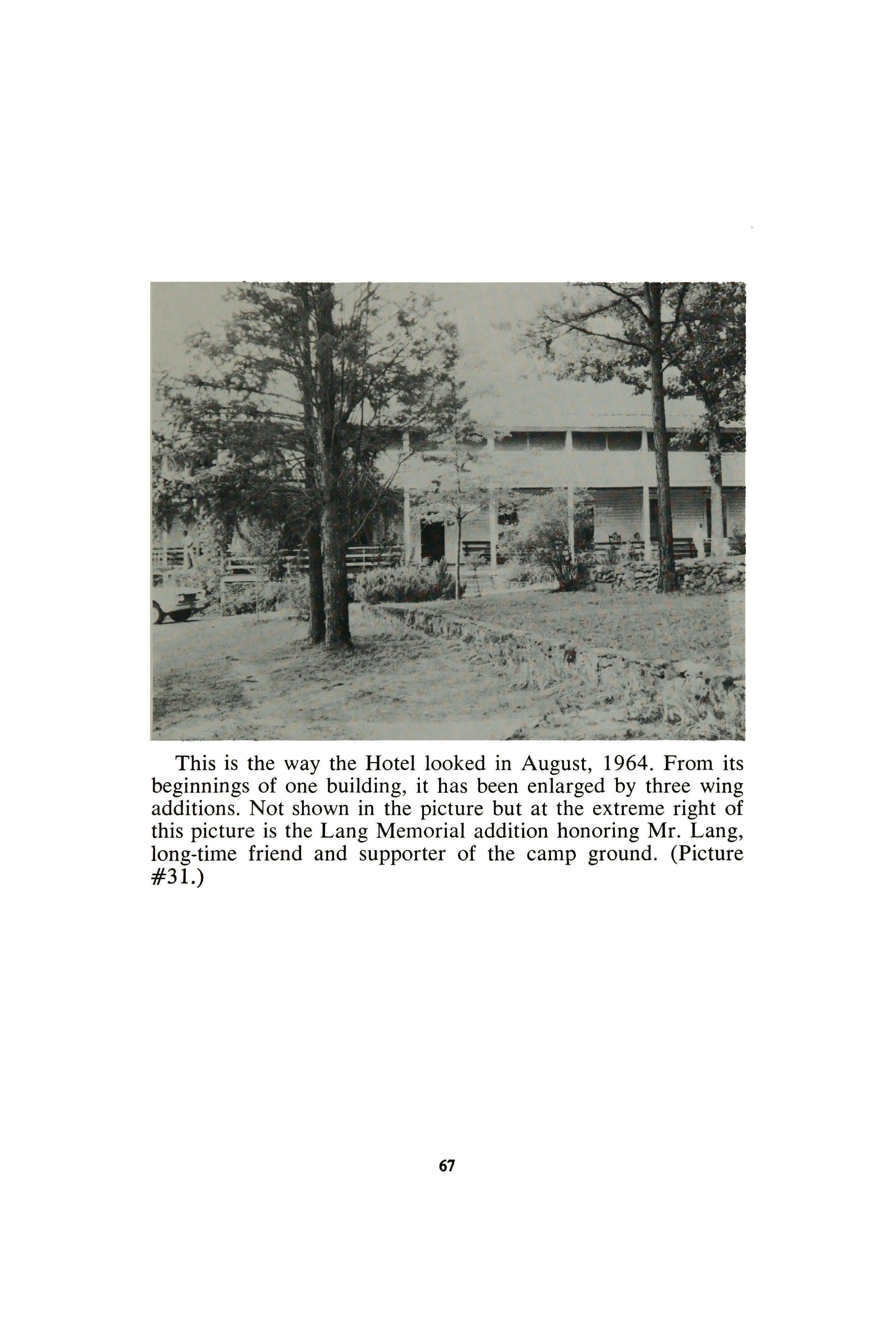
67

68
Mr. and Mrs. F. C. Benson on the occasion of their 60th. Wedding Anniversary-December 12, 1942. (Picture #31 ½ .)
The morning service is over and the crowd is waiting for the dinner bell to ring (it was really an old fashioned dinner gong rung vigorously by the head waiter for the hotel manager, announcing that the meal was ready).
This was a time of great social enjoyment when the people talked over the "great sermon" or the great service or the wonderful blessings of God. (Picture #32.)
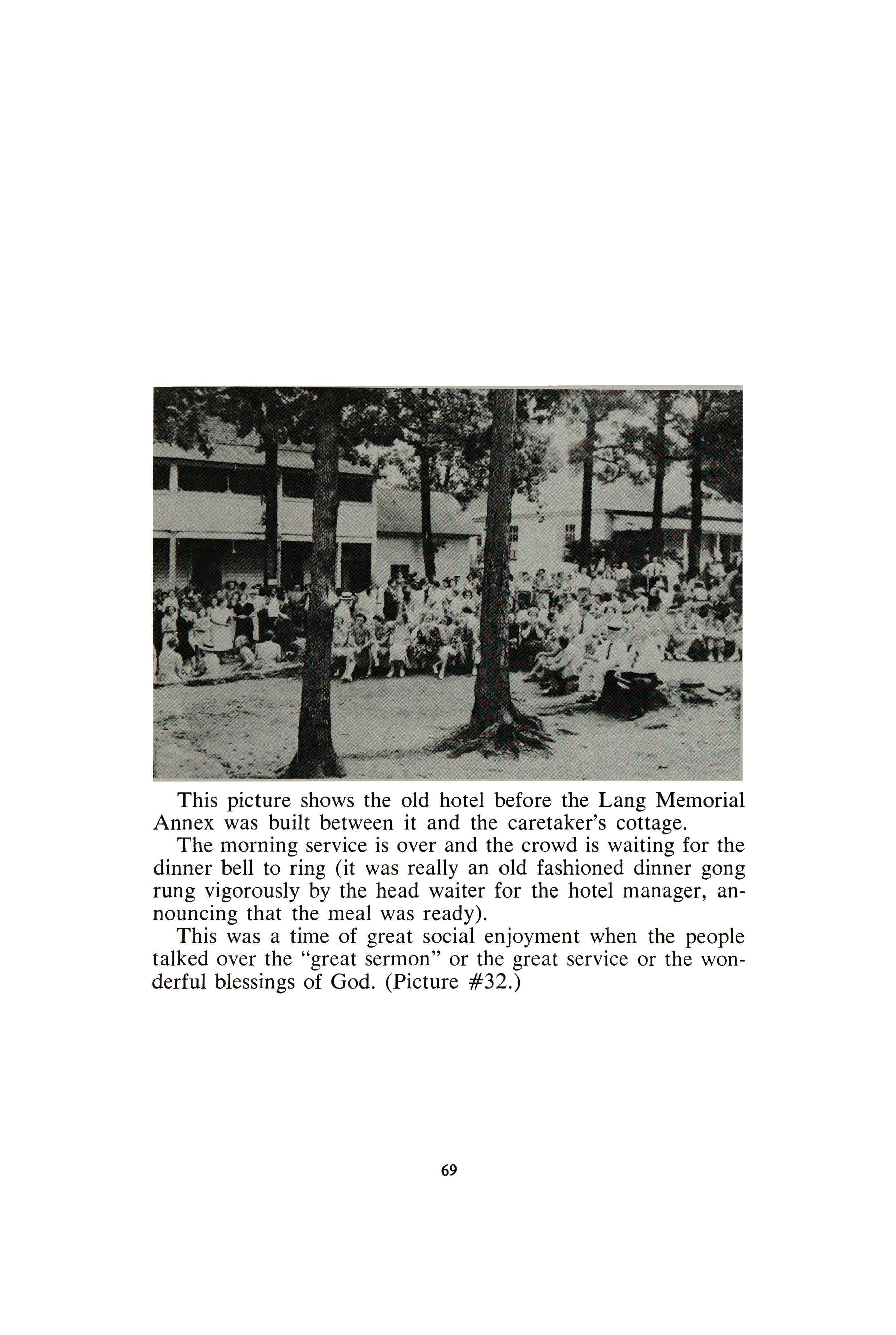 This picture shows the old hotel before the Lang Memorial Annex was built between it and the caretaker's cottage.
This picture shows the old hotel before the Lang Memorial Annex was built between it and the caretaker's cottage.
69
black." She would attend the services, beginning with the early prayer service in the tabernacle and concluding with assisting in prayer around the altar at night. She was never known to leave the tabernacle while a seeker was at the altar.
Many white people were "prayed through" by this humble servant whose humility of spirit and whose glowing testimony was such a blessing.
The writer heard her say, on more than one occasion, "When I came to camp I bought two tickets, one for here and back home-another for my home up there if the train doesn't make it." She would usually conclude this with clapping her hands and praising God for His many blessings. (See Picture of "Aunt Creasie, #32½ .)
The other Colored woman was Eliza Wingfield from Augusta, Georgia. She came to the camp for many years. In later years she suffered from rheumatism and came to the camp leaning on a heavy stick.
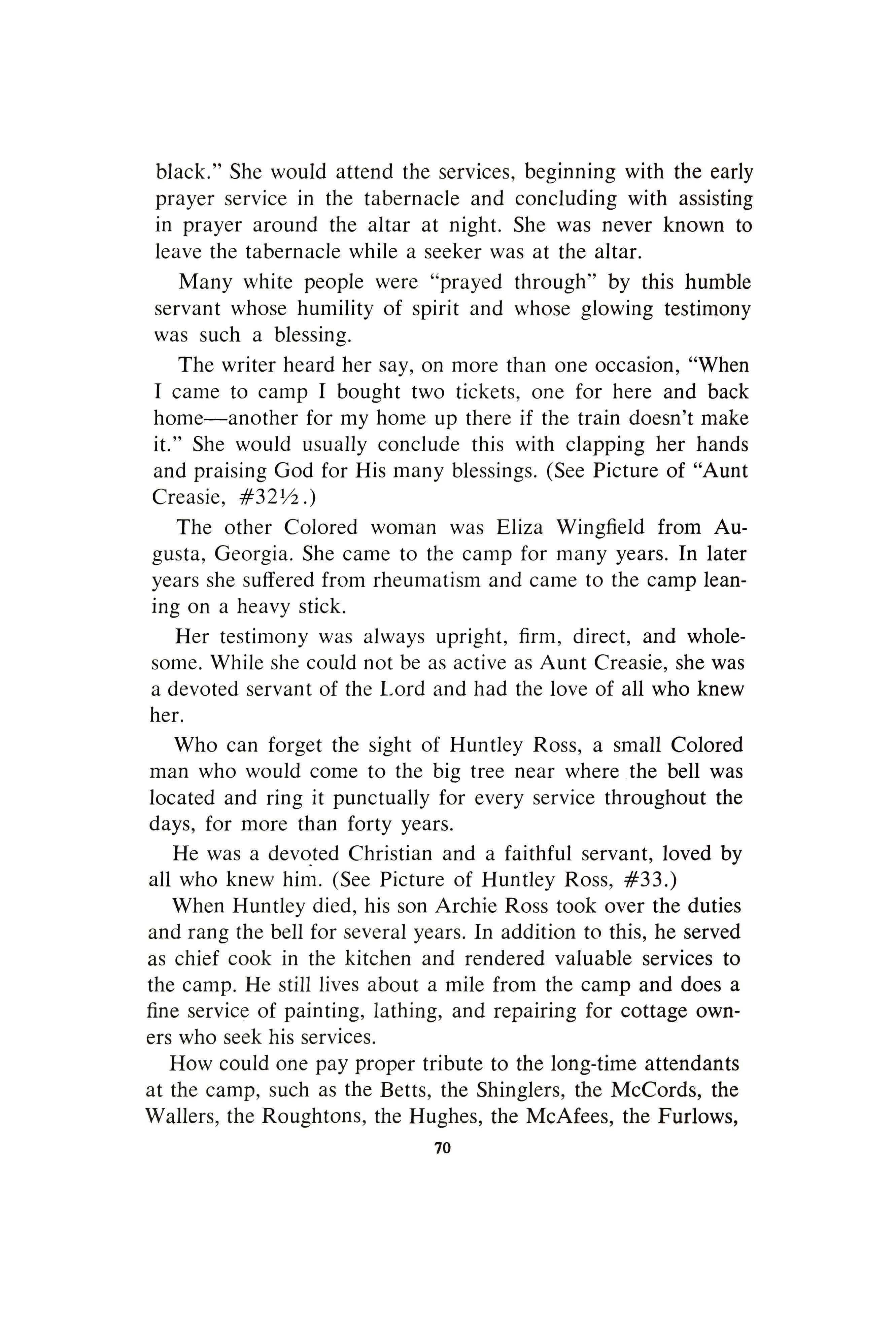
Her testimony was always upright, firm, direct, and wholesome. While she could not be as active as Aunt Creasie, she was a devoted servant of the Lord and had the love of all who knew her.
Who can forget the sight of Huntley Ross, a small Colored man who would come to the big tree near where the bell was located and ring it punctually for every service throughout the days, for more than forty years.
He was a dev~ted Christian and a faithful servant, loved by all who knew him. (See Picture of Huntley Ross, #33.)
When Huntley died, his son Archie Ross took over the duties and rang the bell for several years. In addition to this, he served as chief cook in the kitchen and rendered valuable services to the camp. He still lives about a mile from the camp and does a fine service of painting, lathing, and repairing for cottage owners who seek his services.
How could one pay proper tribute to the long-time attendants at the camp, such as the Betts, the Shinglers, the McCords, the Wailers, the Roughtons, the Hughes, the McAfees, the Furlows, 70
Aunt Creasie with her victory salute which she used frequently when greeted by people on the grounds. This meant to her that she was always looking up because some day she expected to go up to be with the Lord forever. (Picture #32½ ).

71
This is a partial view of the tabernacle as it looked in 1964, looking at it from the west side.

Note the vents on top of the roof. These were not shown in the other two pictures of the tabernacle. This is one of the great improvements that add to the comfort of the people, when the vents were installed to allow the hot air to escape from the central portion of the building.
Dr. B. C. Gamble happened to walk by and look toward the tabernacle just as the picture was snapped. (Picture #33.)
72
the Smiths, the Wards, the Jones, the Rountrees, and many, many others?
In later years, those who have contributed greatly to the camp have been the Lawrence Luce family and the families of his three energetic and devoted sons, George, Buddie, and Joe. These have done an outstanding job in helping in the physical development of the camp, as well as with the spiritual leadership.
We would include others such as the Newtons, the B. C. Gamble family, Mr. and Mrs. Harris, Cartersville, Georgia, Mr. Sims of Orlando, Florida, and the W allers, Bertie Odum, Susie Stephens, Mrs. Rodgers, Mrs. "Red" Jones, the Luces, Sam Haynes, and many of the young preachers of the South and North Georgia Conferences who have rallied around the camp and who are now rendering yeoman service either as members of the board, assistants in the youth work, or as faithful and regulars attendants. The names of some of these will appear under the picture of the current board of trustees.

Mr. and Mrs. Raymond Edwards came to the camp ground as caretakers, June 15, 1948. During their oversight, many improvements have been made.
In 1948, practically all the water lines were lying above ground. These have not only been buried but were replaced with new pipes and with larger ones to care for the supply.
In 1950 a large tank was installed near the Mathews Cottage to provide an extra supply of water while the camp was in session, since the camp depended upon the large spring from which the water was taken.
As the camp grew, it became apparent the spring was not sufficient to supply the needs, so in 1957 a deep well was dug, and it along with the spring, plus one well on the camp ground, has been supplying the water since that time. Each year, however, there has been fear that the supply would not last, because of the increased use of water, due to the improvement of current buildings and the addition of extra ones.
An interesting but important thing happened in 1945 when 73
Huntley Ross was a faithful bell ringer at Indian Springs Camp for more than forty years. He was faithful to his task and a friend to all who came to know him. (Picture #33½ .)
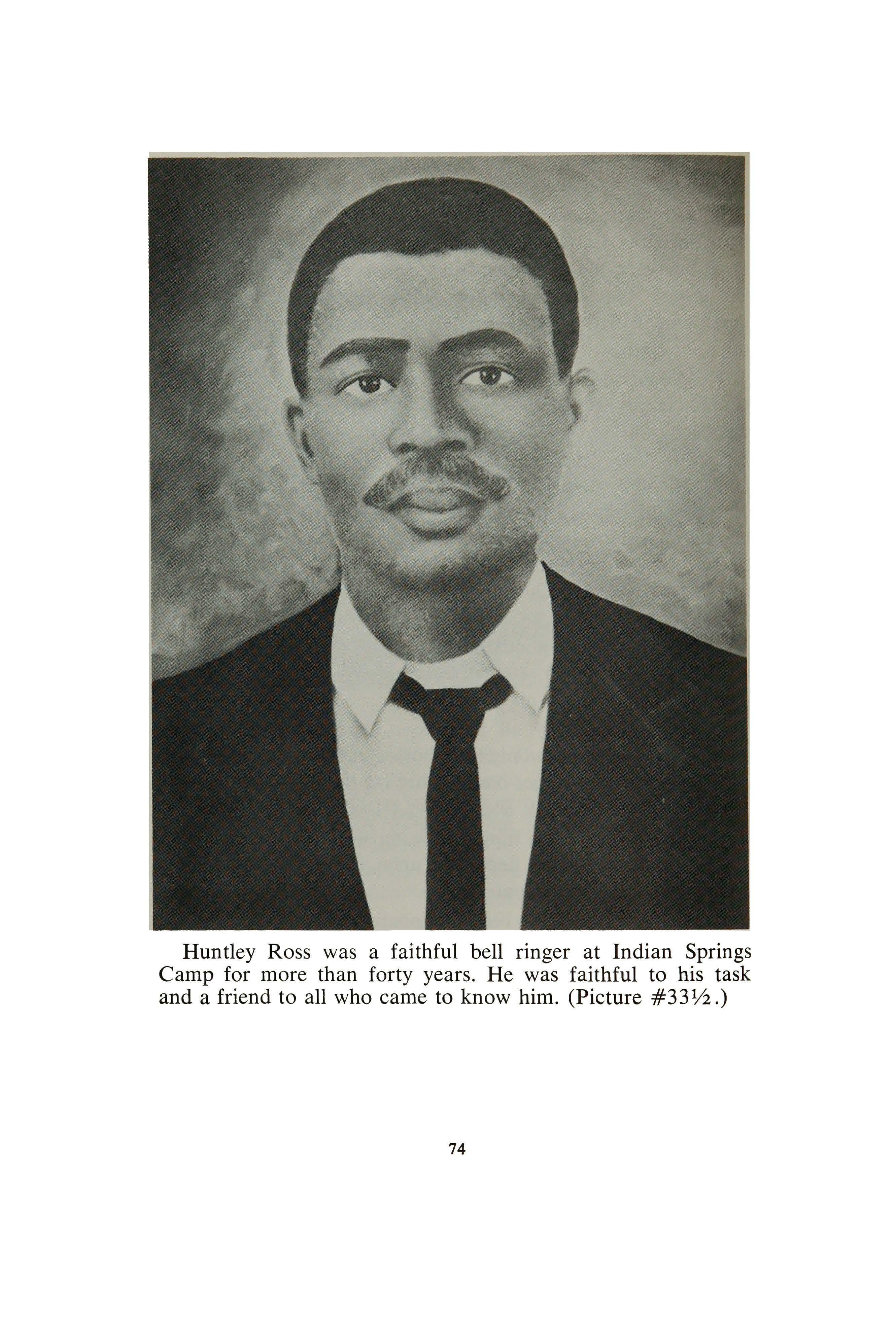
74
the disposal system was constructed to take care of the sanitary needs of the camp. This has proved to be a great benefit in that it allowed patrons to install bathrooms where it had been impossible prior to that time.
Mr. Edwards has personally assisted in the building of the Pittman Annex, the new Cafeteria, the two youth dormitories, the youth tabernacle, and other smaller buildings.
He has personally done or directed the improvement of the workers' cottages, the old hotel, and has added many facilities to some of the old buildings.
Mr. Edwards assisted Dr. Gamble in the building of the Benson Annex which is a lovely efficiency apartment type of building erected in memory of Mr. and Mrs. F. C. Benson, long-time friends and supporters of the camp.
This project was sponsored and largely paid for by Dr. B. C. Gamble. He secured assistance from various friends to furnish the cottage and gave them credit for this. These names can be found on the doors of the rooms which they furnished. (See Picture of Benson Annex, #34.)

15
The building consists of 12 efficiency apartments and is rented each year to couples who desire a small but adequate place for the camp meeting.
Mr. and Mrs. Benson claimed never to let a day go by without praying for Beverly Gamble, Gordon Rainey, and the writer.
 This picture of the Benson Annex shows the Motel type of efficiency apartment building erected largely through the contributions and efforts of Dr. and Mrs. B. C. Gamble, in honor of Mr. and Mrs. F. C. Benson.
This picture of the Benson Annex shows the Motel type of efficiency apartment building erected largely through the contributions and efforts of Dr. and Mrs. B. C. Gamble, in honor of Mr. and Mrs. F. C. Benson.
76
(Picture #34.)
CHAPTER XII
THE LADIES AUXILIARY
In 1911 it was decided that ladies should take on some responsibility for the needs of the camp, so they organized the Ladies Auxiliary which has been in operation ever since that time. The early leaders were: Mrs. J. W. Mathews, Mrs. Betts, Mrs. Ward, Mrs. Garbutt, and Mrs. F. C. Benson. Mrs. John A. Pennington has been treasurer since 1940 and has done a splendid job in assisting with this work.
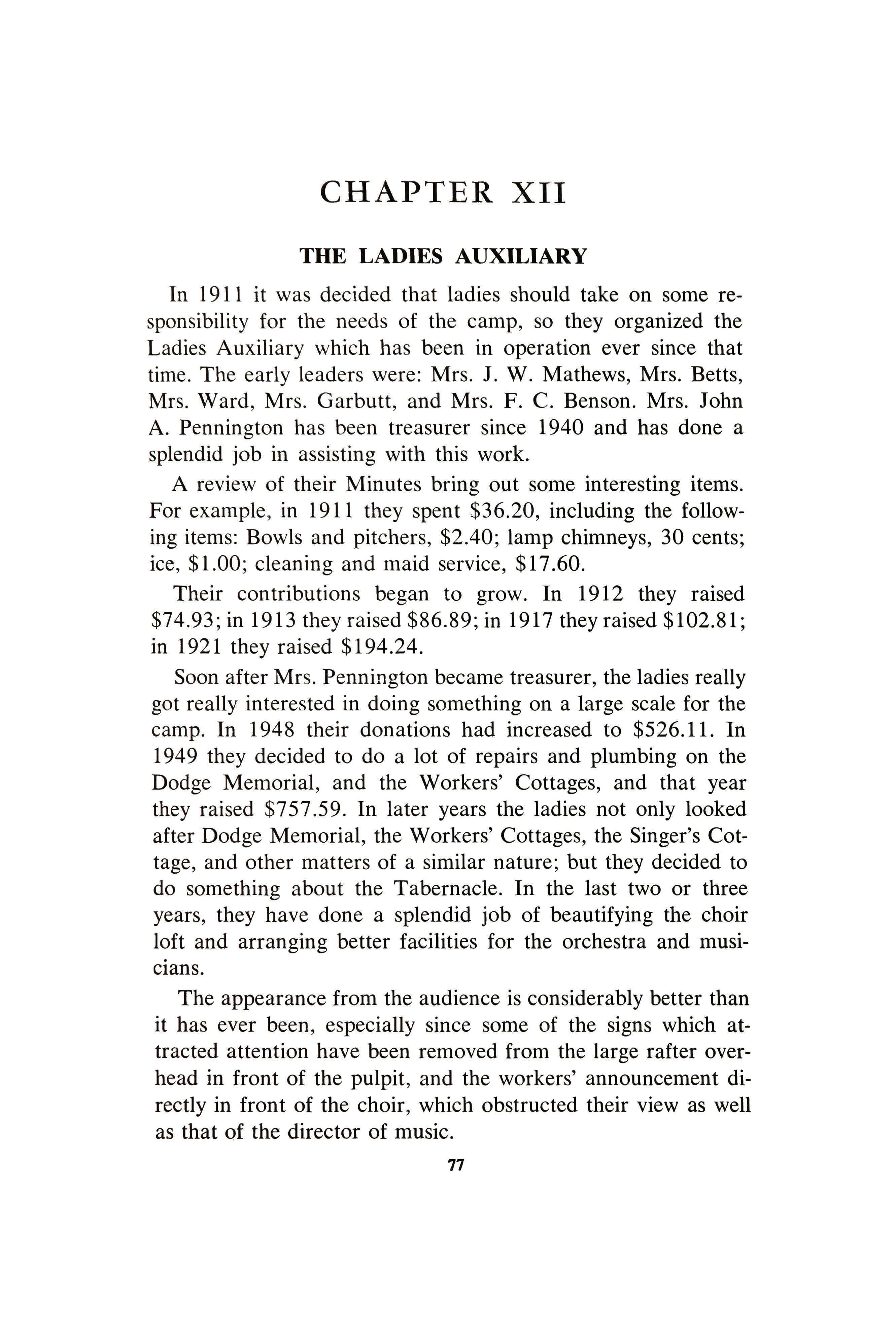
A review of their Minutes bring out some interesting items. For example, in 1911 they spent $36.20, including the following items: Bowls and pitchers, $2.40; lamp chimneys, 30 cents; ice, $ 1.00; cleaning and maid service, $17 .60.
Their contributions began to grow. In 1912 they raised $74.93; in 1913 they raised $86.89; in 1917 they raised $102.81; in 1921 they raised $194.24.
Soon after Mrs. Pennington became treasurer, the ladies really got really interested in doing something on a large scale for the camp. In 1948 their donations had increased to $526.11. In 1949 they decided to do a lot of repairs and plumbing on the Dodge Memorial, and the Workers' Cottages, and that year they raised $757.59. In later years the ladies not only looked after Dodge Memorial, the Workers' Cottages, the Singer's Cottage, and other matters of a similar nature; but they decided to do something about the Tabernacle. In the last two or three years, they have done a splendid job of beautifying the choir loft and arranging better facilities for the orchestra and musicians.
The appearance from the audience is considerably better than it has ever been, especially since some of the signs which attracted attention have been removed from the large rafter overhead in front of the pulpit, and the workers' announcement directly in front of the choir, which obstructed their view as well as that of the director of music.
77
THE FIFTIETH ANNIVERSARY
At the 50th anniversary celebration, one of the most interesting items that occurred was the request for a compilation of the old songs liked most by most of the people who attended the camp. As a result of this, Mrs. F. C. Benson was asked to compile a list of these songs.
The writer found the song book which was used at that time and the list of songs which Mrs. Benson compiled as being the most requested. The list was as follows:
1. Honey in the Rock
2. Where the Healing Waters Flow
3. Sweeter Than All
4. Thou Thinkest, Lord, of Me
5. Sweet Will of God
6. The Cloud and the Fire
7. Lord, I'm Coming Home
8. Feasting With My Lord
9. Christ Is All
A special song book was compiled for this occasion, which included not only these songs but many others which had been sung throughout the fifty years of the camp meeting, but particularly including Amazing Grace and There Is a Fountain Filled with Blood. (See A Tabernacle Scene, #35.)

78
This is a tabernacle scene taken while Dr. Morrison was preaching. It shows the choir group in the old choir loft before it was redecorated by the Ladies Auxiliary.
One can also see the piano and orchestra pit on a level with the floor, which in the last few years has bee nraised to the level of the pulpit, which makes for much more efficiency in the music.
Note the list of workers for the next year, 1942. They are listed as: Bishop Arthur J. Moore, Dr. H. C. Morrison, Dr. Lloyd Nixon, and Dr. E. R. Overly. (Picture #35.)
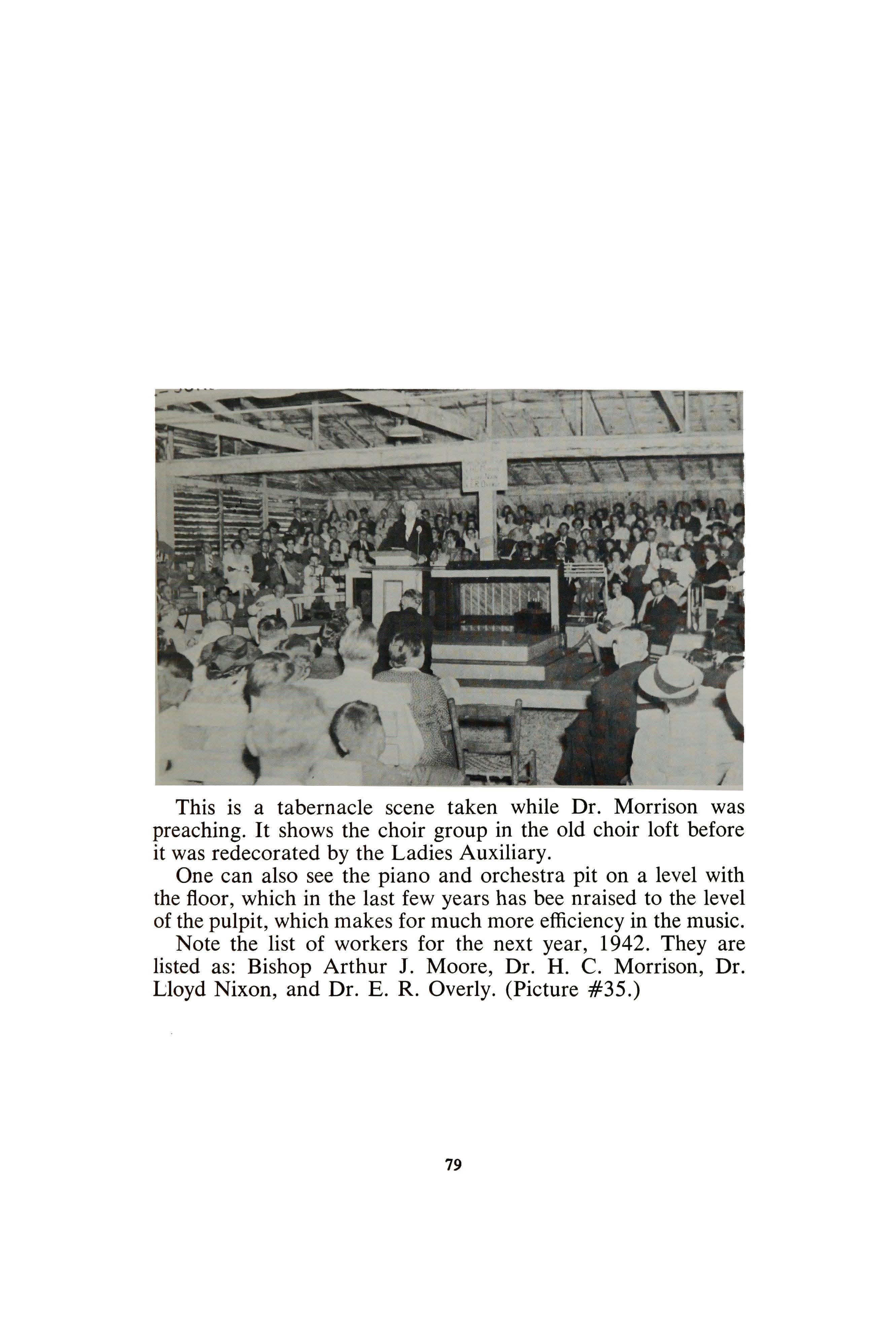
79
CHAPTER XIII FINANCES
Thanksgiving Day
Thanksgiving Day is unique to Indian Springs Camp. For many years the last Thursday of the camp meeting has been given over for praise and thanksgiving, primarily for the benefit of cottage owners and officials of the camp ground.

It is on this day that the entire budget is presented to the people and an appeal is made to subscribe to this budget for the year 'round operation of the camp.
Someone is in charge of the services. It is his duty to see that assistants are placed throughout the tabernacle with pledge cards, who not only hand out the cards but collect them and call out the amounts when they are turned in.
The usual procedure, however, is for the cottage owner to give personal testimony, with a statement as to the amount subscribed. The pledge card is filled out and handed to the usher. If the one making the pledge does not announce the amount, the usher does.
The secretary with his assistant keeps account of the pledges as they are called out, so that at the end of the service the total amount pledged can be announced.
This service usually runs from an hour and a half to two hours. It is a time of wonderful spiritual blessing, because of the triumphant testimonies and the radiant faces of those who are giving to the work of the Lord.
Sometimes rather unique characters attend these services and give hilariously. The writer recalls one man who attended the camp for many years, who had the habit of jumping and shouting he gave his testimony. The gist of his testimony was that God had blessed him so abundantly and so far beyond what he deserved that he wished to give as liberally as possible in appreciation for what God had done for him.
On one occasion he came up toward the front and began his testimony. Soon he was jumping. up and down and shouting at 80
Clarence S. Newton, Sr. was the faithful treasurer of the camp for many years. His services were greatly appreciated by all who knew him and his work. (Picture #36.)

81
the top of his voice, with a radiance on his face that was not of this world. He wound up by jumping on the altar and running from one end to the other, waving his handkerchief and praising God for the many benefits of the past year.
This was all done "in the Spirit," and proved to be a great blessing to the people. The only criticism heard about him was that some people feared that he gave too much in comparison with his means. He always paid his pledge, however, and was back the next year praising God for His wonderful blessings.
Sometimes the testimonies were rather long, but usually they are short. Some persons merely praised God for the privilege of being there and enjoying the wonderful blessings of the camp. Others tell of some particular blessing that has occurred during the previous year. Sometimes because of special previous blessings the pledge is larger than the year before.
THE BUDGET
Since the trustees always pray about the budget and, since they always carefully figure what is needed, the people are convinced that this is what the Lord wants. As result, it usually is subscribed almost a hundred percent.
This writer has not been able to check the figures as to the amount of payments on the subscriptions, but he can state that at one camp where he was president for five years, over a five year period an average of 98 percent of the subscriptions were paid. It is quite evident from the progress of Indian Springs Camp that the great majority of these subscriptions are paid, in spite of losses due to illness, death, and changing circumstances.
It is a policy of the Board to remind subscribers of their amounts and to suggest re~ittances during the year. No pressure is put upon them, however, to pay same, and if a party states that he or she is not able to make the payment, the pledge is not held against him. It is a matter left entirely to the conscience and honest conviction of the people.
This indicates that Indian Springs Camp is indeed a camp meeting of the people. The writer has known hundreds of them throughout more than a fifty-year period. They have come from 82

all ranks of life. Most of them have been "the average person." Some of them, however, have been wealthy people; some have been highly educated; some have been very poor.

Many preachers have attended this camp. At one camp meeting the number was more than three hundred. Some of them had bought cottages and stayed on the camp ground year after year, and thus had become material supporters of the camp, in addition to their spiritual presence.
Most of those interested in the camp do not look forward to Thursday as a day of pressure but, in reality, as a day for thanksgiving unto the Lord. They come to the tabernacle in great numbers, give their testimony with a victorious note, and pledge their support for the continuance of the camp for another year.
Needless to say, this type of procedure does away with continual "begging" and "auctioneering" for money in the regular services.
For many years, no collection outside of Thanksgiving Day was taken except during the three services on Sunday. During the past few years, however, the growth of the camp has been so extensive and so rapid, that collections have been taken nightly in addition. Sometimes the one in charge states the amount requested for the evening service, and informs the people of the amount needed to come up with the budget requirement. These offerings, however, are purely voluntary and usually are very successful.
83
CHAPTER XIV SOME HIGHLIGHTS
A review of the Minutes from year to year reveals some most interesting historical data, and the reporting of them shows something of the development of the facilities of the camp ground, as welJ as some other important items.
The Youth Movement
On August 15, 1955, the Minutes showed that Clarence Newton, Jr., reported that the young people had raised about a thousand dollars for a new youth tabernacle. The Board decided to buy ten acres on the west side of the camp ground for $900.00 on which to place the tabernacle, but did not have the money for this purpose. They requested Mr. A. L. Luce to purchase the same and to proceed with the erection of the tabernacle.
A year later, on August 13, 1956, it was reported to the board that the youth tabernacle had been erected by Mr. A. L. Luce for $6,591.93. A note was authorized for $5,000, made out to Mr. Luce to pay for the tabernacle. Later minutes showed that this note was paid in full with the aid of a generous gift by Mr. Luce.

The First Missionary Day
August 11, 1958, was a historic day in the history of Indian Springs Camp Meeting. It was on that day that the first Missionary Day was approved by the Board, with an offering to be disbursed by a standing committee. The first committee was Mr. A. L. Luce, Dr. B. C. Gamble, and Mr. J. 0. Fuller.
Up to that time the camp meeting authorities had felt that its one prime object was to preach scriptural holiness and not to promote any other particular organization or program.
Prior to the erection of the youth tabernacle, a children's tabernacle had been built, about 1920, and had been called Glenn's Children's Tabernacle. The Board, therefore, ordered that the Glenn Tabernacle be equipped and designated there-
84
after as the children's tabernacle, to be used primarily for the younger children who came to the camp each year.
The report of the Board in August, 1962, shows that the Pittman Memorial Annex was completed and fully occupied. This was built near the two old annexes but was constructed of concrete blocks, to be used as efficiency apartments and was named to honor Mr. Pittman who was a long-time honored member of the Board of Trustees.

The Board at that time also approved the plan to construct a new cafeteria by August, 1963.
Constitution Amended
At the board meeting in 1952, the trustees departed from an age-old custom of electing trustees only from the State of Georgia, and made it possible to elect out-of-state trustees. The object of this was to secure persons who came from surrounding states who might be interested in the camp, and help with its development and program. In August. 1963, President McKibben gave a summary of the situation of the camp ground. He reported that the valuation of property on the camp ground at that time was $326,700.00.
On August 14, 1963, the constitution was amended so that the trustees were to be elected for four years with no limit on the number of terms a member might serve.
At that time the Board was divided into four groups. The first four were to be re-elected in 1964, the second in 1965, the third in 1966, and the fourth in 1967.
The writer attended his first camp at Indian Springs in 1913. He well remembers the time when the Coleman lanterns were installed to replace the old-fashioned coal oil lamps, and noted the great interest and enthusiasm of the people over the wonderful improvement of the services at night.
A pamphlet produced by the Daughters of the American Revolution in 1906 gives a brief review of the history of the camp. It stated at that time the following:
"The 15th annual camp meeting commences Thursday even85
ing, August 9 (note the special date), with Joseph H. Smith, Bud Robinson, and Will Huff as preachers."
This pamphlet also states that the camp ground was begun in December, 1890, but that the first camp meeting was held in 1891, "between Flovilla and Indian Springs and bordering on the dummy railroad connecting the two points."
In this pamphlet the statement is made that "the original tract of ten acres, donated by friends in the two towns in adjoining county, was enlarged by the purchase of twenty-four acres."
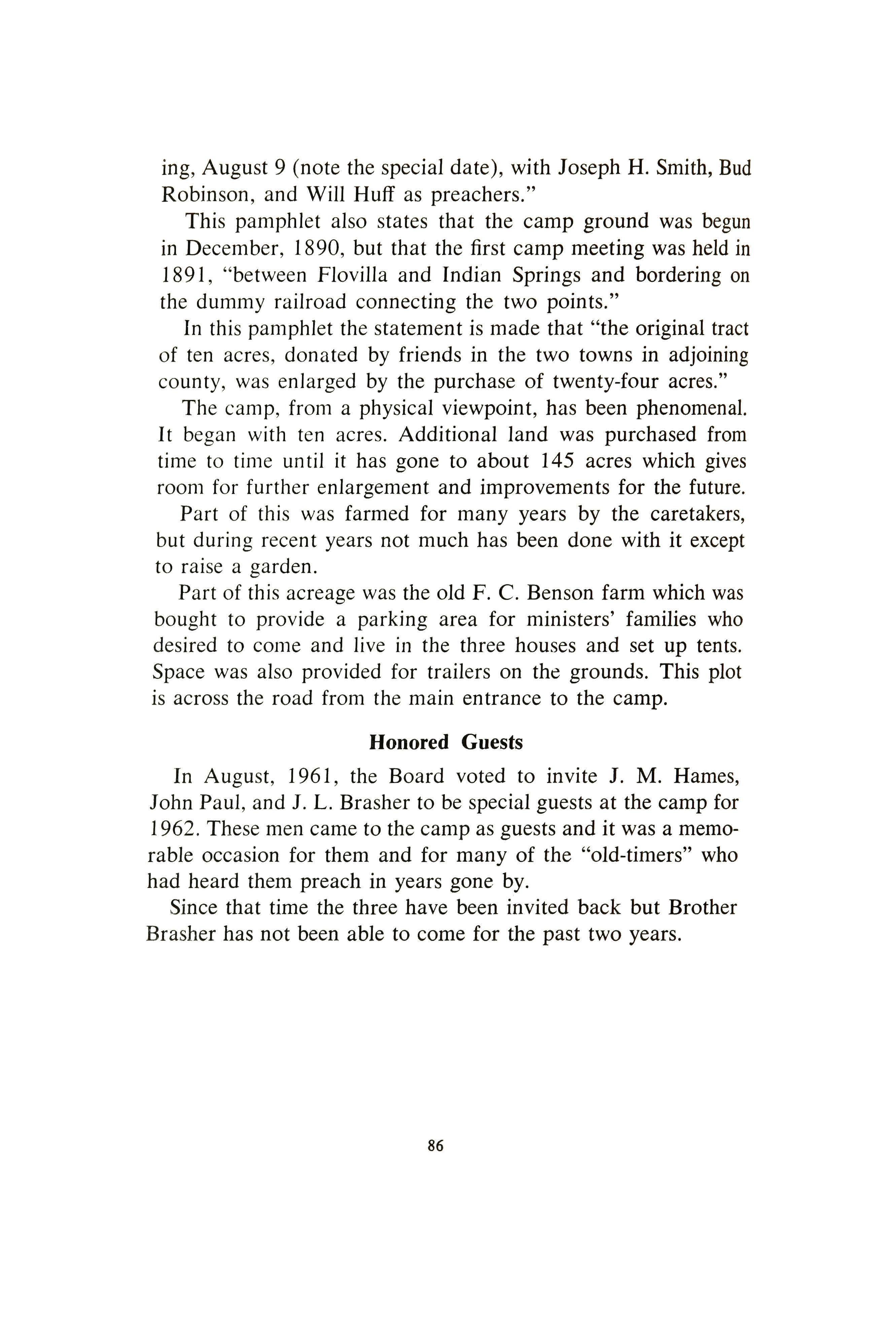
The camp, from a physical viewpoint, has been phenomenal. It began with ten acres. Additional land was purchased from time to time until it has gone to about 145 acres which gives room for further enlargement and improvements for the future.
Part of this was farmed for many years by the caretakers, but during recent years not much has been done with it except to raise a garden.
Part of this acreage was the old F. C. Benson farm which was bought to provide a parking area for ministers' families who desired to come and live in the three houses and set up tents. Space was also provided for trailers on the grounds. This plot is across the road from the main en trance to the camp.
Honored Guests
In August, 1961, the Board voted to invite J. M. Hames, John Paul, and J. L. Brasher to be special guests at the camp for 1962. These men came to the camp as guests and it was a memorable occasion for them and for many of the "old-timers" who had heard them preach in years gone by.
Since that time the three have been invited back but Brother Brasher has not been able to come for the past two years.
86
CHAPTER XV
THE EVANGELISTIC EMPHASIS
The Preachers
The board of trustees has sought to hold the high standards of holiness preaching throughout the years. In the beginning the only preachers called to the camp were those who were rather nationally known. Some of these were Dr. Beverly Carradine, L. L. Pickett, Seth C. Rees, H. C. Morrison, Bud Robinson, Will Huff, C. W. Ruth, C. H. Babcock, J. L. Brasher, C. W. Butler, John Paul, and Joseph H. Smith.
Among the "second generation" of holiness preachers who have served on more than one occasion for the camp, we find the names of John Owen, Joseph Owen, Paul S. Rees, John Church, Z. T. Johnson, Harry Blackburn, Percy Trueblood, Roy Nicholson, T. M. Anderson, H. M. Couchenour, and a good many others. Some have only served on one or two occasions but, due to their age, will probably appear at other times as workers at the camp.
The Singers
The same thing has held true for calling of song evangelists for the camp. The most outstanding of the early leaders, of course, was Charlie Tillman of Atlanta, Georgia. He was song leader and soloist for the camp for a long period of years. He became widely known as a song evangelist and was used extensively in the churches throughout all the South and many other parts of the country.
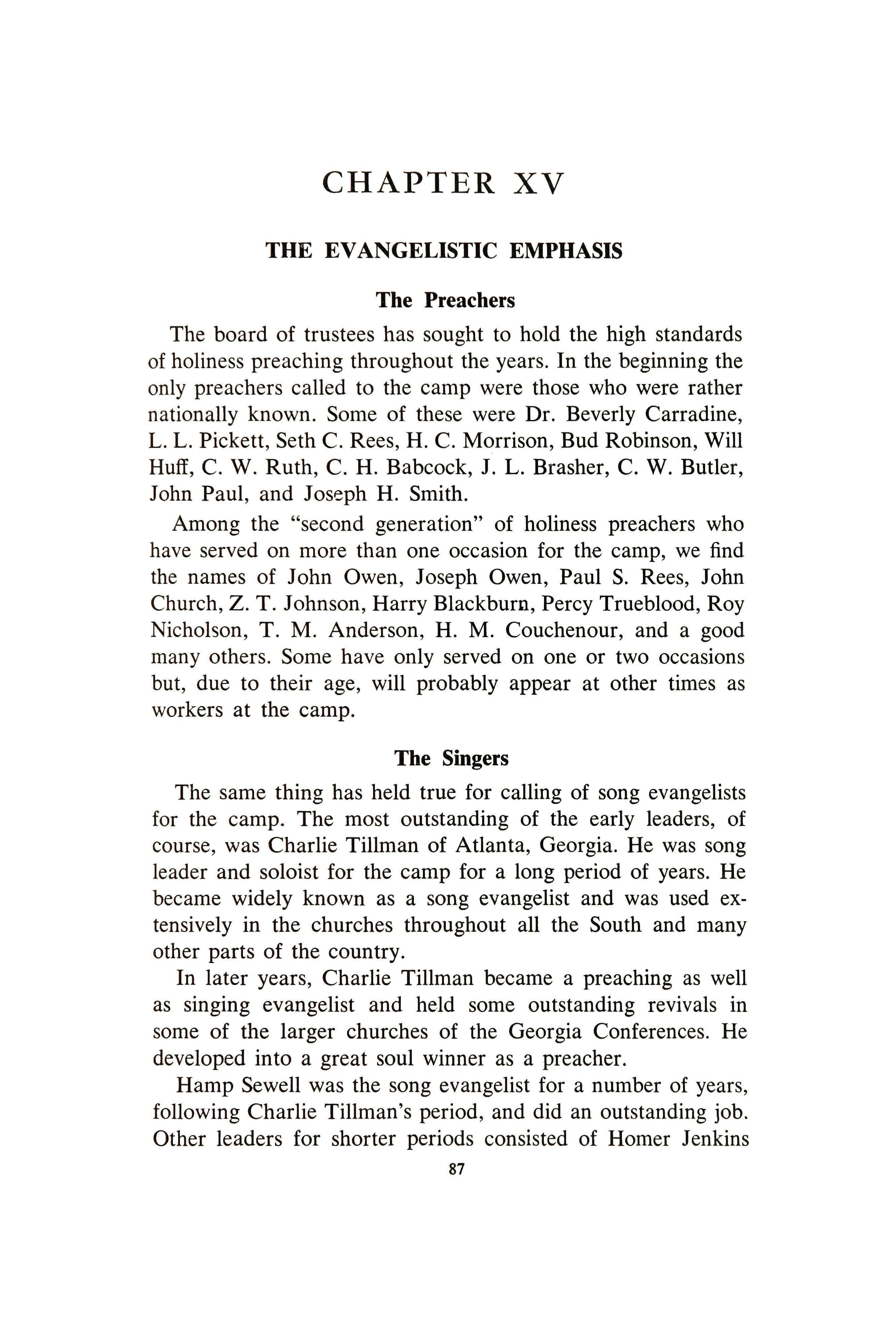
In later years, Charlie Tillman became a preaching as well as singing evangelist and held some outstanding revivals in some of the larger churches of the Georgia Conferences. He developed into a great soul winner as a preacher.
Hamp Sewell was the song evangelist for a number of years, following Charlie Tillman's period, and did an outstanding job. Other leaders for shorter periods consisted of Homer Jenkins
87
of Atlanta, and a few persons who have served for only one camp.
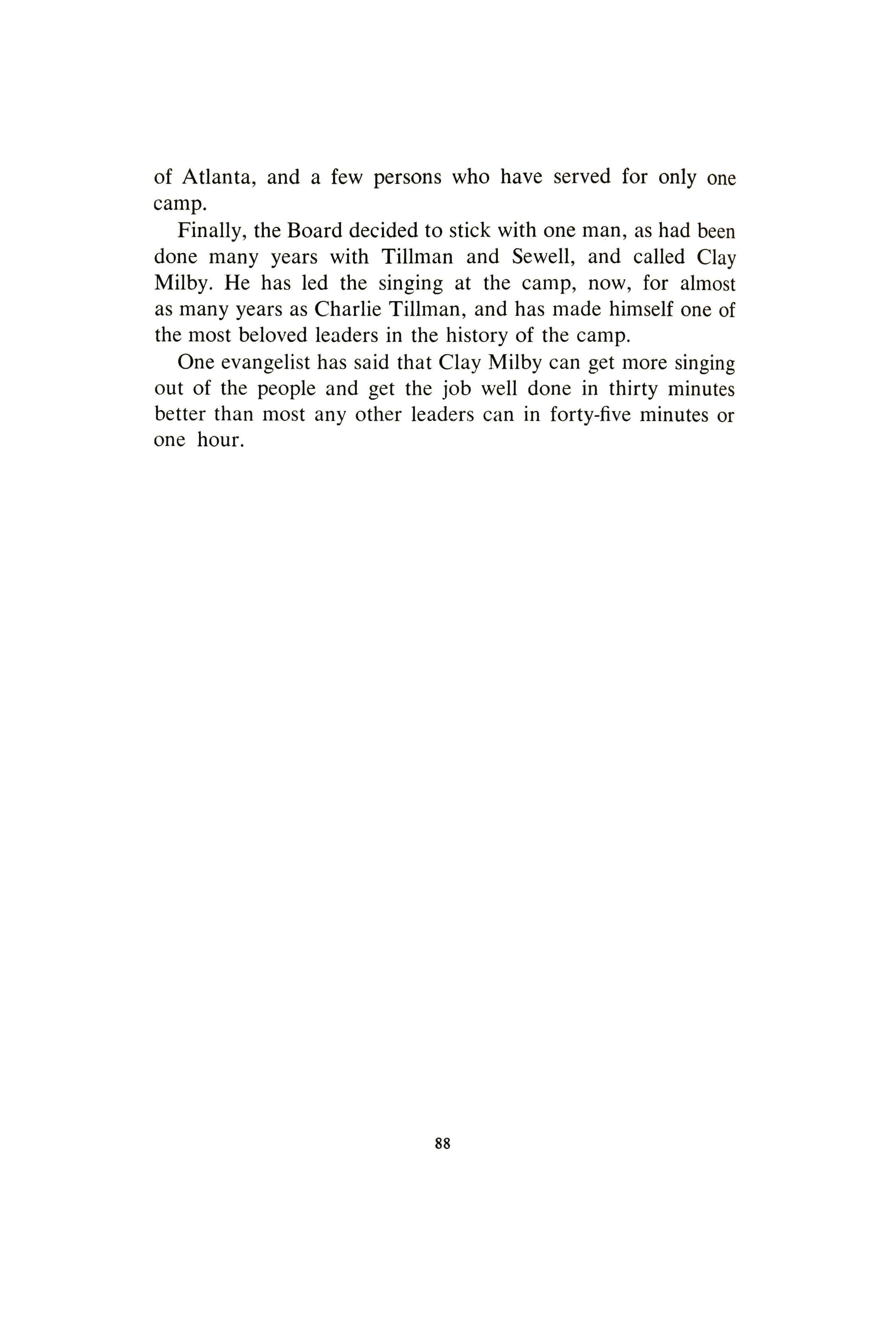
Finally, the Board decided to stick with one man, as had been done many years with Tillman and Sewell, and called Clay Milby. He has led the singing at the camp, now, for almost as many years as Charlie Tillman, and has made himself one of the most beloved leaders in the history of the camp.
One evangelist has said that Clay Milby can get more singing out of the people and get the job well done in thirty minutes better than most any other leaders can in forty-five minutes or one hour.
88
CHAPTER XVI
DOWN MEMORY'S LANE
Walk with me down memory's lane. I would like to recall for you some interesting and forceful events that have occurred through the years.
It is the day before camp meeting opens in August, 1913. This writer was attending the camp meeting for the first time and had entered the tabernacle to listen to the beautiful voice of a whitehaired singer who was on the platform practicing a solo. He called me to the platform and asked me if I could sing. In spite of the shy denial, he asked me to try a solo.

He picked out a song that I had learned, entitled, "Were You There When They Crucified My Lord?" The pianist played and I started to sing. He listened carefully to the falsetto voice and then sang a verse, showing me how it should be done. After several crude attempts to sing it as he wanted it done, he kindly shook his head and with a pat on the head told me that he would wait until my voice matured a little before asking me to sing a solo in the tabernacle.
Frankly, I never knew whether he actually meant for me to sing in a service or not. I do know that his kindness took the sting out of inability to do what he wanted. After that day until his death, Charlie Tillman was one of my outstanding spiritual heroes.
The "Thank You Lady"
We are walking down the lane just after supper, while the cottage prayer meetings are being held. On the front porch of one of the largest houses, near the old oak tree where the founders prayed, a group of people were praying. The voice of one stood out in a most peculiar way.
This lady was leading in prayer; but she did not ask for a single thing. She thanked the Lord for the camp ground; she thanked Him for the great meetings that had been held there in previous years; she thanked Him for the officials and for the
89

90
Picture No. 1 shows the author in 1913 when he first went to Indian Springs Camp Ground. Picture No. 2 shows him preaching in the pulpit of Hughes Auditorium, Asbury College over forty years later. (Picture #37.)
preachers; she thanked Him for the many blessings of the previous year.
She praised God for the privilege of prayer; she praised Him for the faith that enabled her to believe that He was answering prayer at the present time and would continue to answer it during this camp meeting.

She praised God for the group of friends who had come to her cottage. She praised Him for the blessings these friends had or they might obtain during this camp meeting.
Her prayer lasted from five to ten minutes. Not once did she fail to thank or to praise God for something and not once did she ask God to do something or to give something to them. It was one of the strangest, most beautiful prayers the writer ever heard. The one praying was the sainted Mrs. Rodgers of Sandersville, Georgia, who was such an outstanding blessing on the camp ground for many years.
The Junk Dealer
It is thanksgiving day at Indian Springs. People are rising and testifying to the blessings of God throughout the year and making pledges for the coming year. One man took up more time and created more spiritual excitement than all the rest put together on this particular day. He was a small man, between sixty and seventy years of age. Very few people actually knew how old he was.
His testimony began by telling the people that he ran a junk yard. He then recited the blessings God had given him throughout the year, and how wonderful it was to have God as a partner in the junk business.
Finally he ran to the front, jumped on the altars and ran back and forth, clapping his hands, praising God in such a way that a ripple of spiritual joy ran throughout the whole congregation. He concluded his testimony by stating that God had prospered him the past year more than ever before, and because of this he wanted to give double what he had ever given previously.
After giving a pledge which was one of the largest of anybody in the camp that year, he jumped off the benches, kept
91
walking back and forth in front, clapping his hands and praising God for His marvelous goodness and the blessings that were his.
I do not recall ever knowing what his name was or what happened to him. I do not know that on this particular day he was a great blessing to everybody present.
John Paul, The Organist
It is a morning service. There is a spirit of devout worship over the people. The preacher has chosen this hour to feed God's sheep. This tall, black-headed preacher had a peculiar habit of gesticulating with his left heel. He would stand solid on his right foot, lift his left, with his toe on the platform like a ballet dancer. and emphasize point after point by turning his heel one way or another. It was peculiar but always in order.
His voice was clear and his sentences lucid. He was preaching on the 23rd Psalm. The richness of his message grew with each succeeding point until he suggested that he could sing it better than he could tell it.
He sat down at the old pump organ, played the tune, then sang it clearly so that it could be heard throughout the tabernacle.
He went back to the platform, took up where he had left off, and reached such a climax of spiritual imagery that shouts began to rise from all parts of the tabernacle, and shortly the people were parading up and down the aisles waving handkerchiefs, weeping for joy and praising God for His marvelous glory and goodness to them.
The preacher simply watched and smiled sweetly while this was going on and then dismissed the people with a short prayer.
The writer has heard John Paul preach on many occasions but has never heard him better and has never seen such magnetic results under his preaching as occurred on that particular day.
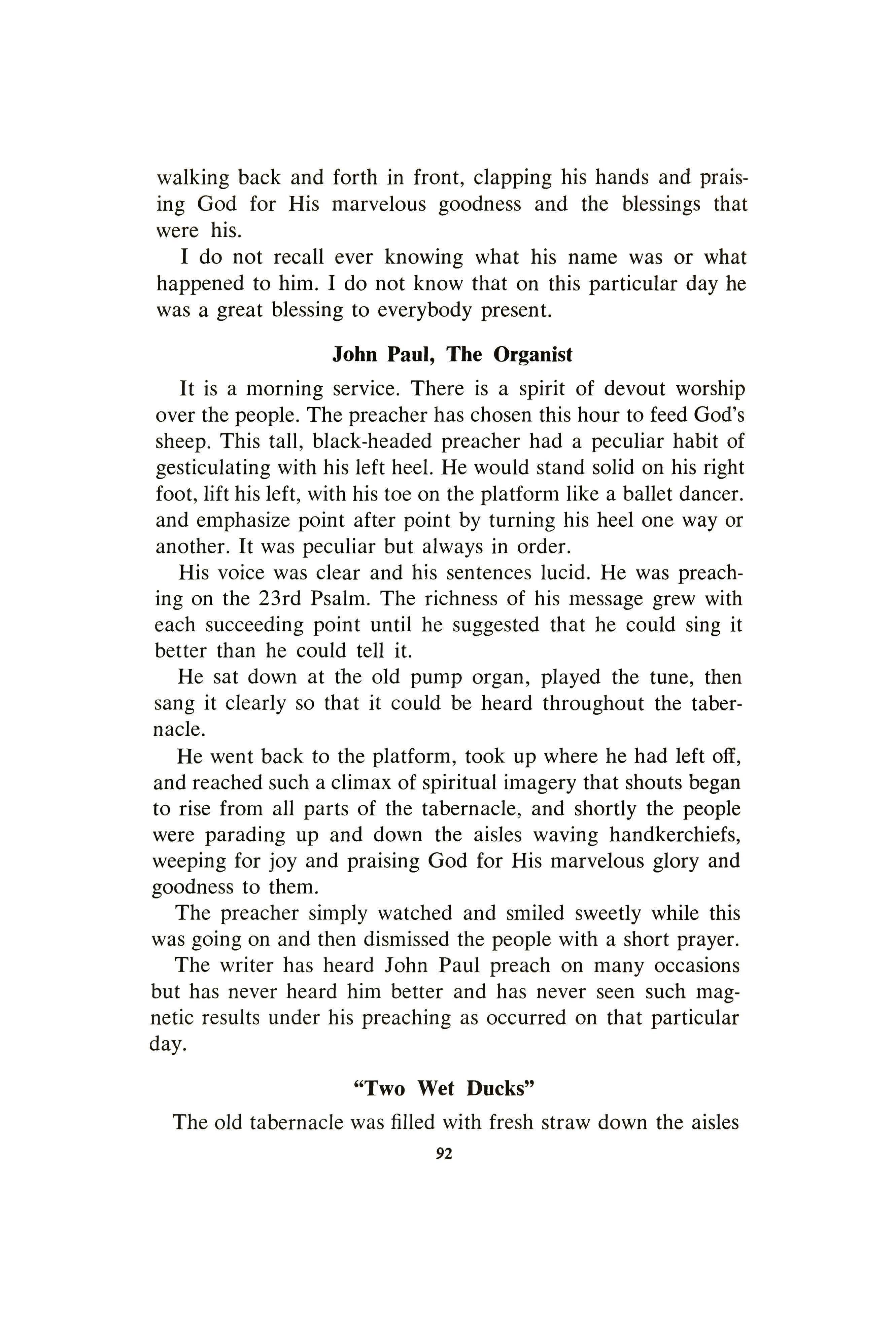
"Two Wet Ducks"
The old tabernacle was filled with fresh straw down the aisles
92
.and around the altar. It seemed that thousands of people were on the grounds, milling about, until it began to rain. Since the time of service was close at hand, they began to crowd into the tabernacle. The service proceeded in good order. After the special song, the preacher rose and took his text. Just as he was about to start preaching, a couple of women came under the edge of the tabernacle with large, floppy, drooping hats. They had gotten them wet in the rain but_it had protected their clothes except around the bottom edges of their long skirts.
They walked slowly down the long aisle, chewing gum vigorously and looking first at one place and then at another for a vacant seat.
The preacher watched, expecting them to sit down momentarily so he could continue his sermon without interruption; but already the interest of the crowd in the ladies had distracted them from his sermon. He finally pointed at them and said, "If those two wet ducks will take a seat, I will continue with the sermon." About that time they found a seat and flopped down but never seemed to miss a motion chewing gum.
Of course there was a titter that ran throughout the audience, but Dr. Morrison felt that nothing should disturb the preacher of the Gospel, and in his younger days he was very vigorously opposed to anybody distracting him while he was trying to dispense it.

Stars in the Daytime
In the yard in front of the house next to the cottage owned by Dr. J. M. Glenn who later became president of the camp ground was a dry well. It had been dug in hopes of finding water but none had been found, so it was covered over and left.
The writer happened to be there that particular summer to move a small house he had bought from that spot to one close to the exit gate of the camp ground. He noticed the dry well and remembered something that he had been taught in college.
The Math professor at Asbury College had told his class one day that the stars shine just as bright in the daytime as they do at night. His explanation was that the reason we cannot see them 93
is that the light about us makes it impossible for our eyes to behold the brilliance of the stars. He said that if one could go deep enough in the earth to shut out the glare of the sunlight he would see the stars shining in the daytime.
Here was an opportunity to test that statement. I secured a ladder and some Boy Scouts who were there with me helped me to climb down to the bottom of the well. It was between twenty and thirty feet deep. It was about 10:30 in the morning and was a bright, sunny day.
When I reached the bottom of the well and looked up, sure enough there were three bright stars visible, as clearly as could be seen on any clear, dark night.
Thus it was that on Indian Springs Camp Ground the author learned a lesson, namely, that when you can close your eyes to outward circumstances and look up with implicit faith, you will find that God's stars of hope shine brilliantly at all times.
The Holy Spirit Works
Joseph H. Smith was the speaker at Indian Springs Camp Meeting for many years at different times. During the latter part of his ministry his favorite work was that of teaching the "School of the Prophets." This consisted primarily of ministers and Christian workers who were interested in Bible study particularly about the Holy Spirit and His work.
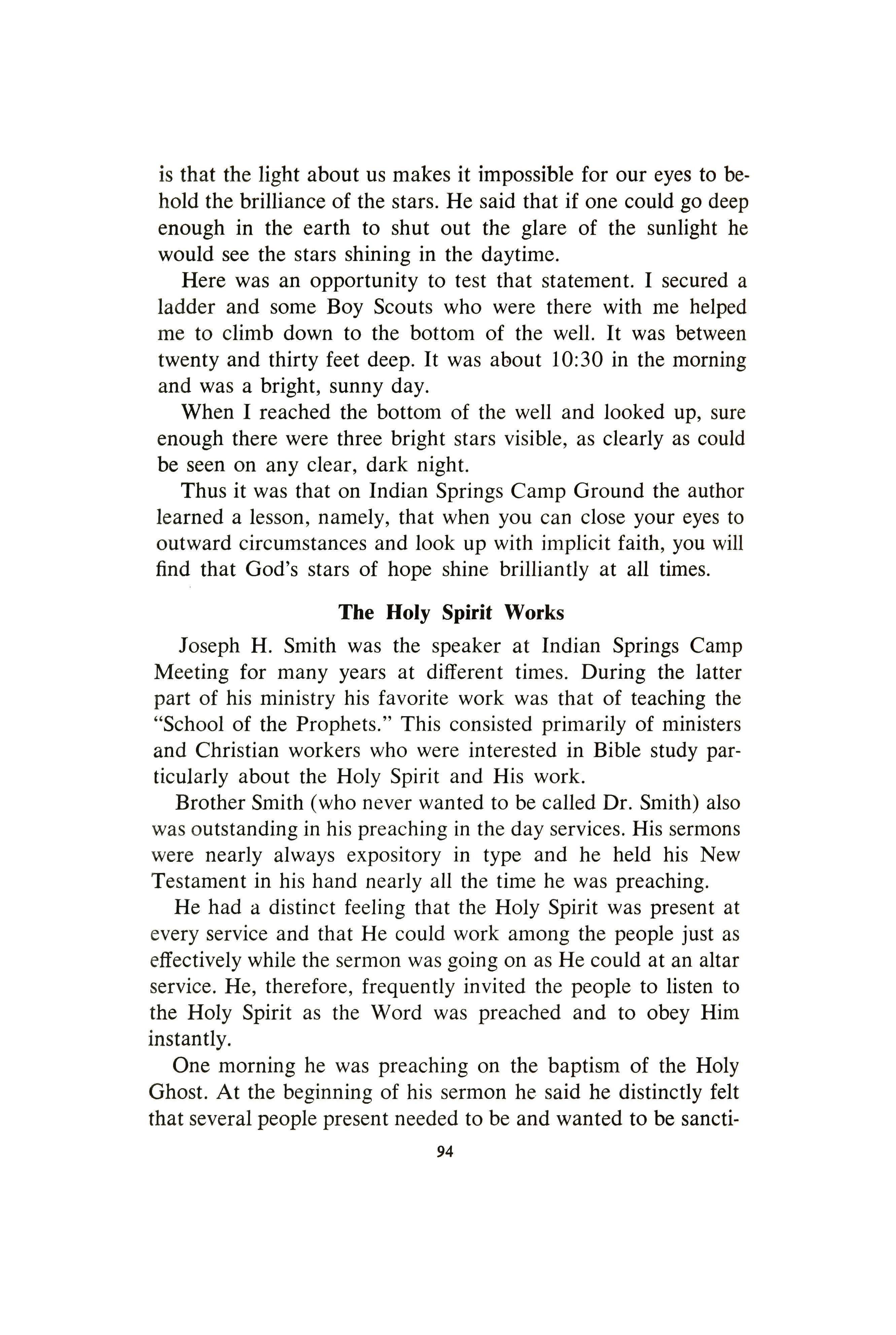
Brother Smith (who never wanted to be called Dr. Smith) also was outstanding in his preaching in the day services. His sermons were nearly always expository in type and he held his New Testament in his hand nearly all the time he was preaching.
He had a distinct feeling that the Holy Spirit was present at every service and that He could work among the people just as effectively while the sermon was going on as He could at an altar service. He, therefore, frequently invited the people to listen to the Holy Spirit as the Word was preached and to obey Him instantly.
One morning he was preaching on the baptism of the Holy Ghost. At the beginning of his sermon he said he distinctly felt that several people present needed to be and wanted to be sancti-
94
fled that day. He told them that if they would listen to and obey the Spirit, He would come into their hearts in the seats where they were sitting instantly when they yielded to Him.
He began to preach. After finishing his introduction and continuing his sermon for about fifteen minutes, he lifted his hand and said to the audience, ''Hark, I sense the workings of the Holy Spirit in some hearts just now. If you yield to Him instantly, He will come in and do His office work in your heart. Those who so yield at this moment, lift your hands." Almost instantly three or four hands were lifted in various parts of the auditorium. He rejoiced with the people and exhorted them a few minutes; then continued his sermon.
A few minutes he lifted his hand again and repeated almost the same thing as he had said before. He looked around the audience and asked those who now yielded to the Holy Spirit to lift their hands. Two or three others did so. Again he rejoiced and exhorted briefly before continuing his sermon.
Toward the close of his sermon he stated that since the Holy Spirit was working so definitely he did not think it would be necessary to have an altar call; but suddenly he cried out, "Hark, I sense the presence of the Holy Spirit about to do His office work in some others. If it is you, lift your hand." Five or six people lifted their hands and again there was a time of rejoicing of the part of the minister, this time joined by many people with "amens" and praises to God.

He asked the audience to stand and dismissed them without any singing or any further invitation to come to the altar. As the people filed out there was a holy hush over the whole place and those present indeed felt that the Holy Spirit had been there to do His office work and had worked just as effectively as He had done in any other service during that particular meeting.
Brother Smith left the tabernacle beaming with joy, with a glorious smile on his face. His work had been accomplished; his faith had been honored; and, although he never demonstrated in an emotional way, one could tell that he felt that he had been the agent of the Holy Spirit and the True Ambassador from Heaven on that day.
95
Texas Wisdom
"Uncle Buddy" Robinson, nearly always called that by those who knew Bud Robinson well, was a Texas dirt farmer unable to read and write when he was converted, but married to a godly woman. It was a glorious experience to him which led to his call to preach and to his effectiveness as a minister in spite of a stammering speech.
Bud Robinson was one of the early workers at the beginning of Indian Springs Camp and was there a number of times. He became a great camp meeting preacher and preached in nearly all of the holiness camps of America before he died. This he did in spite of a stammering tongue.
He was known for his wit and wisdom. He was also known for having memorized practically the entire New Testament from which he could quote giving chapter and verse without hesitation.
One of his great sermons was "The Great Salvation." In this sermon he emphasized the greatness of God and the greatness of the work which God does in the human heart.
One of his outstanding statements in this sermon was "Everything God does is great." He insisted that this was true whether we understood it or not.
One day after he had preached this sermon at Indian Springs Camp, a man jokingly said to him, "Uncle Buddy, you said this morning that everything God does is great. I would like for you to explain one thing to me. What is great about a chigger?"
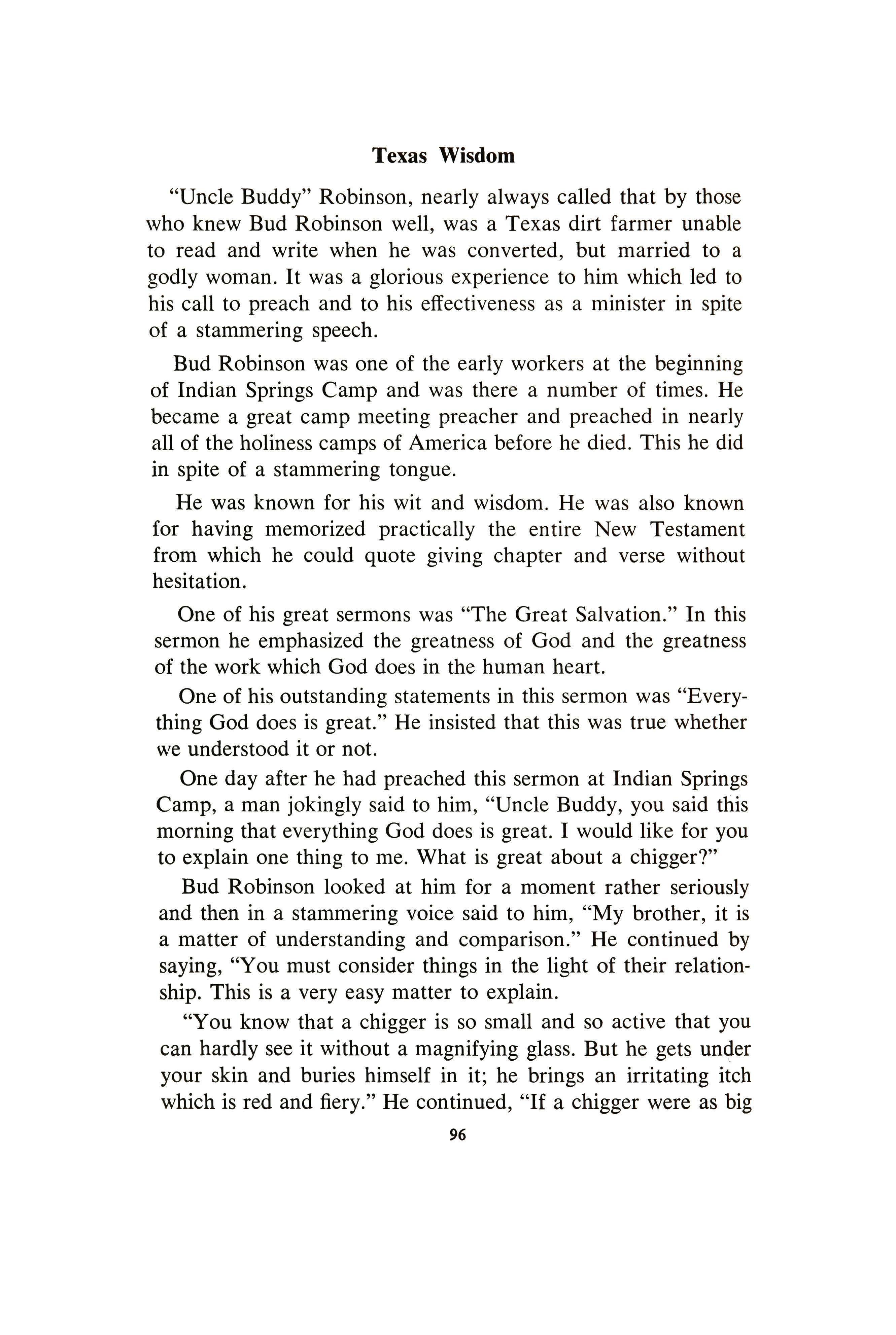
Bud Robinson looked at him for a moment rather seriously and then in a stammering voice said to him, "My brother, it is a matter of understanding and comparison." He continued by saying, "You must consider things in the light of their relationship. This is a very easy matter to explain.
"You know that a chigger is so small and so active that you can hardly see it without a magnifying glass. But he gets under your skin and buries himself in it; he brings an irritating itch which is red and fiery." He continued, "If a chigger were as big
96
as a bulldog and should bite you, it would raise a knot on you as big as Pikes Peak."
Then Uncle Buddy asked, "Now do you understand?" And the man replied "Uncle Buddy, I agree with you; everything that God does is great."
The Lady In The Wheel Chair
Miss Rebecca Finleyson was a little lady who came to Indian Springs Camp Meeting for many years in a wheel chair. She would be put on the train in her home town, transferred to the dummy in Flovilla, and then taken from the dummy baggage car when it stopped at the front gate of the camp ground.
Notice was always given that she was coming. Porters would take care of her until she got to the camp ground and then the officials would have arrangements made for her to be taken to the first floor where she stayed.
Someone would always roll her to the tabernacle and down the aisle near the front where she would sit and enjoy the services. She could not get up out of her chair; but sat there with a glow on her face that made everybody want to speak to her.
She had many friends to whom she would give her testimony. Whenever she had a chance in the testimony meeting she would likewise praise God for His wonderful goodness to her.
Some of the boys counted it a great privilege to roll her back and forth to services and to the dummy baggage car when she got ready to leave. She usually left on Friday or Saturday before the camp meeting closed.
Her testimony was so bright and her face so inspirational that she was a source of blessing and encouragement to all who talked with her.
Some years after her death the author happened to stop over in her town between trains and recalled the fact that she was from that town. He decided to find out if anybody in town knew her and what they thought about her. He first asked the depot agent if he knew her, and the reply was "I surely do. There never was a more godly person in this town than she."
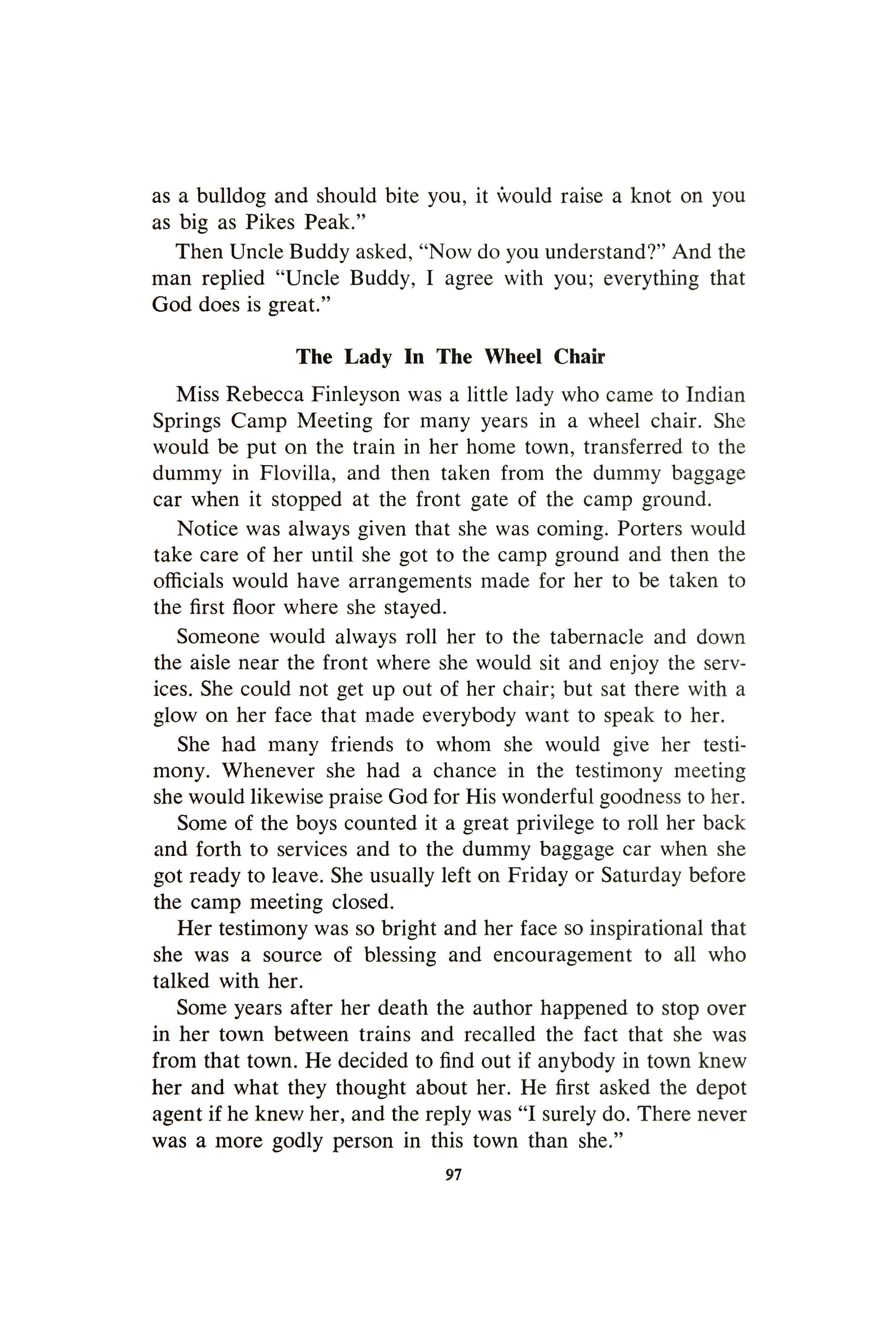
97
Walking down the street, a negro man was asked if he knew this lady. He stood up with a smile on his face and he said, "Yes, sir, I knew her for a long time. She was a great blessing to everybody in this town and was a saint on this earth."
Two or three others were met on the street and all gave about the same response, with the general testimony that "she was a saint in a wheel chair." One man said that she did more good among the poor people of that town than all of the rest of the town put together.
It was a remarkable thing to realize that a life so restricted in activity could be so abundant in influence and spiritual power. It simply shows what the blessing of the Holy Spirit in a human heart and dominating a fully committed life can do.

98
LIST OF COTTAGE HOLDERS IN 1915

COTT AGERS-Parties attending the Camp Meeting will find it a very great advantage in the handling of their baggage and the finding of their friends, if they will familiarize themselves with the cottages by number as found in the list below:
No. 26. Keeper's Cottage.
1. Mrs. E. S. Quinker, Atlanta, 27. Camp Grond Hotel. Ga. 28. Mrs. W. H. Mallet, Jackson,
2. Frank C. Benson, Flovilla, Ga. Ga.
3. D. D. Durham, Poplarville, 29. Mrs. G. W. Kinsman, Jackson, Miss. Ga.
4. John M. Williams, Dublin, Ga. 30. Carmichael & Jones, Jackson,
5. Mrs. Wm. S. Garbutt, Valdosta, Ga.
6. Rev. G. W. Mathews, Fitzger-
Mrs. J. B. Martin, Atlanta, Ga.
Mrs. Maggie Jackson, Brewton, aid, Ga. Ga.
8. Betts & Evans, Ashburn, Ga.
Mrs. Annie B. Holt, 9.
Ga. 31.
32.
33.
Ga. 34. Rev. J.
Mrs. J.
35. Mrs.
Jackson, Ga. Ga. 36. J. L. Lyons, Jackson, Ga.
Mrs. J. B. Hutchinson, Adrian, 37. Miss Blanche Ward, Monticello, Ga. Ga. 12. Mrs. J. T. Fletcher, Jackson, 38. Rev. M. D. Smith, Atlanta, Ga. Ga. 39. W.W. Milan, Stockbridge, Ga. 13. P. E. Coleman, Atlanta, Ga. 40. Mrs. A. E. Prell, Atlanta, Ga. 14. Mrs. Laura Walker, Macon, 41. Rev.
Douglas, Ga.
Mrs. Hunter, Atlanta, Ga. 42. Luke Odum, Macon, Ga.
W S Davis, Hampton, Ga. 43. Miss Maggie Stillwell, Atlanta, 17. Thomas W. Hicks, Porterdale, Ga. Ga. 44. Parsonage. 18. Charlie D. Tillman, Atlanta, 45. J. W. Beeson, Meridian, Miss. Ga. 46. R. F. Burden, Macon, Ga. 19. Mrs. E. D. Hoard, Indian 47. Workers' Cottage. Spring, Ga. 48. Rev. Mashburn. 20. Mrs. H. C. Tindall, Macon, Ga. 49. Mrs. Hein. 21. The Dodge Memorial. 50. Mrs. Minnie T. Grimble, 22. Mrs. V. J. Ward. Macon, Ga. 23. Rev. J. H. Mather, Macon, Ga. 51. S. C. Arnold, Macon, Ga. 24. Brantley Johnson, Macon, Ga. 52. The Annex. 25. Mrs. Mattie A. Johnson, 53. D. D. Peacock, Pavo, Ga. Atlanta, Ga. 99
T. J. Shingler, Donalsonville, Montezuma, Ga.
F. Jones, Hapeville, Ga. 10.
W. Outhouse, Jackson,
C. A. Butler,
11.
W. A. Huckabee, Ga.
15.
16.
LIST OF COTTAGE HOLDERS OF INDIAN SPRINGS HOLINESS CAMP GROUND

(Revised, October 20, 1964)
1. Adams
Ft. Valley, Ga.
2. Don E. Andrews
2584 Rockcliff Rd., S.E., Atlanta, Ga.
3. (11) Mrs. J. J. Ansley
1555 Fairburn Rd., Atlanta, Ga.
4. Mrs. Helen Aultman
Ft. Valley, Ga.
5. ( 109) Rev. David Aycock
Wadley, Ga.
6. (58) Mrs. H. M. Bailey
Louisville, Ga.
7. ( 5) George Baker
Tifton, Ga.
8. 0. B. Bankston
Homerville, Ga.
9. (88) Mrs. R. L. Betts
Flovilla, Ga.
10. (64) J.M. Branan
Box 39
Stockbridge, Ga.
11. ( 5 7) Mrs. Blanche Brunson
Reynolds, Ga.
12. (94) Ralph Bunn
"Papa Dan Memorial"
989 Deckner, S.W., Atlanta, Ga.
13. (98) Mrs. J. W. Caines
Flovilla, Ga.
14. (121) W. H. Caldwell
110 Ruby Lane
Forest Park, Ga.
15. (83) M.A. Carnes
Jonesboro, Ga.
16. (73) Sam C. Christian
Tifton, Ga.
17. (74) Sam C. Christian
Tifton, Ga.
18. (75) Adrian B. Colbath
3149 Stewart Ave., Hapeville, Ga. 100
19. ( 45) Mrs. E. J. Cook
2327 Country Club Dr.
s.w., Atlanta, Ga.
20. ( 109) Coppedge Cottage
c/o Dr. W.W. Coppedge
2825 Kimmeridge Dr., East Point, Ga.
21. (56) Mrs. W. C. Dailey
Jackson, Ga.
22. (77) Hoyed Davis
1009 Summit Dr.,
Albany, Ga.
23. (66) Rev. C. 0. Dorn
Easley, S. C.
24. (127) Mrs. Robert Dorsey
Nashville, Ga.
25. ( 3 7) Doster Cottage
c/o Mrs. G. E. Burns
1203 Monte Sano
Augusta, Ga.
26. (69) Mrs. J. S. Drennon
Jesup, Ga.
27. (54) Mrs. Raymond Edwards
Flovilla, Ga.
28. (34) W.R. Edwards
Ft. Valley, Ga.
29. (12) Mrs. Rosa Ferguson
Carrollton, Ga.
30. (67) Mrs. J. F. Finch
125 6th St., Moultrie, Ga.
31. (82) Miss Marguerite
Fletcher
Jackson, Ga.
32. ( 45) Mrs. V. P. Folds
Wilmore, Ky.
33. (113) Rev. J. 0. Fuller
Nashville, Ga.
34. Rev. J. 0. Fuller
( new one for sale)
Nashville, Ga.
35. (62) Mrs. D. C. Fuller
Ocilla, Ga.
36. (31) Furlow Cottage
c/o Mrs. Lucius Williams Oglethorpe, Ga.
37. (50) Dr. B. C. Gamble
2358 Beecher Circle, s.w., Atlanta, Ga.
38. (21) Mrs. John Haddock
1202 Mimosa Dr., Macon, Ga.
39. ( 111) Frank Harris
Cartersville, Ga.
40. (28) Rev. Sam Haynes
Clarkston, Ga.
41. ( 49) Stanley Heirs
10931 N. E. 6th St., Miami, Fla.
42. (81) Mrs. W. M. Hudson
600 Morningside Dr., Miami Springs, Fla.
43. ( 44) Mrs. George Huey
Alma, Ga.
44. (80) Mrs. C. W. Hughes
Rt. 1, Box 466, Avon Park, Fla. (2110 7th Avenue, West, Bradenton, Fla.)
45. (105) Dr. Kenneth Hutcherson
Francis Bldg., Louisville, Ky.
46. (18) Miss Azalea Jackson
Flovilla, Ga.
47. (42) Miss Bernice Jones
3641 Fulton Ave., Hapeville, Ga.
48. (19) Mrs. R. L. Jones
c/o Louie Jones
Ft. Valley, Ga.
49. ( 13) Mrs. Ruth Knippers
Lakeland, Fla.
50. (114) J. W. Lancaster
Ft. Valley, Ga.
51. (92) Rev. Ray C. Lane
Box 8
Thomaston, Ala.
52. ( 108) Robert L. Lane
1203 N. Carter Rd., Decatur, Ga.
53. (85) J. H. Lee & Rev. Mel Simonds
Social Circle, Ga.
54. ( 130) J. W. Lee
1203 Monte Sano Ave., Augusta, Ga.
55. (36) R. F. Lee
Social Circle, Ga.
56. ( 46) Mrs. C. E. Lindsay
2557 Wilson Woods
Dr.,
Decatur, Ga.
57. (122) Rev. John Lindsey
Stone Mountain, Ga.
5 8. ( 8) Robert Locke
501 North Dr.,
Birmingham, Ala.
59. Leonard Lowe
1875 Heather Dr.,
East Point, Ga.
60. ( 65) Mrs. A. L. Luce, Sr.,
Ft. Valley, Ga.
61. (107) Mrs. A. L. Luce, Jr.,
Ft. Valley, Ga.
62. ( 99) George Luce
Ft. Valley, Ga.
63. ( 112) Joseph P. Luce
Ft. Valley, Ga.
64. (95) Mrs. Charles Martin
1906 Queens Rd.,
Albany, Ga.
65. (14) Rev. H. H. McAfee
Lakeland, Fla.
66. ( 41) Annie Lou McCord
Jackson, Ga.
67. (86) McIntosh Cottage
c/o Pete McIntosh
Rt. 3
Covington, Ga.
68. (78) T. W. Mobley
Girard, Ga.
69. (33) Charles B. Moore
2393 Clayton St., Macon, Ga.
70. (2) Mrs. C. S. Newton, Sr.,
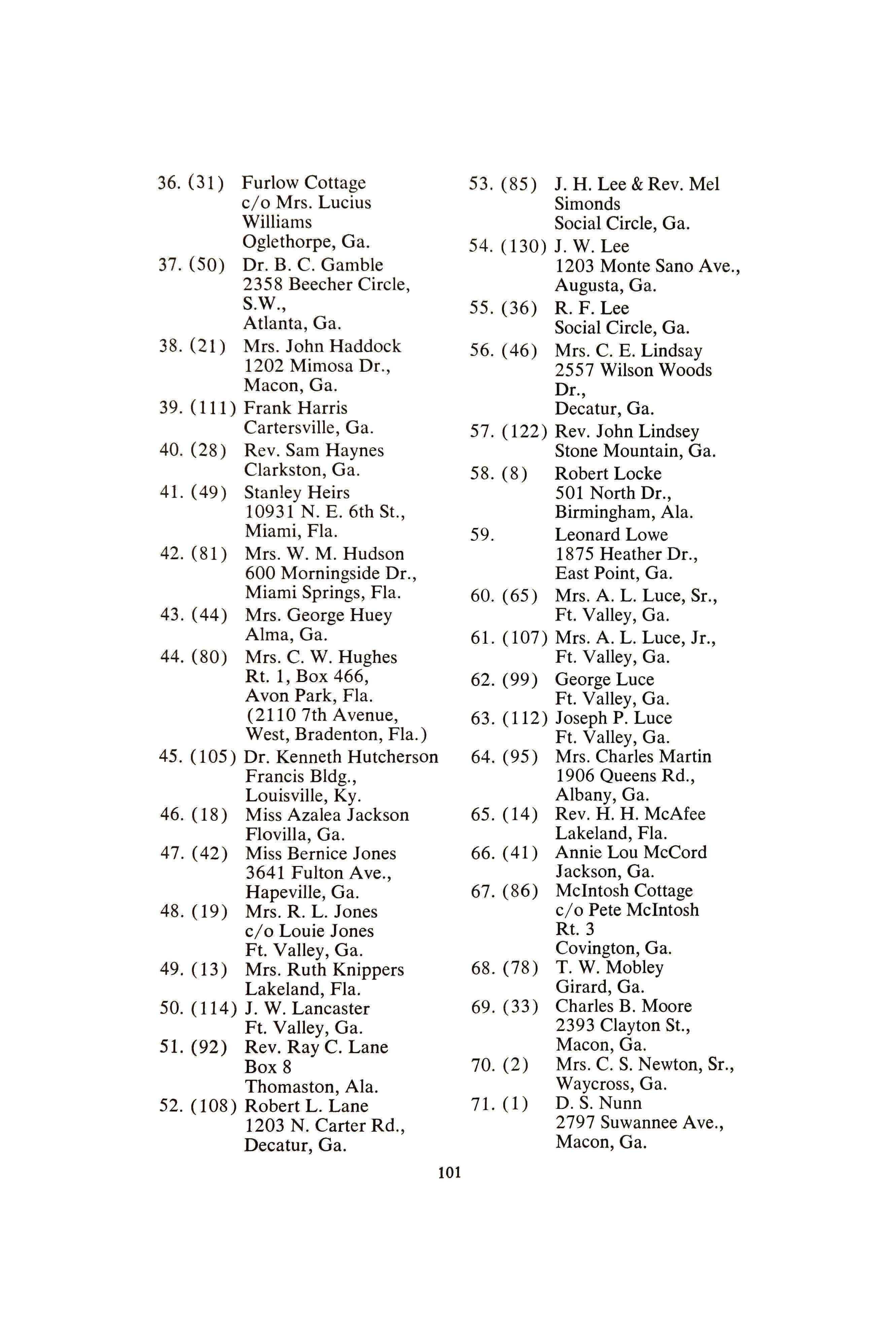
Waycross, Ga.
71. (1) D.S. Nunn
2797 Suwannee Ave., Macon, Ga.
101
72. ( 117) Rev. Dwight
Nysewander 1036 Willis Mill Rd., Atlanta, Ga.
73. (71) Odom Cottage
c/o T. V. Odom
Bradenton, Fla.
74. Rev. Paul John Pappas
75. ( 4) S. Walton Peabody
657 Clairmont Ave., Decatur, Ga.
76. (115) Rev. W. L. Peed
2730 Pearce Ave., Albany, Ga.
77. (82) Rev. Edward Peek 1353 Grove Ave., Waycross, Ga.
78. Q. J. Peele 2248 Boulevard Dr., Atlanta, Ga.
79. (29) Mrs. John Pennington
Benson-Pennington Cottage
Macon, Ga.
80. Rev. Pritchett
Thomaston, Ga.
81. ( 128) R. C. Redwine
773 Dimmocon Park
Dr., Spartanburg, S. C.
82. ( 60) Mrs. Clyde Reynolds
Thomaston, Ga.
83. Mrs. Charles Roper
1230 Fairview Dr., N.E., Atlanta, Ga.
84. (70) Rev. Harvey Roughton
Sandersville, Ga.
85. J. M. Rustin
Hagan, Ga.
86. (116) R. I. Sever
900 South, U. S. Hwy. 19
Clearwater, Fla.
87. (89) Alvah Shaw
Thomaston, Ga.
88. (27) Mrs. Jack Shepard
2614 18th Ave., Columbus, Ga.
89. ( 110) Roy L. Sims
771 7 Baxter St., Orlando, Fla.
90. (9) Rev. Orman Sloat
122 E. Park Ave., Valdosta, Ga.
91. (23) Rev. W. Glen Smith
Box 526
Greenwood, S. C.
92. (124) Rev. Rabun Smith
1817 McJenkins Ave.
N.E., Atlanta, Ga.
93. ( 63) Dr. David Stewart
Louisville, Ky.
94. (72) Mrs. J. M. Stone
Butler, Ga.
95. J. L. Taylor
Route 2
Covington, Ga.
96. (59) Rev. T. W. Taylor
370 N. 14th St., •
Griffin, Ga.
97. (16) Dr. M. T. Thome
715 E. College Ave., Decatur, Ga.
98. Tomlinson
Ft. Valley, Ga.
99. (3) Dr. W. H. Vanbrackle

7660 Whittington Dr., Richmond, Va.
100. (118) Rev. Roland Walker
Thomaston, Ga.
101. (20) Ben I. Waller
131 Buford Place
Macon, Ga.
102. (10) Mrs. Lloyd Waller
725 Ellsworth Dr. N.E., Atlanta, Ga.
102

AUTOGRAPHS 103

AUTOGRAPHS 104
About First Fruits Press
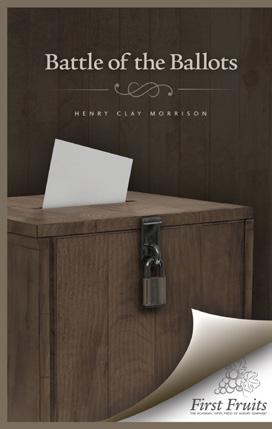
Under the auspices of B. L. Fisher Library, First Fruits Press is an online publishing arm of Asbury Theological Seminary. The goal is to make academic material freely available to scholars worldwide, and to share rare and valuable resources that would not otherwise be available for research. First Fruits publishes in five distinct areas: heritage materials, academic books, papers, books, and journals.
In the Journals section, back issues of The Asbury Journal will be digitized and so made available to a global audience. At the same time, we are excited to be working with several facultymembersondevelopingprofessional,peer-reviewed,onlinejournalsthatwouldbe made freely available.

Much of this endeavor is made possible by the recent gift of the Kabis III scanner, one of the best available. The scanner can produce more than 2,900 pages an hour and features a special book cradle that is specifically designed to protect rare and fragile materials. The materials it produces will be available in ebook format, easy to download and search.

First Fruits Press will enable the library to share scholarly resources throughout the world, provide faculty with a platform to share their own work and engage scholars without the difficulties often encountered by print publishing. All the material will be freely available for online users, while those who wish to purchase a print copy for their libraries will be able to do so. First Fruits Press is just one way the B. L. Fisher Library is fulfilling the global vision of Asbury Theological Seminary to spread scriptural holiness throughout the world.
asbury.to/firstfruits


 Dr. Z.T. Johnson
Dr. Z.T. Johnson


 By Z. T. JOHNSON, Ph.D., L.L.D., D.D.
By Z. T. JOHNSON, Ph.D., L.L.D., D.D.


 Z. T. JOHNSON
Z. T. JOHNSON







 This picture shows two of the larger tents that originally were used by the campers.
This picture shows two of the larger tents that originally were used by the campers.


























 The Board of Trustees at the December meeting held in Jackson in 1964. Notice that all but two of the members were present.
The Board of Trustees at the December meeting held in Jackson in 1964. Notice that all but two of the members were present.










 R. F. BURDEN
J. S. BETTS
REV ,J 1\1. GLENN
T l. THROWER
Rev. M. D. SMITH
Rev. G. W. MATHEWS
Rev. JNO. L. LOFTIS
\Lo
Rev. W. II. BUDD and Rev. It P. !\tYERS, E111er1t11"
C. D. flLPIAN
T. W. HICK.8
W S. DAVIS
R. F. BURDEN
J. S. BETTS
REV ,J 1\1. GLENN
T l. THROWER
Rev. M. D. SMITH
Rev. G. W. MATHEWS
Rev. JNO. L. LOFTIS
\Lo
Rev. W. II. BUDD and Rev. It P. !\tYERS, E111er1t11"
C. D. flLPIAN
T. W. HICK.8
W S. DAVIS

 W. M. SHEATS
M.A. CARNES
CHARLIE D. TILLMAN
Also THE GOSPEL QUARTET-
A. R. Walton, first tenor; M. B. Stroud, second tenor; E. L. Parham, first bass; Chas. Hackney, second bass.
W. M. SHEATS
M.A. CARNES
CHARLIE D. TILLMAN
Also THE GOSPEL QUARTET-
A. R. Walton, first tenor; M. B. Stroud, second tenor; E. L. Parham, first bass; Chas. Hackney, second bass.


 This picture was taken on the occasion of the mid-year meeting of the trustees of Indian Springs Camp Ground December 12, 1942. It was also the sixtieth anniversa~y of the wedding of Mr. and Mrs. F. C. Benson who are shown in the middle of the picture surrounded by trustees and friends.
This picture was taken on the occasion of the mid-year meeting of the trustees of Indian Springs Camp Ground December 12, 1942. It was also the sixtieth anniversa~y of the wedding of Mr. and Mrs. F. C. Benson who are shown in the middle of the picture surrounded by trustees and friends.



 Mr. and Mrs. Edwards standing in front of the beautiful front yard of keeper's cottage. This picture was taken in August, 1964.
Mr. and Mrs. Edwards standing in front of the beautiful front yard of keeper's cottage. This picture was taken in August, 1964.









 This picture shows the old hotel before the Lang Memorial Annex was built between it and the caretaker's cottage.
This picture shows the old hotel before the Lang Memorial Annex was built between it and the caretaker's cottage.






 This picture of the Benson Annex shows the Motel type of efficiency apartment building erected largely through the contributions and efforts of Dr. and Mrs. B. C. Gamble, in honor of Mr. and Mrs. F. C. Benson.
This picture of the Benson Annex shows the Motel type of efficiency apartment building erected largely through the contributions and efforts of Dr. and Mrs. B. C. Gamble, in honor of Mr. and Mrs. F. C. Benson.
































